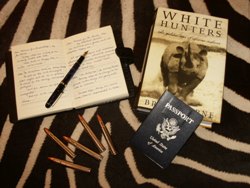

 The Accurate Reloading Forums
The Accurate Reloading Forums  THE ACCURATE RELOADING.COM FORUMS
THE ACCURATE RELOADING.COM FORUMS  Hunting
Hunting  Hunting Reports - Africa
Hunting Reports - Africa  Cameroon Adventure 2008 - Lord Derby Eland & Buffalo
Cameroon Adventure 2008 - Lord Derby Eland & BuffaloGo  | New  | Find  | Notify  | Tools  | Reply  |  |
| one of us |
HUNT SUMMARY Trip Dates: January 22 - February 7, 2008 Location of Hunt: Faro Region, Northern Cameroon, Bigoe Concession (Block Z18b) Animals Successfully Hunted: Class A (allowed one per Big Game license): - Lord Derby Eland: 116cm (45.7 inches); RW Min 114cm Class B (allowed one per Big Game license): - Northwestern Buffalo: 12-14 Year Old Dugga Boy Class C (allowed four per Big Game license): - Western Kob: 57cm (22.4 inches); RW Min 49.86cm (19.6 inches) - Harnessed Bushbuck: 24cm (9.4 inches); RW Min 29.84cm (11.75 inches) - Red Flanked Duiker: 7cm (2.8 inches); RW Min 6.35cm (2.5 inches) - Western Bush (Grimm's) Duiker: 10.5cm (4.1 inches); RW Min 8.58cm (3.4 inches) Other Game Seen: Elephant, Lion, Roan, Hippo, Crocodile, Hyena, Sing Sing Waterbuck, Western (Bubale) Hartebeest, Nigerian Bohor Reedbuck, Oribi, Bushpig, Warthog, Colobus Monkey, Vervet Monkey, Baboon, Jackal, Mongoose, Black Mamba (no Python or nocturnal animals seen but tracks were present) Outfitter Information: Guy Betaille Email: guybetaille@wanadoo.fr Website: http://www.the-wild-kingdom.com/index_eng.php Professional Hunter: Jean Malo Gueguen Travel Summary: Air France (Dulles to Paris) Booked via Expedia ($810 USD) Cameroon Air (Paris to Garoua, $1010 EURO) Booked via Mathias Michel, Iles & Voyages, iles.voyages@wanadoo.fr DISCLAIMER Please consider when reading this report that I am an optimist by nature, have previous hunting experience in Africa (this was my 10th trip), and that my experiences and perspectives may very likely differ from yours. Also note that conditions including the quality of the operator and concession hunted, as well as travel safety/security, are subject to change from the time of this writing. I would encourage anybody considering a savannah hunt to Northern Cameroon to contact me, and to talk at length with recent references so that you can form your own impression before making a decision to hunt in this area and/or with this particular outfitter. BACKGROUND I first began seriously considering a hunt to Central Africa (Cameroon or CAR) in 2003, after reading one of Harold Wolf's Hatari Times focused on Northern Cameroon (Edition #15, available at http://www.hataritimes.com/en/alte.php). Based on Harold's article, my first email correspondence was with Guy Betaille in November of 2003. Since then I have spoken to numerous references, booking agents, outfitters and others who hunted these areas for Lord Derby Eland, Bongo, or both. The more people I spoke to, the clearer is was that for my first (and possibly only) hunt to this part of Africa, the savannah was a better choice then the jungle (Bongo). I love to track my game, and my best hunting experiences have been on foot in pursuit of elephant in Zimbabwe, lion and roan in the Caprivi, and buffalo in the Selous and Luangwa Valley. Those who had done both types of hunts (savannah and jungle) concurred that while the bongo is a magnificent trophy, the Lord Derby eland (LDE) is a more rewarding hunt largely due to the physical effort that is required. Plus, one can expect to take other game on a savannah hunt, whereas in the jungle you are lucky to get the bongo plus maybe a duiker or two, and anything else is a bonus. I never actually thought that I would be able to afford [justify] what had become my "Dream Hunt". Cameroon became a reality oddly enough when in March of 2007 on a hunt in Zimbabwe, I failed to shoot a PAC/meat elephant, and declined several trophy bulls as I was looking for something in the ~60lb+ range. I quickly decided to allocate the money I had set aside for the elephant trophy fees towards the Lord Derby Eland hunt. As we have seen, prices are going up everywhere, and I figured that I better do it while I could (due to the devaluation of the Dollar against the Euro, which the hunts are priced in, this trip ended up costing me more then I had originally planned. BUT after I booked the significant increases in Tanzania actually made this hunt seem like a pretty darn good value). Based on my communications with Guy Betaille, and thanks to the help of my friend in France (JB) who assisted with communications, it was a pretty easy decision when Guy offered me a prime date for 2008. Guy and I more or less agreed to the hunt on a "handshake", and if it were not for his strong reputation among French and other European hunters, and my fairly long history of communications with him, I would have had serious reservations. Deposit money was sent and travel plans were made. TRAINING & CONDITIONING Cutting to the chase, the French view Americans as being "fat, lazy, loud and unrefined". The more I learned about the outfitters and PH's operating in Central Africa, the more intrigued and offended by this stereotype I became. So not only did I want to hunt with a French outfit who adheres to the traditional tracking methods, but I wanted to arrive in the best condition of my life and show them that they should not be so quick to judge us-Americans. If I was going to suffer - by God so was my French PH. Silly I know, but it served as a great training motivation. My training was primarily intended to continue to improve my endurance and recoverability (in my opinion, one's ability to recover after a long day is crucial to success on what could be an extended physical hunt - many of us can bust for a few days, but the ability to go hard for 10-14 consecutive days is a different matter). My routine consisted of weight lifting for the upper body plus brisk hiking and hill climbing with a ~25lb backpack 2-3 times a week including on subsequent days (Sat, Sun, Wed for example). Outdoor training Nov-Jan is a bit of a struggle, as the days are short and the weather in Pennsylvania can be poor. However, the benefit is that I remained active and watched my diet closely over the extended holiday season, and did not pack on any winter pounds. As the years progress, injury prevention becomes more and more important, and at a certain point just treading water is an accomplishment in and of itself. Knees and hips do not last forever, and I have found that it can be easy to overdo it. Lighter weights and higher reps for certain exercises, strict form and a lot of stretching has been beneficial, as is consistency, good nutrition and "clean living". A bit OCD, but to keep on track I record all foods eaten and calories consumed, and make sure that I get enough protein, complex carbs and healthy fats each and every day. Supplements include a multi-vitamin, fish oil, and glucosamine. It all worked well, as despite hunting with a 28 year old PH, I always had more then enough gas in the tank for whatever was required. THE FRENCH CONNECTION Cameroon, like other countries in western and central Africa, is a former French colony. The outfitters are mostly all from France, and the predominant language spoken is French. Few Americans hunt this part of Africa, although there are some excellent booking agents representing outfitters who cater to the "unique needs" of typical American hunters. I decided early on that if I was going to hunt in French Africa, to get the most out of the experience, I wanted to see it from a Frenchman's perspective. And in doing so, I though perhaps the Lord Derby would have even more significance to me, if that makes sense. That is, there had to be a reason why the European hunters hold the LDE in such high esteem, and I wanted to find out why. Too, I personally was not interested in air conditioned bungalows or hunts designed to minimize the physical effort involved, although I fully understand why somebody would opt for this especially if hunting later in the season, or with their spouse. My main reservation with this hunt was my inability to speak or understand any French, considering that I would be traveling and hunting solo. I had every intention of learning some of the language, as even a few token phrases is said to demonstrate effort on a foreigners part, which in turn makes them more comfortable speaking what English they know (in my experience most know more then they let on, or at least are willing to use). However, the months slipped by, and I never got much beyond "Bonjour monsieur". Guy was to be in camp, and speaks pretty good English, so when I got a few months out I figured I would just wing it both at camp and during travel. Had I it to do over, I would dedicate myself to learning some simple French including phrases used while hunting (to locate a specific animal among a herd, for example), and at the dinner table. It is also worth noting that while in the US we think in terms of inches, degrees Fahrenheit and miles, the rest of the world uses the metric system. Knowing simple conversions is useful, including respectful and book (Rowland Ward) measurements in centimeters for the animals that one is hunting. Oh, yea, practice the "Double Kiss" too! In the end I discovered the French to be warm, helpful, engaging, efficient, and a delight to be around. The generosity and hospitality offered me before and during my hunt equals and perhaps surpasses that of any of my prior experiences, which is saying something as over the years I have had the privilege to spend time with some wonderful people. I would like to think that I helped redefine their impression of Americans too, at least the "fat, lazy and loud" parts anyway - somebody else can handle the "refined" aspect! SITE-SEEING PARIS I flew from Dulles (Washington DC) to Paris on the Air France/Delta redeye, and arrived in Paris +6hrs around noon on Tuesday the 22nd. Formalities at the Charles de Gaulle airport were a breeze, and in fact there was no Customs check or forms to complete..grab your bags and go! I did not have a rifle, but as others on the forum have experienced, I would assume the process to be quick and efficient. I was met outside the baggage claim by JB and his wife, plus Erik who was down from Norway to hunt pigs with JB. We dropped off the bags at a local hotel, and made the short drive to the city. We spent the day walking the streets of Paris, and although I am sure it is prettier in the spring, the temperatures were mild and weather just about perfect. It has been written that the people one passes on the streets in Paris are a bit snobby, and while they do not make casual eye contact or conversation, nobody I encountered was rude...and the girls sure are cute! When engaged, they were friendly and sincere. While at the Penn State book store, I picked up a used copy of "Culture Shock! A Survival Guide to Customs and Etiquette - France". Intended for long-term visitors, students and workers, it provided excellent insight into the French way of life as compared to that in America. 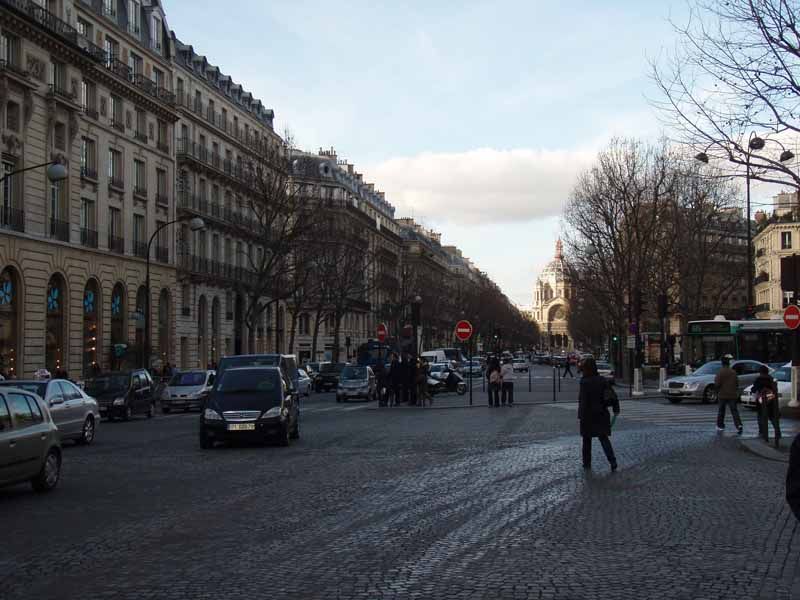 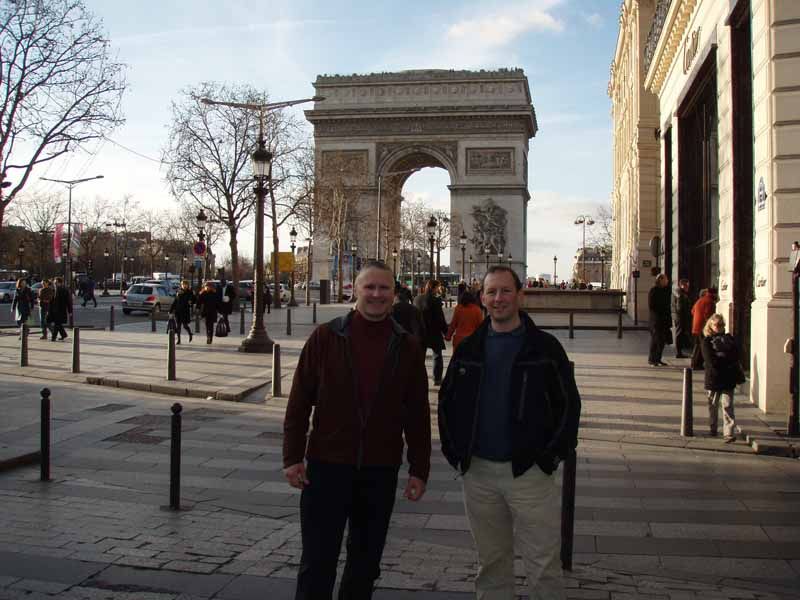 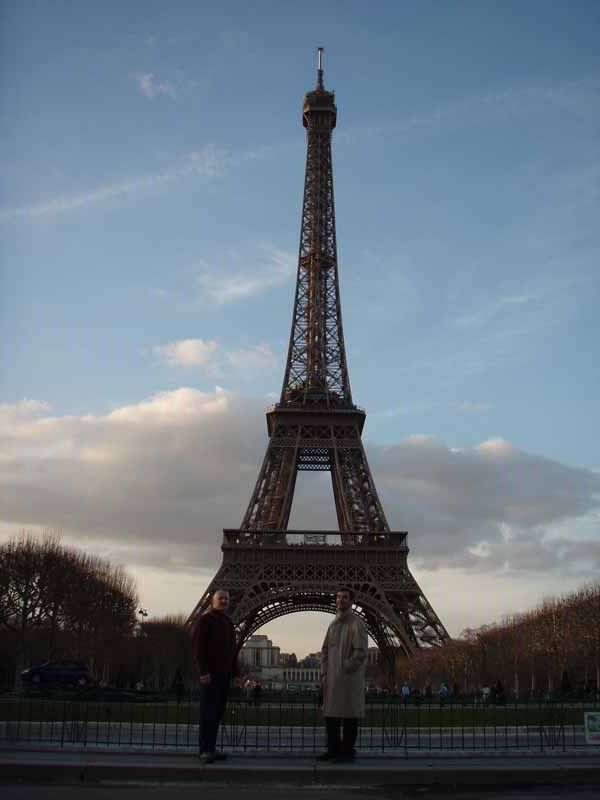 The streets really came alive after 5pm, and Paris is truly a walking city (well, that and the subways). In the evening, we met up with Bill (Wink) and his wonderful wife, and enjoyed a nice dinner and drinks. This was a terrific way to start a safari, and in fact I was looking forward to this almost as much as the trip itself. I would encourage anybody traveling through Paris - or other marquee European city for that matter - to spend at least a day there. Not only does break up the flights, but you already paid to fly there, you might as well make the most of it. JB and his wife Marie were wonderful hosts, and I greatly appreciate their generosity and kindness, and hope to be able to repay them one day. 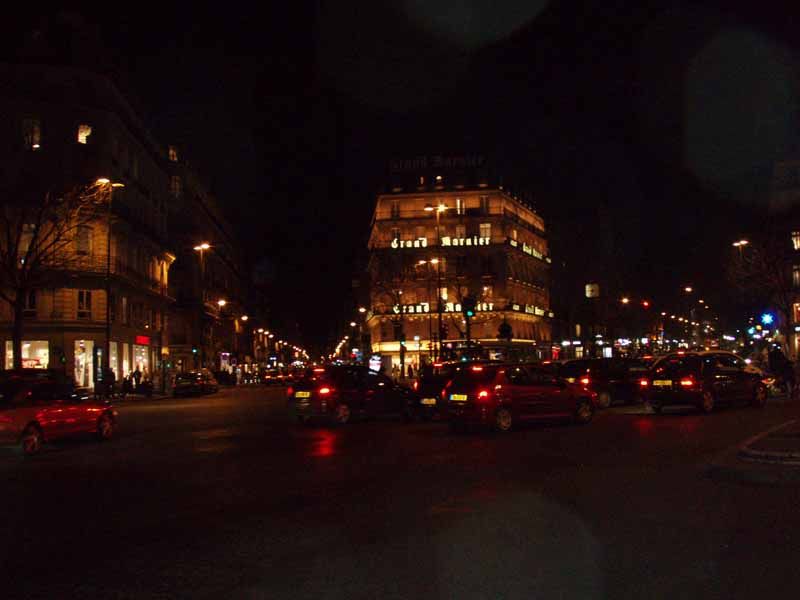  Counterclockwise: Wink, JB, Laurence (Wink's wife) and the starry-eyed American: 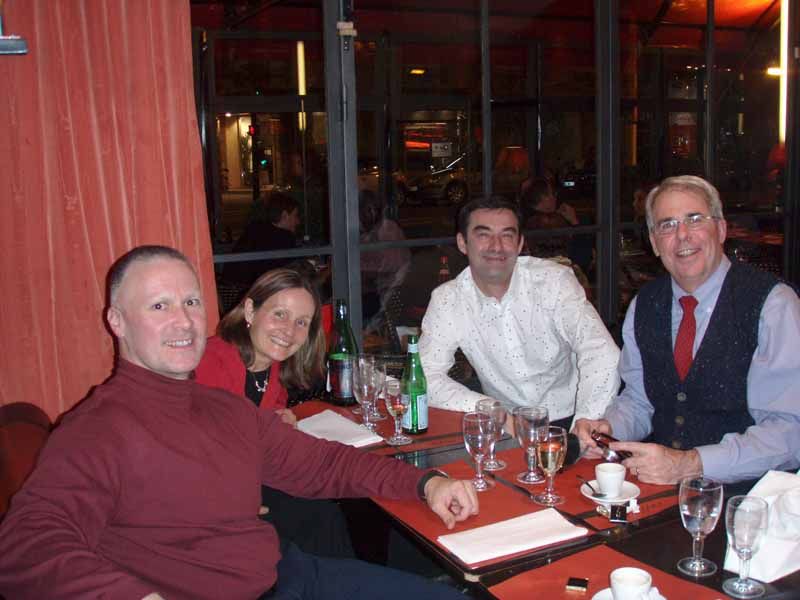 Left to Right: JB, Wink, Laurence & JB's wife Marie: 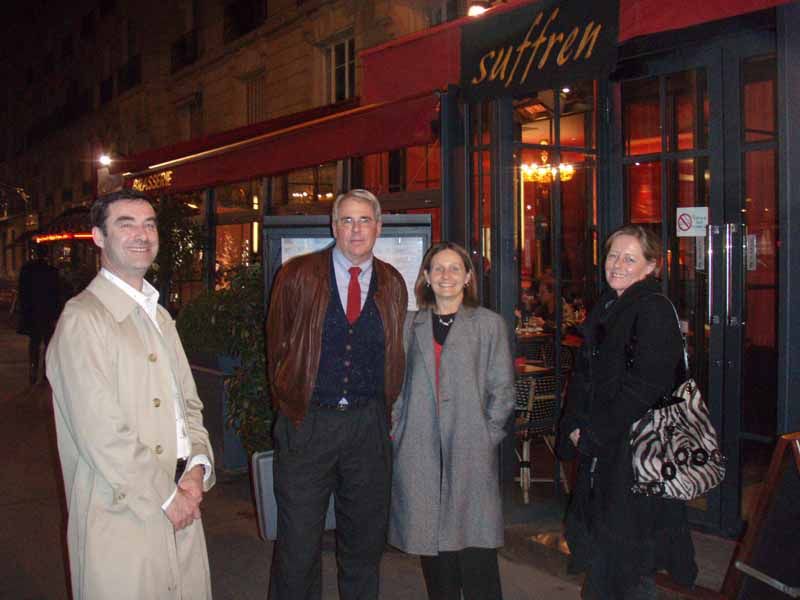 TRAVEL TO GAROUA, CAMEROON The next morning JB took me to the Air Cameroon counter where I confirmed my flight (I did not realize how fortunate this was until later in the trip) direct to Garoua, Cameroon. During the safari season, CamAir alters their flight schedule once a week (Wednesdays, at least this year) to fly direct from Paris to Garoua, the starting point for the savannah safaris in the northern part of Cameroon. This is only a ~6hr flight, so total in-air time from DC to Garoua was just 13 hours. On the return trip, however, it is not quite so pleasant as delays should be expected and the big Boeing 767 touches down in Yaounde (the launching point for the jungle safaris) before a 3-5hr layover in Douala. However, one can check their bags in Garoua all the way to Paris (note regarding luggage, I had no problems on any my flights and had nothing taken from either of my unlocked bags noting cameras, phones, etc were in my carry-on). I would guess this modified schedule is subject to change year to year, and as I saw on the way back, CamAir is not the most reliable of airlines (of the original fleet of six 767's, they are down to two). It is possible that if one is delayed on the flight in, and/or has to make alternate arrangements, hunting days could be lost. Or in my case, I had two days added as it was the return flight that was postponed. Nevertheless, it represents a viable and cost-effective option. The other popular option, particularly among US hunters, is to fly Air France to Douala, overnight, then charter direct to camp. There is one other airlines that flies from Garoua to Douala (Elisan), but I think this would be a last resort.  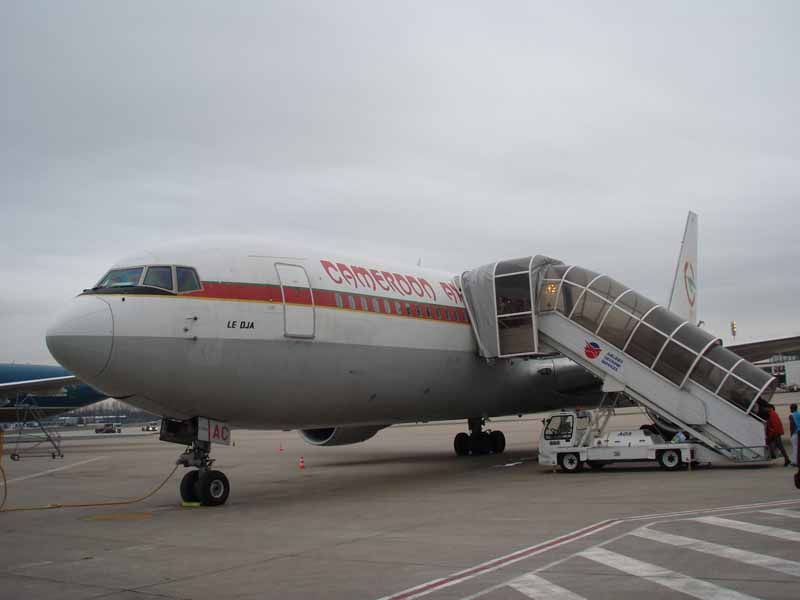 GAROUA The flight was uneventful and I slept most of the way. One always meets interesting and/or unusual [weird] people when traveling, and mine was a tall, lanky German scientist/professor who was going to Cameroon to study the Black Fly larvae that infect both animals and people. It seems that there is no cure, and after a few too many bites, the larvae cause blindness. Interesting yes, but not what I wanted to hear on my way into the bush. Many empty seats - there were only about 40 passengers on the big Boeing 767 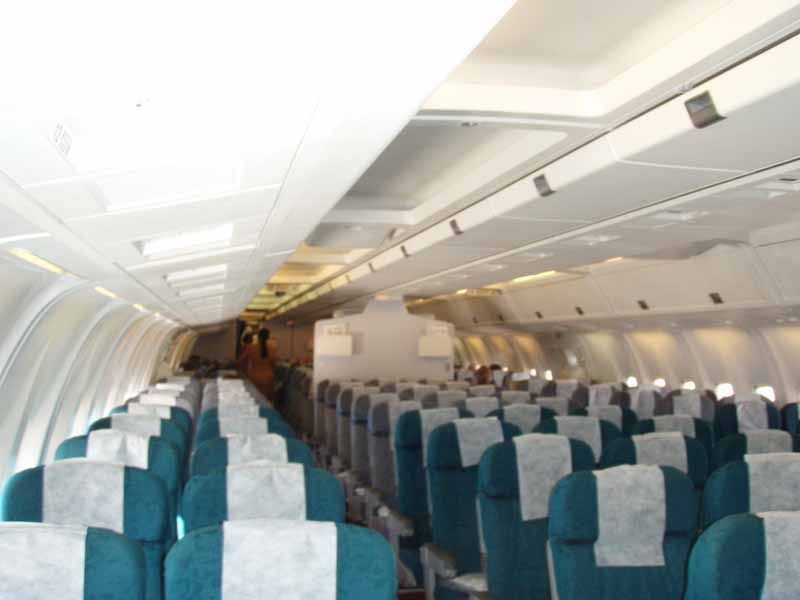  Also on the plane was Pierre Favier and his wife Claire. Pierre introduced himself as Guy's friend stating that he would be in camp to help translate and make sure that things go smoothly with my safari, as Guy had torn cartilage in his knee on a prior hunt and was headed back to Paris to see a doctor. While I had not requested that I hunt with Guy, I did expect him to at least be in camp. The last time I got "news" concerning my hunt was on my Dall sheep backpack hunt when the outfitter informed me in the airport that I was not hunting 1x1 backpack as planned, but 2x2 from a horse camp (I DID enjoy myself immensely on the trip). After this, I vowed that moving forward, I was not going to react as mildly next time to information that could [should] have been provided BEFORE I boarded the plane. But I was cool here as there was no reason to be alarmed, and as it turned out, Guy's contingency plan was excellent. Yet just once, I would like to be greeted with "Hey, guess what, I have great news, you won't believe this but.." I would have liked to share a camp and hunt with Guy (pronounced "Gee") as it was his "passion" and "hunting ethics" that originally attracted me to his company in the first place. Perhaps next time, if indeed I am able to return. In some ways not having the boss-man in camp can create a more relaxed atmosphere, and he was in almost daily contact via satellite phone with Malo (my PH) and myself. As I was to find out, Malo was more then capable of running the show, and the staff was top notch and in fact the best trained I have ever experienced. This all speaks well of Guy Betaille, who according to the people there, runs a tight ship and expects a lot out of his staff. Thanks to a 2hr delay leaving Paris (the plane from Douala was late), we arrived at the Garoua airport at 4:30pm. Garoua-proper with maybe 300,000 residents (99%+ local/black Africans) is far from a large city, and it is quite surprising that it hosts an International Airport.  It was too late in the day to make the approximate 5hr drive into camp (sunset is a consistent 6:00 - 6:15pm throughout the year given Cameroon's proximity to the equator). I was concerned that I was loosing a hunting day, however, it turned out fine and I got to experience more of Cameroon then I otherwise would have. We had dinner and overnight'ed at the Saint Hubert hotel, which Pierre said in the 1970's was quite the destination among European big game hunters. But like the rest of Africa in the post-colonial era, although decent, it is a far cry from its former self. 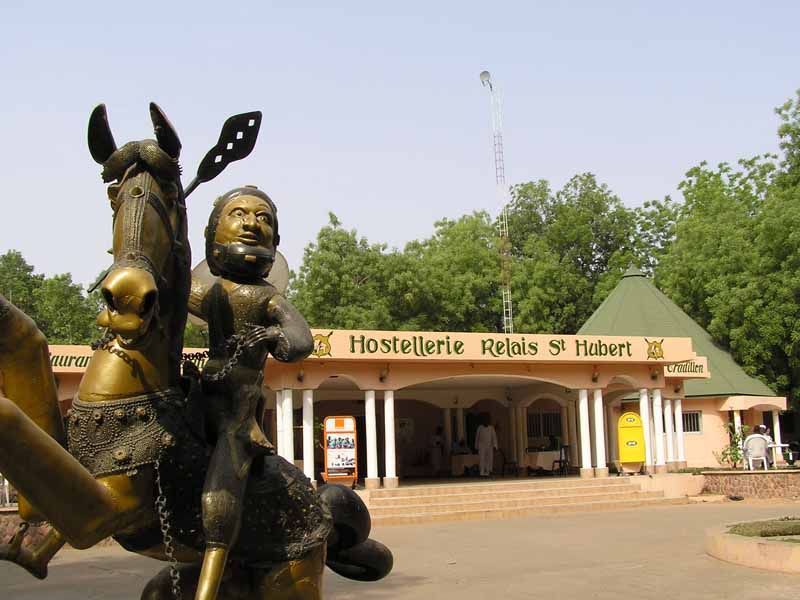 The next morning (1/24), Pierre, Claire and I had a leisurely breakfast then crossed the street to walk the Garoua market. I have been to a few other African markets before, but have never seen anything like this. This is not a tourist market, but one run by locals for locals. It is dirty, frantic, chaotic, and uniquely African. Guy's man on the ground in Garoua, Robert, purchased produce and other supplies for camp while we walked around and took in the sites. The open market in Garoua, Cameroon:  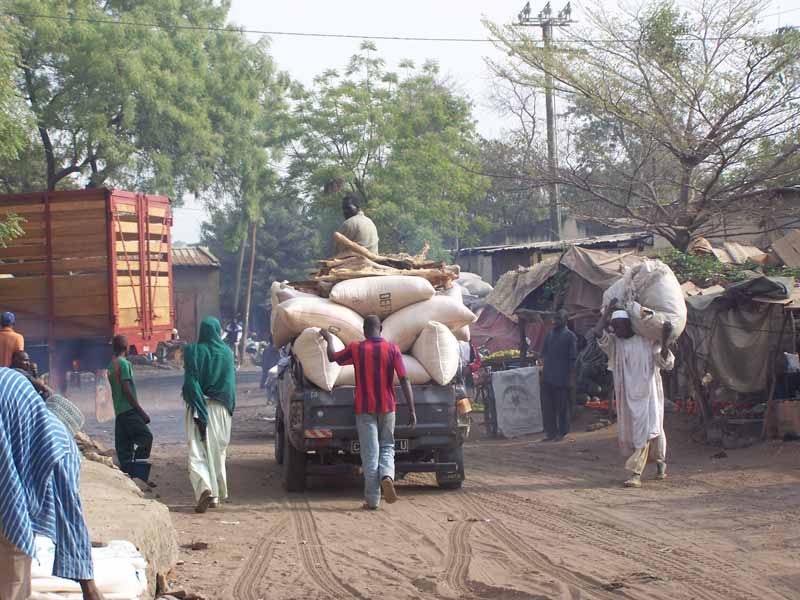 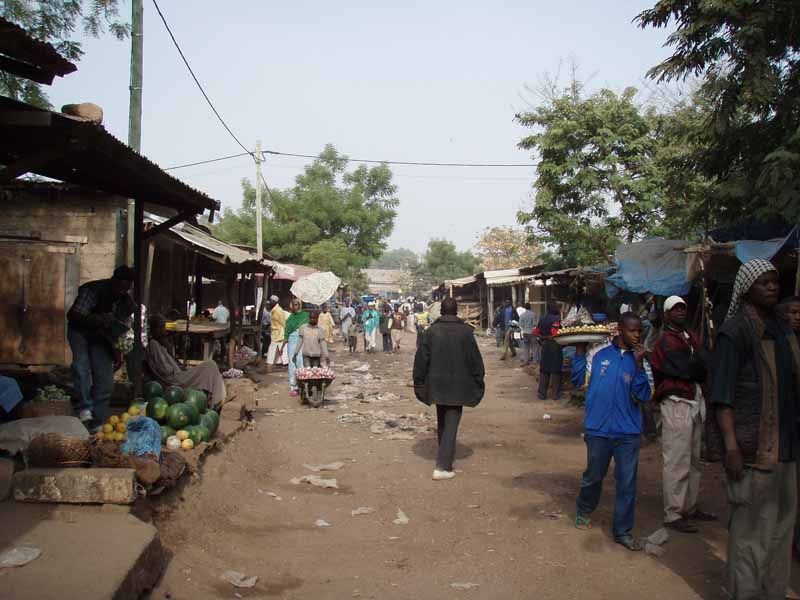 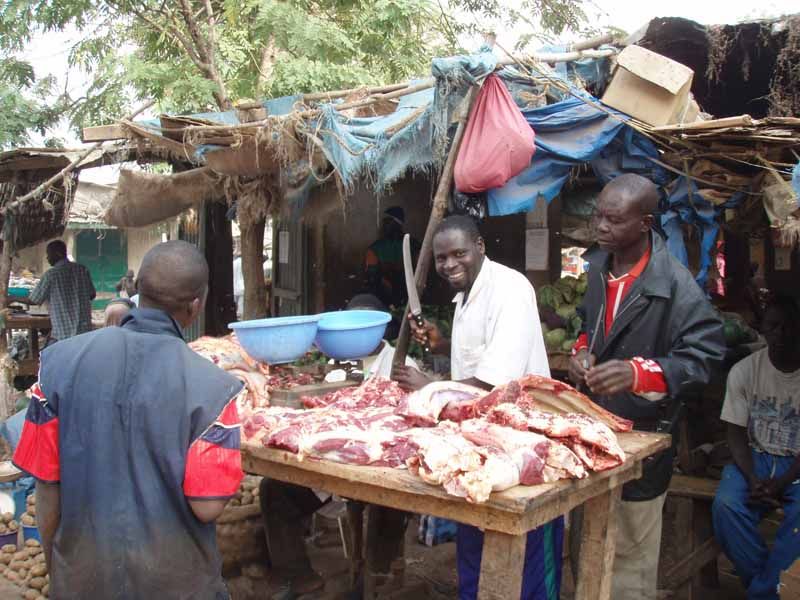 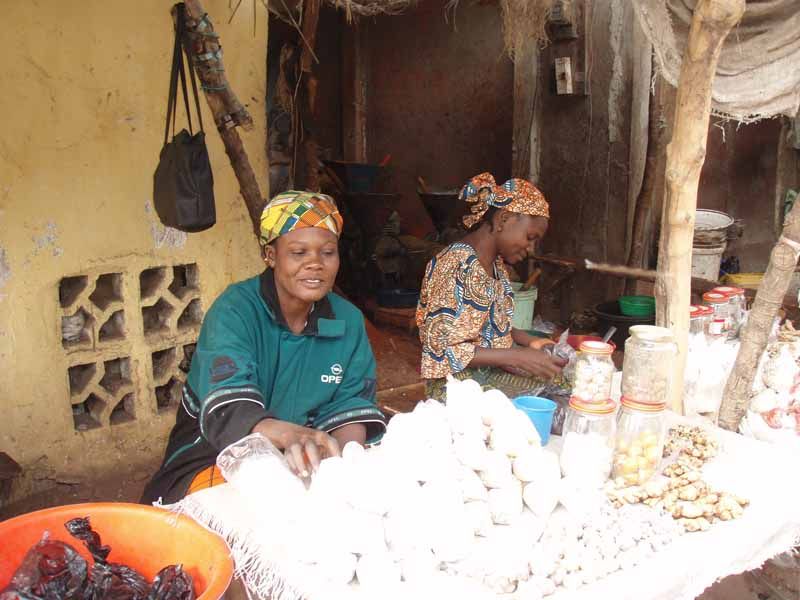 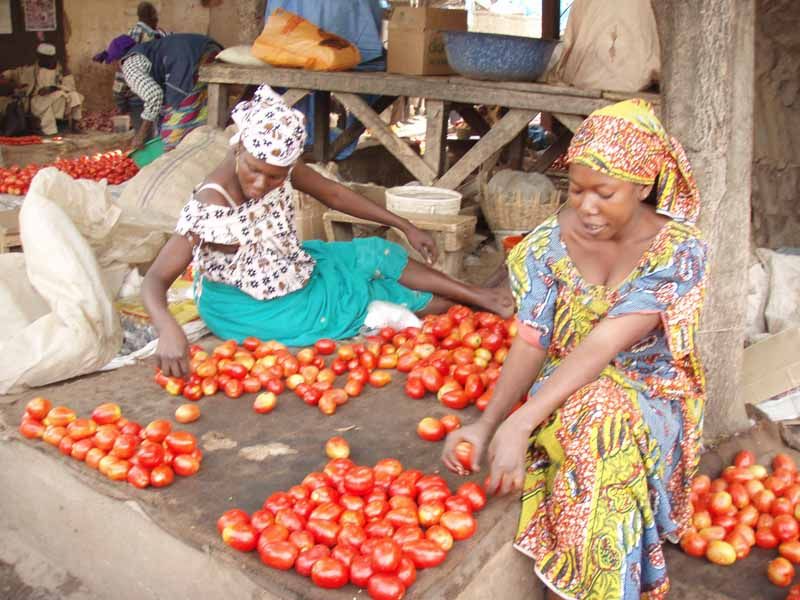 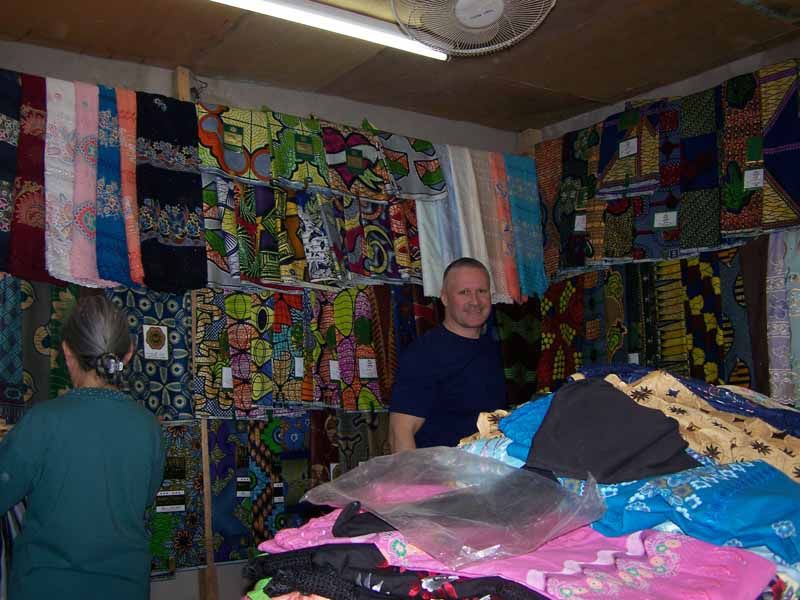 Following Robert on our way to get my final paperwork : 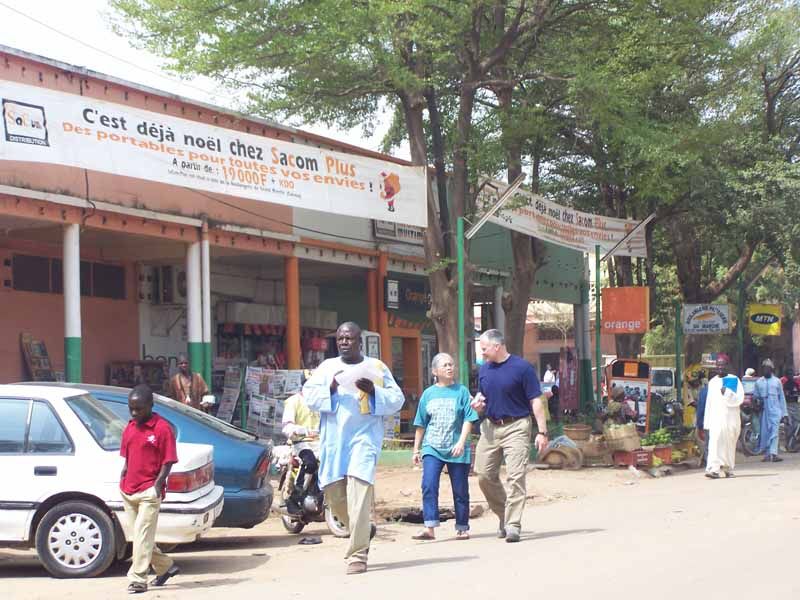 Many (most?) people in Cameroon are Muslim, and some of the women especially do not like their picture taken. So there are two options: (1) ask permission, get yelled at in a foreign language, and not get the picture, or (2) take the picture, get yelled at in a foreign language, and get the picture. I used both methods, and found the second to be more productive. TRAVEL TO CAMP Once packed up, we made a few more stops for supplies (including rice "just in case") and to get my picture taken for the hunting license, before heading south on a tar road then west on a dirt track into the Faro National Park area. The ride was long (5 hours + stops), but enjoyable, and Pierre and I both share an enthusiasm for all the subtle things that make a safari interesting. Garoua Main Street scenes: 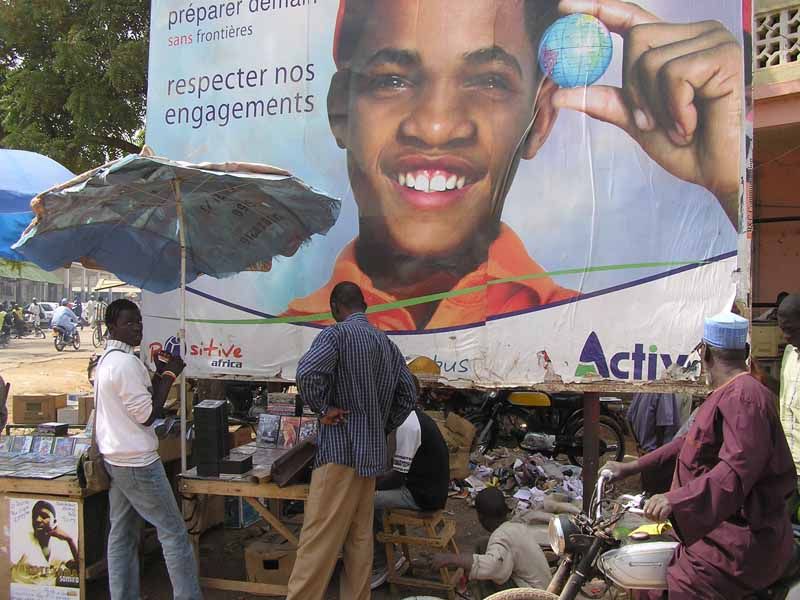 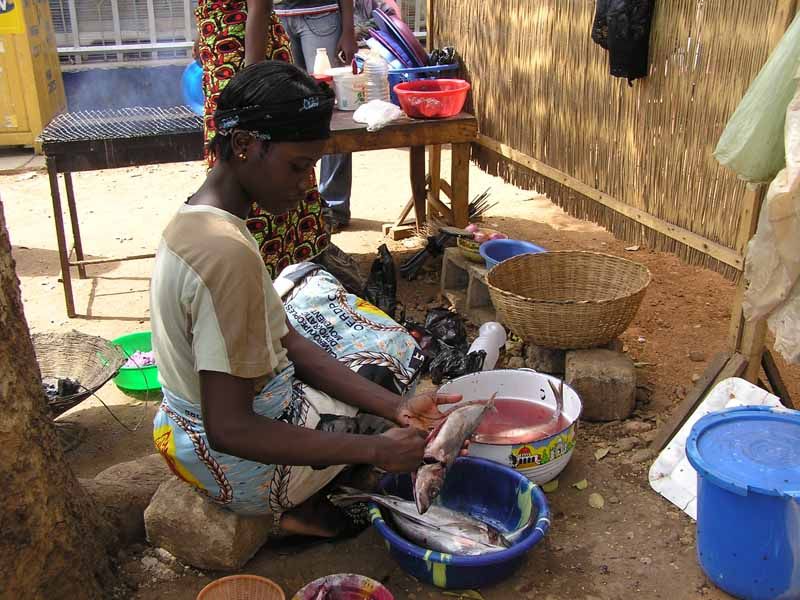 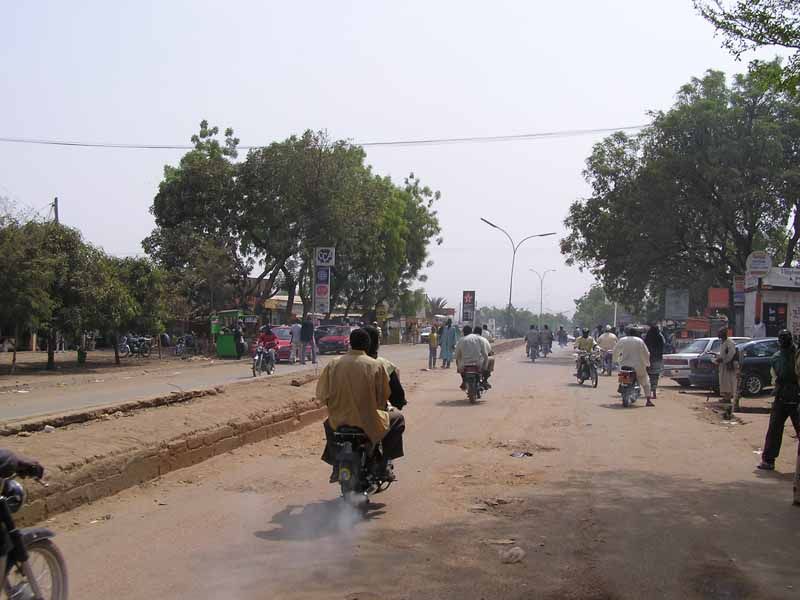 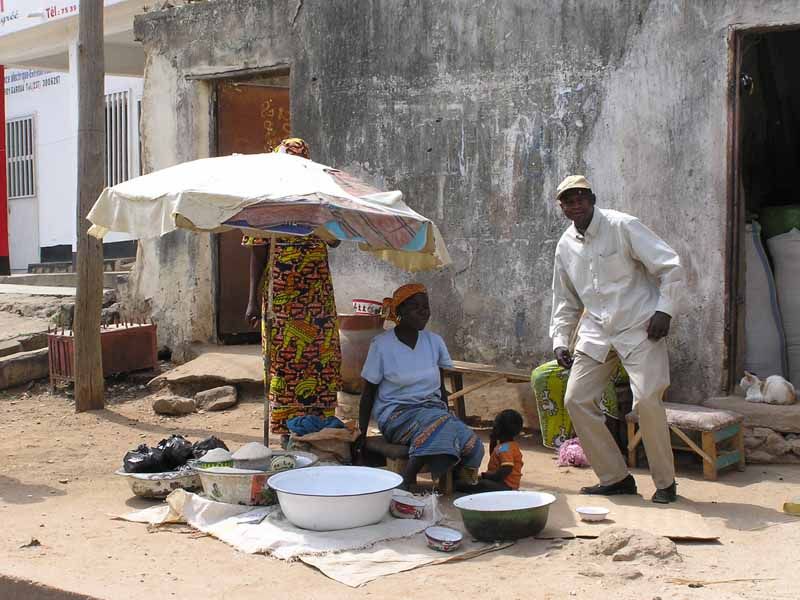  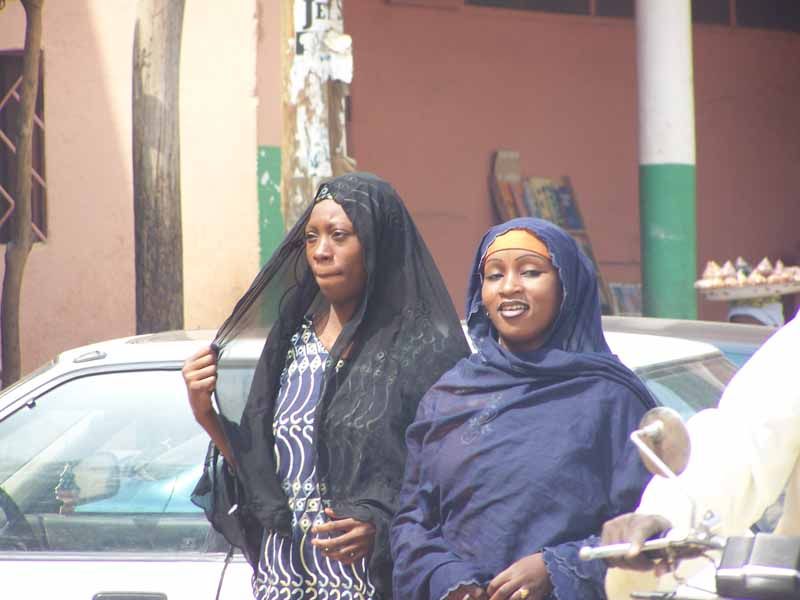 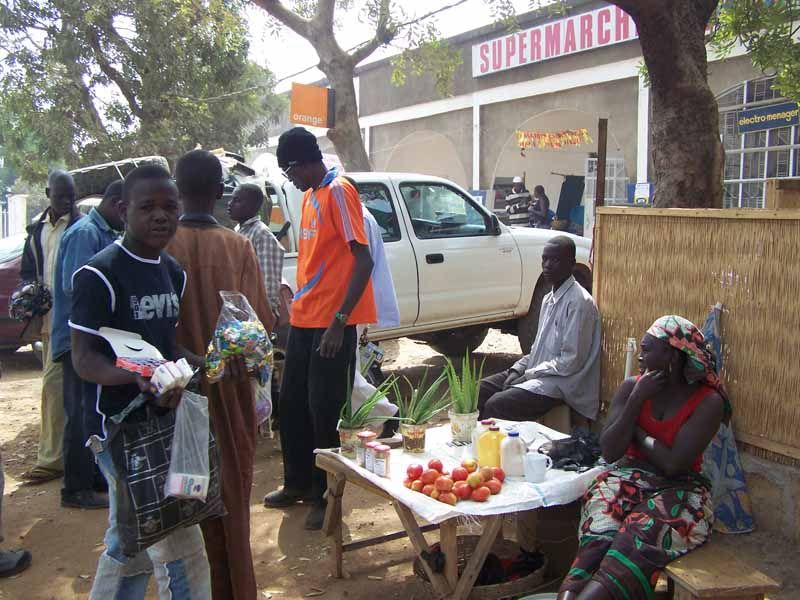 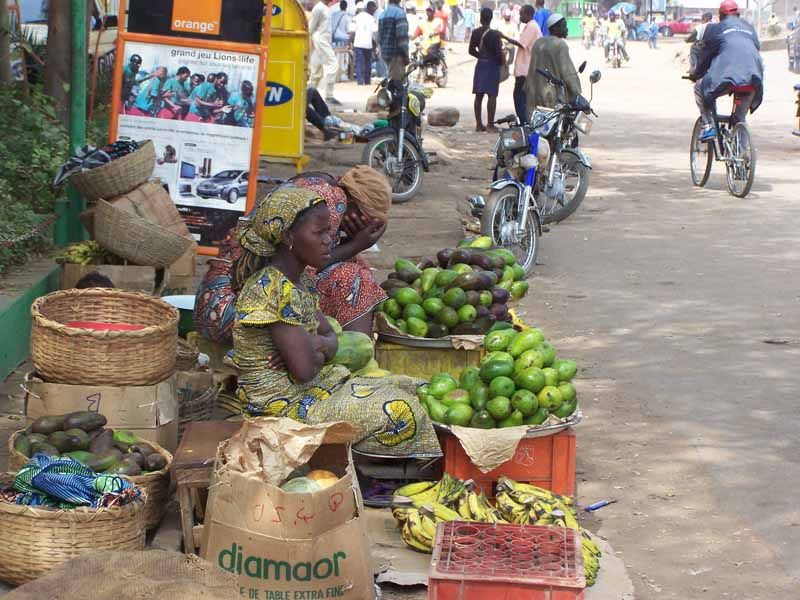 Leaving Garoua, note the taxi drivers on the motorcycles wearing yellow vests - this seems to be a primary means of local transport:  On the way, my driver Jean asked if it was okay that we stopped by his Christian family's home. I thought this was a great idea to stretch the legs, and see what life is like among the locals. Here we met Jean's wife (he has another Muslim wife in the city) and five children (plus three with his second family). This was not a traditional rural African village, but appeared to be a more modern version, more of a compound with an outside wall containing several huts for the extended family...sort of an African version of the suburbs. Everyone was polite and friendly, and I suspect that they see Pop quite often as he couriers hunters and supplies to/from camp. A few of Jean's children (more pictures are near the end of the report): 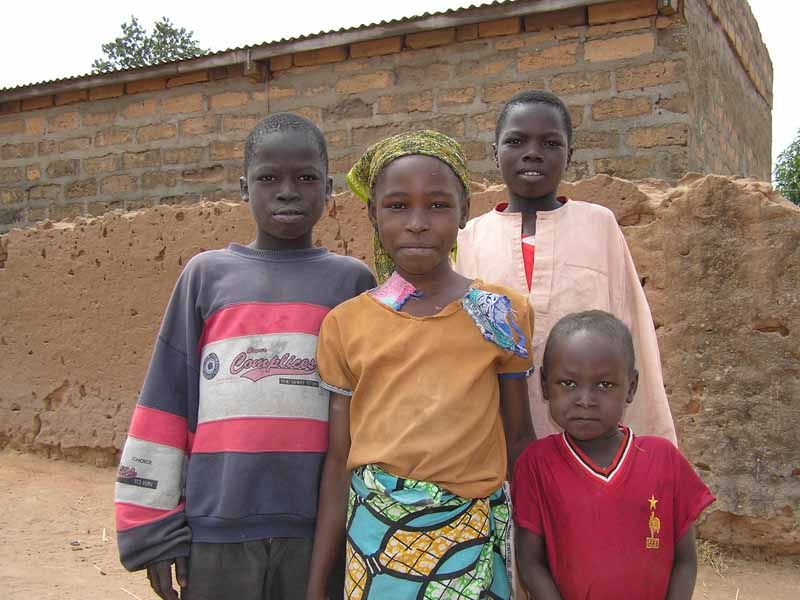 Typical villages passed on the journey to camp:  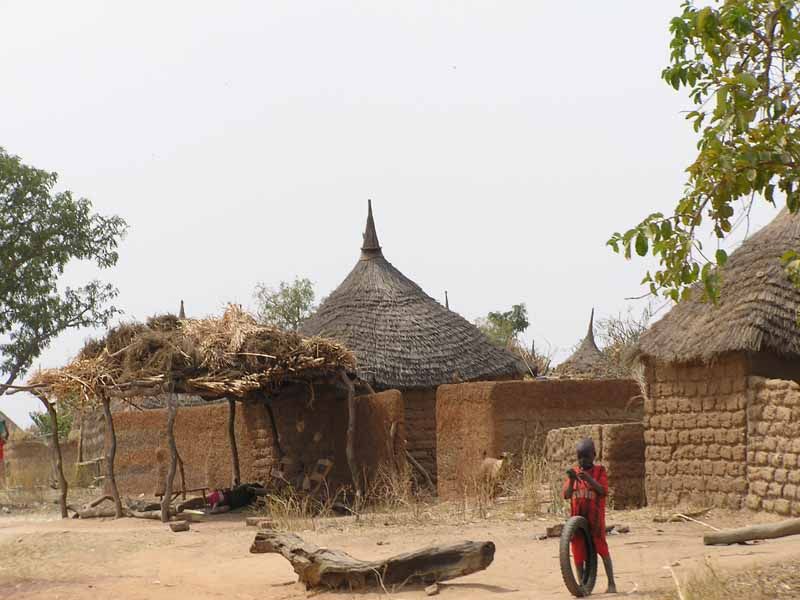 Securing the load on the Toyota Hilux:  Lunch at a village restaurant - note the satellite TV tuned to International News...the world is getting smaller: 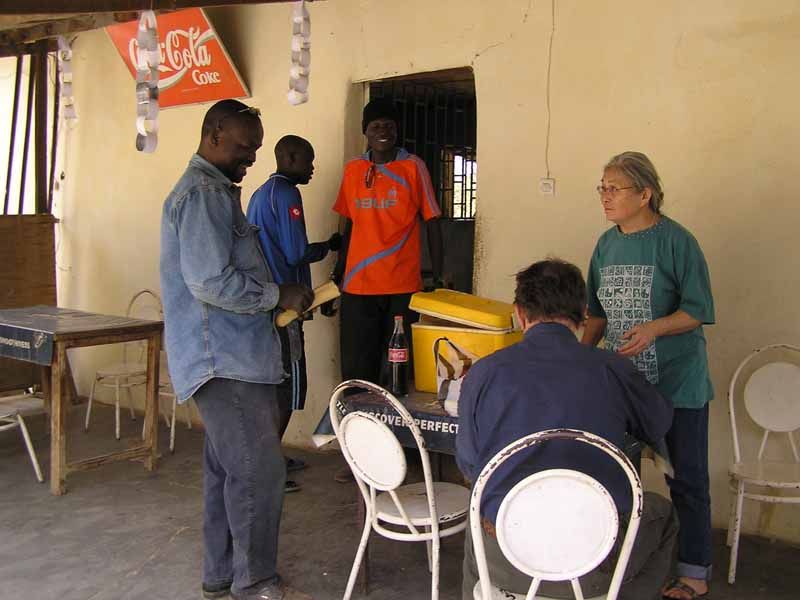 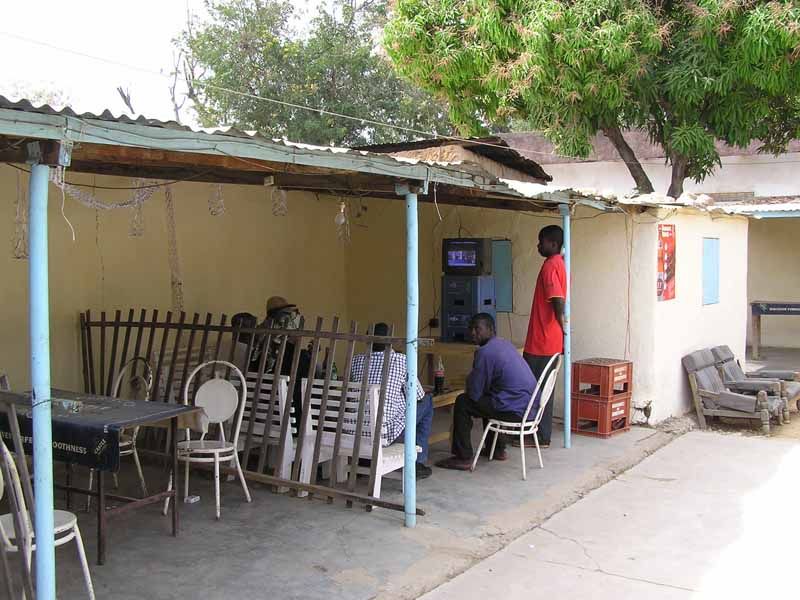 About 10K's (6 miles) from camp, we encountered a group of cattle herders called "Bororos" with what must have been a thousand head of cattle. They told us that they were taking their cattle to Nigeria, which is was only 30K's (20 miles) away, as marauding groups of Cameroonians had been stealing them. Although they had not entered the hunting area, this is of course a good thing as with the cattle comes over-grazing and disease. And with the Bororos comes poaching. Bororos (cattle herders) heading to Nigeria: 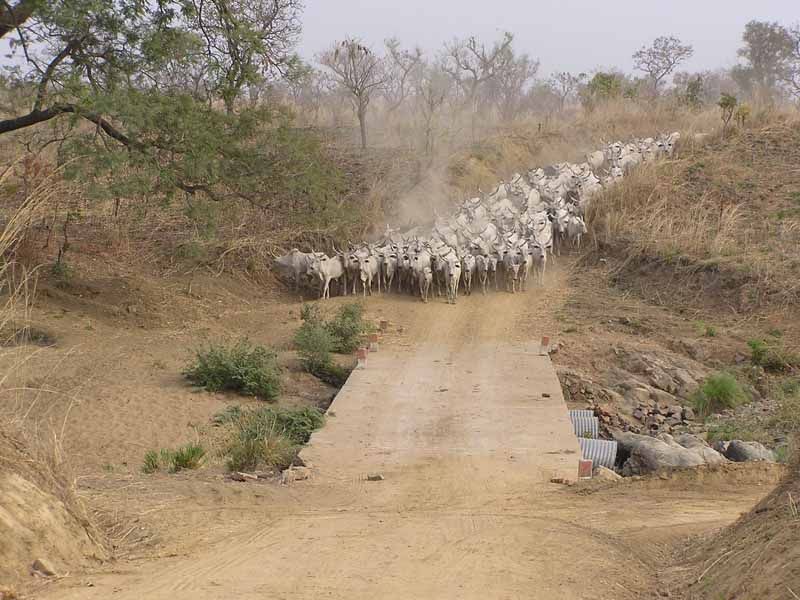 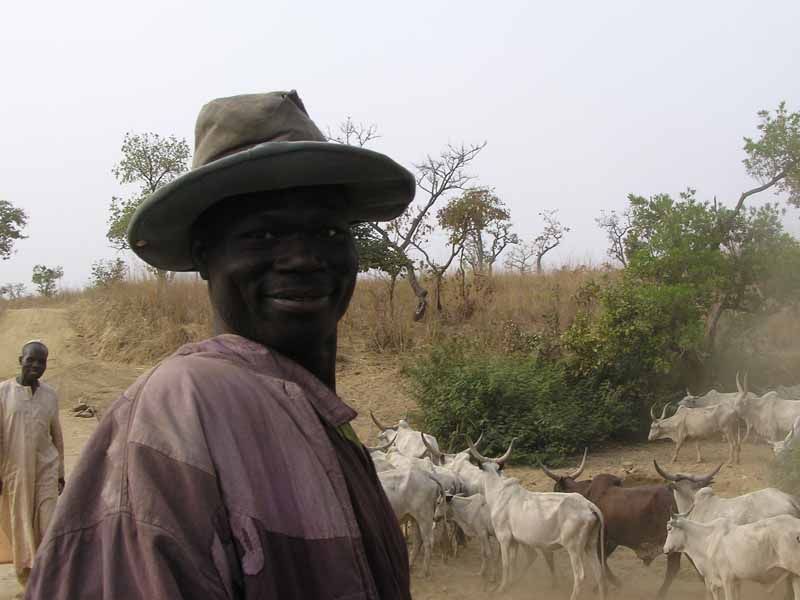 HUNTING CONCESSION The Bigoe concession (hunting block Z18b), is some 120,000 hectares (300,000 acres) in size which is quite large especially by Cameroon standards. Guy Betaille has operated in this area for the past 13-years. One of the reasons why the concession, said to be one of the best in Northern Cameroon, is so good is that it is bordered on all sides by natural barriers that work to curb commercial poaching. According to Malo, poaching by the villagers does not represent a significant threat to the game populations, especially the larger species. Yes they might take a kob here and there, but they hunt only to eat. However, commercial poaching (the meat trade), and in particular that which occurs during the off-season months, can have a dramatic impact on game quantities over a relatively short period of time.  Each year, Malo said he has seen the "buffer zones" surrounding the concession under ever increasing pressure. This includes the Faro National Park on the western boarder of Bigoe. To the north (and civilization) is the Faro River, which becomes virtually impassable in the rainy season beginning in April. Bigoe's long eastern boarder is shared by Pierre Guerrini's concession (Faro West), who is also said to also be diligent when it comes to anti-poaching. To the south are high mountain ranges. Even so, Guy maintains a strict anti-poaching program, which last year was headed up by Malo himself who stayed in camp 3 months after the close of the season. The primary threat to well-managed concessions like this is the possibility that at some point when the lease comes up for renewal, they are "awarded" to local politically-connected individuals who care little about the animals and are only interested in exploiting the resources. When this happens, commercial poaching takes over. Even now in some areas, poachers who are caught and turned in to the police are back at it within days, as the officials processing them are on the take or involved in the meat trade themselves. I wish all anti-hunters could see this firsthand and truly understand the big picture, as they would realize we are all fighting the same, seemingly loosing, battle. Guy comes from a wealthy background and is successful in other aspects of his life, he does not need the revenue generated by the safari industry to survive but does so as he loves hunting and cares about the land, the local people, and the animals. Something else unique about Bigoe as I was told is that unlike other areas, it contains ample quantities of all the game available on a hunting license, whereas some blocks have either been over-shot or are managed for just the Lord Derby eland. The exceptions to this are elephant and waterbuck, which per Malo have been increasing in numbers over the past five years or so. Betaille runs a rather exclusive operation, and during my planning stages and when on the ground, I could not help but to feel privileged to be hunting it. Passing briefly thru the Faro National Park before entering the hunting concession & camp: 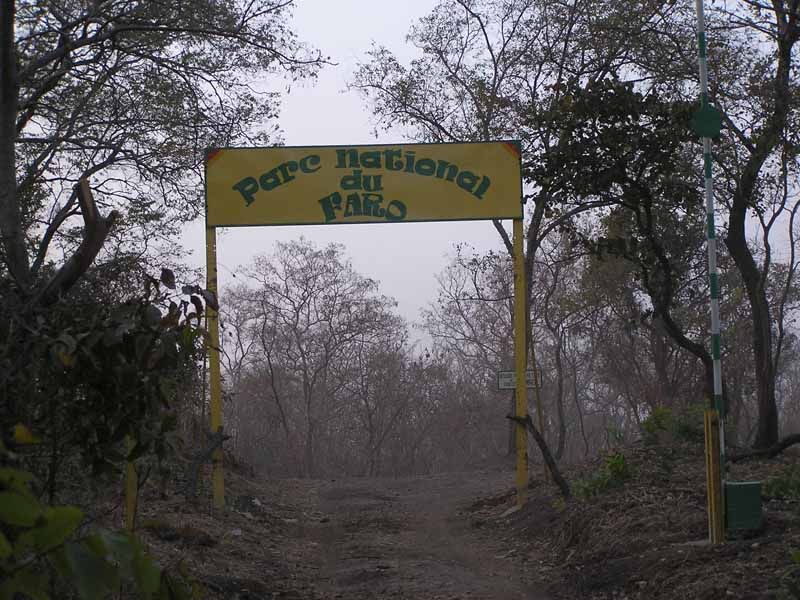 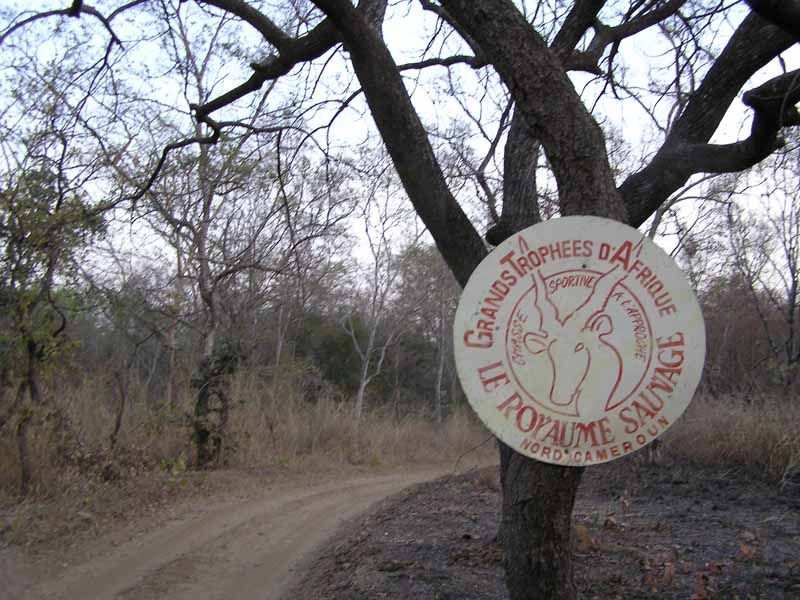 THE CAMP Guy's camp is located along the Faro River, which flows clean all year long. Although there is water throughout the concession, the River attracts animals and many of the pictures below were taken from camp. At night, I heard hippo, lion, hyena, colobus monkey and a host of other birds and critters. Each afternoon, from the dining area overlooking the Faro we could watch kob, hippo, monkey, baboon, fishing birds and even lion. The sleeping and kitchen rondavels are roomy and comfortable permanent structures. There are no en suite bathrooms, but instead the six guest rondavels are arranged around a bath house, and each has their own separate bathroom with a flush toilet and "tank water temperature" shower. Mine was only a few steps from my door, but given the late dinners I did find that I needed to make the short run each night. The benefit is that there is no odd smell or critters running around the sleeping area. The hot showers are outdoor and typical South/East African and perfectly adequate, I actually enjoy this type of arrangement. This is Africa after all!    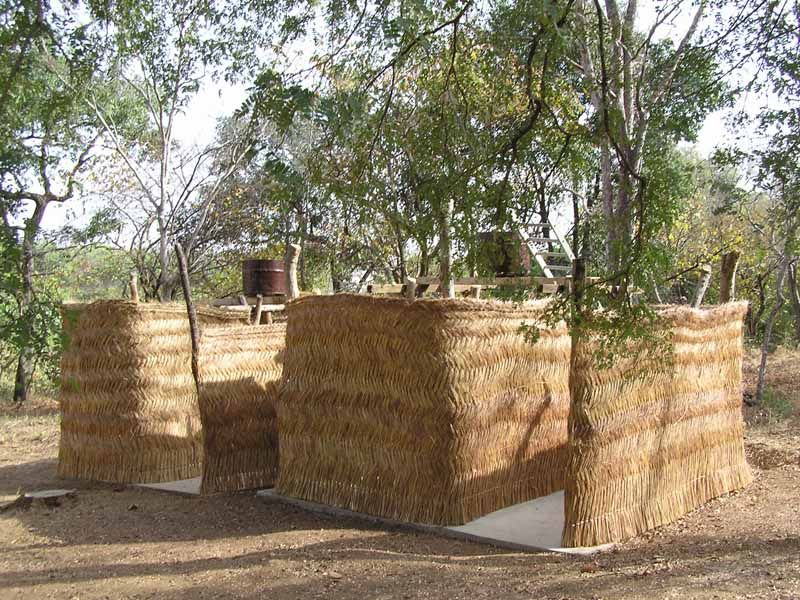 Malo asked when I arrived if I needed the generator, to which I replied that I had brought nothing that required power that I could not recharge using the DC adapter (lighter) in the Cruiser - these included adapters for the AA batteries for the larger camera, satellite phone and iPod. This pleased him as they too do not like the noise and smell of a generator, and of course this conserves fuel. I brought two headlamps but only used the compact Tikka Petzel XP as this was more then adequate, and each evening we were provided with a solar charged battery lantern. In addition, gas lanterns were located throughout the camp to make it easy to move around even without a headlamp. THE FOOD & DINING EXPERIENCE I expected the French cuisine to be good, and for the money it should be, but the quality and variety surpassed my wildest expectations. As Adam, Buzz and others who I have shared a camp with will attest to, I am not a picky eater and in fact can bring the group down a bit as I prefer plain foods (oatmeal/sudza, game meat, fruits) to saucy/fatty meals. Going into this hunt, however, I promised myself to eat whatever was served, as after all there are very few fat Frenchmen so they must be doing something right. It became clear to me as the hunt went on that it is just not the food itself - but the lively dinner table discussions and warm camaraderie that ensues, which is uniquely French and therefore an integral part of the French Africa experience. So please forgive me for spending what may appear to be too much time on this subject. The eating rituals took some getting used to, especially the lunches which required a while to unfold. After 7-8hrs in the field, sometimes all I wanted to do was jam down a meat sandwich and crash for an hour before the evening walk/hunt. Too, most of the conversation was in French which I fully expected, especially as the wine began flowing. I am not a chatty person, nor do I drink more then a beer or two and become the life of the party, so this suited me fine and I did my best to remain active in the discussions and not be the ugly-American. Everybody, including Denis and Monique (French hunters sharing camp the second week) tried to keep me involved, and Pierre and Claire were instrumental in translating anything important, interesting or just plain funny. The lunch starts with drinks (beer and wine, or for me water) and healthy snacks (popcorn and peanuts) in a lounge area (note that there was no "fire ring" in camp, and sitting around a smoldering mopane fire under the Southern Cross was not an option…especially considering that Cameroon is just north of the Equator so the night sky is the same as it is in North America). We then would relocate to the table where we were served a three course meal usually consisting of a nice appetizer (such as fresh tomatoes with olives, shredded carrots and beets, or stuffed avocados), followed by the main course (pastas/carbs especially early in the hunt meant to replenish spent glycogen stores), wrapped up with a light desert (fresh fruit generally, such as papaya, pineapple or watermelon) and coffee or tea made in camp from lemon grass. Dinner was much the same, except that I enjoyed a beer or two and the pace was a bit slower and the main course more substantial and included game meat or fish recently harvested. Quantities and portions were adequate but not huge, and rarely if ever did we have left-overs on the main platter. Dinner was 8:30-9:00, and at times we were not finished with our meal until 10:30pm. Pierre & his wife Claire engaged in animated dinner conversation:  French hunter (Denis) & companion (Monique) who arrived the 2nd week after a 3-day delay due to Cameroon Airlines 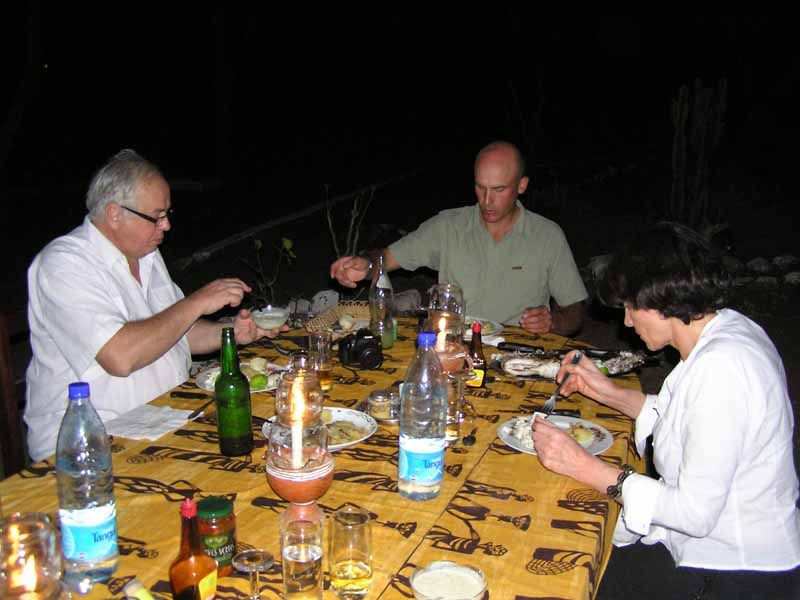 As stated previously, the food was excellent, interesting, diverse, and wonderfully presented - the best I ever had while on safari. Dishes included: roan kabobs, eland steaks, cob filet's, roasted hartebeest, western duiker kabobs, bushbuck liver and tenderloins (my favorite meat), buffalo tongue & steak, Nile perch (fillets and whole), roasted guinea fowl (my first ever - the hens were very tender), red duiker fillets (excellent!!!), Claire's Vietnamese warthog, tomato pizza, lasagna with buffalo meat sauce, lentil salad, and more - most of which were served with wonderful light sauces on the side, vegetables, French bread and a starch (potato or rice). Deserts were occasionally decadent, but mostly healthy fresh fruit. Fresh Nile perch & bushbuck fillets:   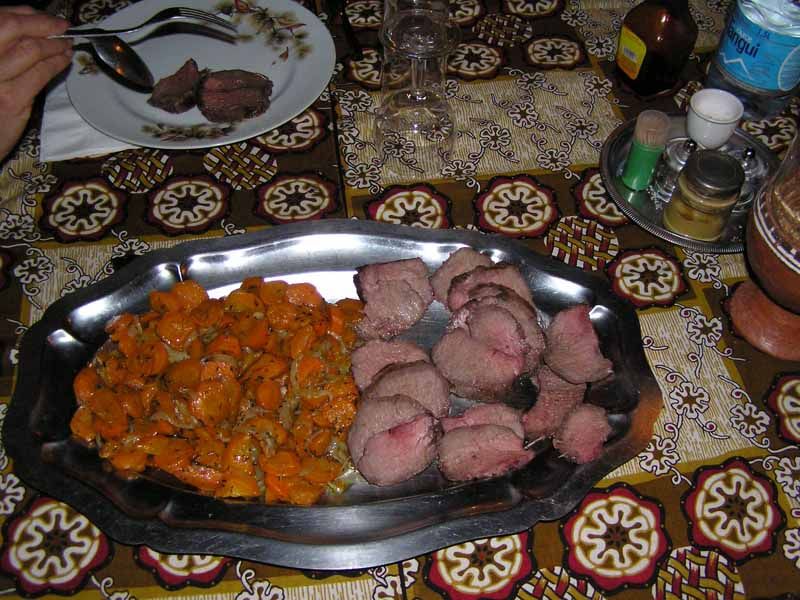  DAY-1 HUNTING I struggled with my internal clock, waking up at 2-4am, before the alarm at 5:45. Breakfasts were light, cheese, French bread, bananas and coffee although they would have made me eggs or whatever else I wanted for that matter had I asked. We departed each day at 6:30am sharp, after the sun had come up. The first stop was at the shooting range setup on a dry river within walking distance from camp. The table and rest was solid and much nicer then shooting off the hood of a Land Cruiser using a rolled-up coat for support! After all, the point is to verify the rifle's zero and for everyone to gain confidence - including the hunter, PH and trackers. If the client cannot shoot, there is not much the PH can do about it now, so they might as well setup a situation where the hunter has an opportunity to succeed and get the safari off to a good start. This was an important test for me, as I had been worrying about the accuracy and "fit" of the loaner Steyr Mannlicher .375 H&H ever since deciding to not use my own rifle. The .375 recoiled very little, due in part to the heavy barrel. My first shot was center 1" to the right, the second bull's-eye. This pleased my PH as well as the trackers, but probably me most of all! Most times - especially those when I am actively engaged in the hunt and feel "in control" - I shoot great, whereas other times when confidence is sagging I think too much and can choke. Hopefully this was going to be a sign of good things to come. Shooting range, where we regularly saw a pair of clever red flanked duikers: 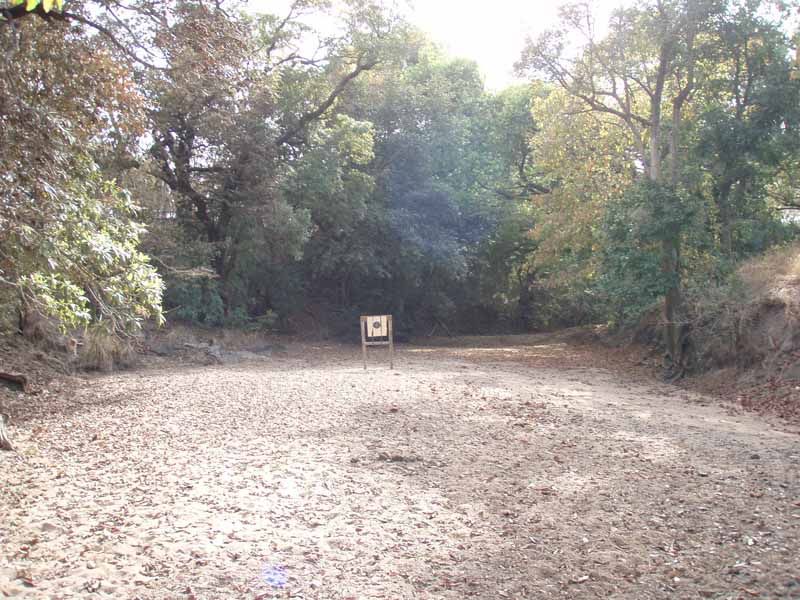 In the morning we drove the various dirt tracks in what I believe was the center of the concession, trying to get a fix on where the LDE were moving. All the spoor that we found crossing the dirt tracks and at the salt pans was 2-3 days old, not a great sign but it was only the first day and in most tracking hunts it takes a few days to locate where the game is and determine how they it moving. We returned to camp around 1:30, had lunch, glassed animals drinking along the Faro, and took a short ~45min nap. Large maneless lion, which was likely the same one we heard roaring during the night: 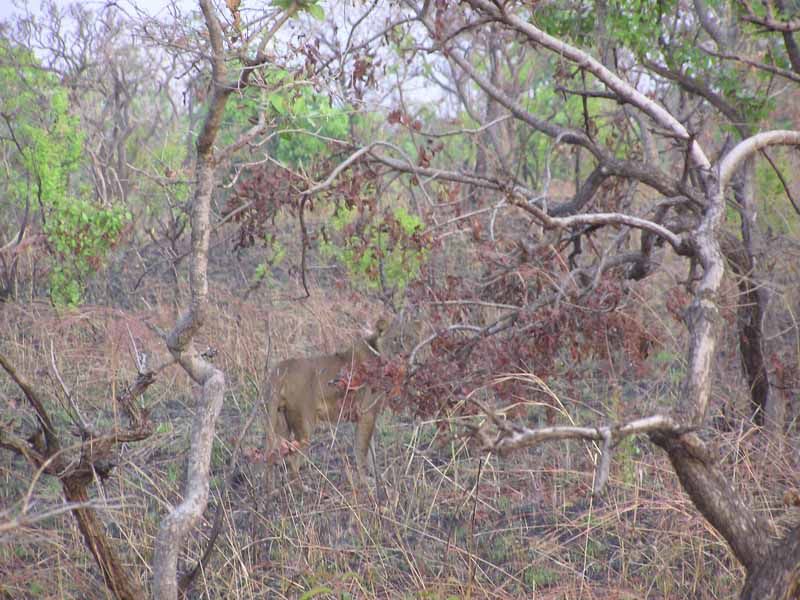 Looking for Lord Derby eland tracks at one of several natural salt pans: 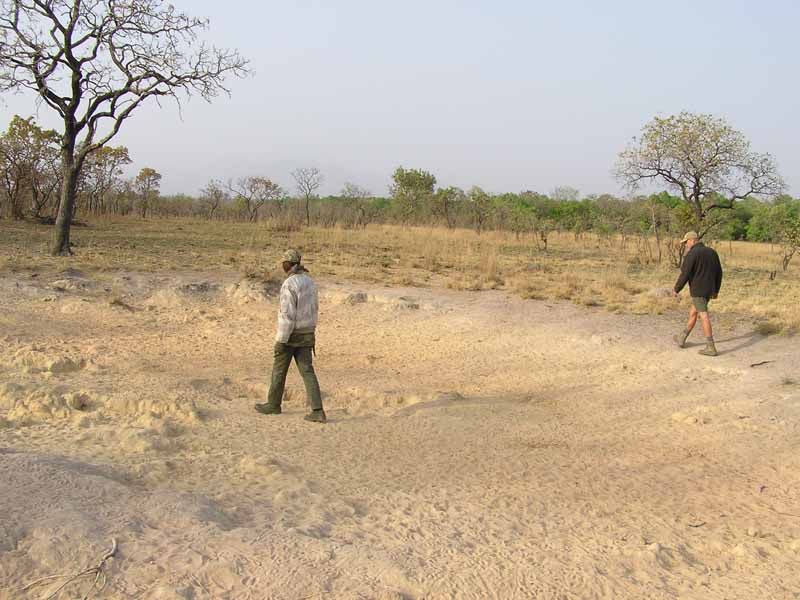 At 3:30 each afternoon we would head out to walk one of the river beds or bakos (the thick forests along the river banks, typically bordered on the other side by grass savannah). I enjoyed these walks immensely, as everything seemed to be perfect - the setting, temperature, sites and sounds. I never knew what type of creature we might encounter, especially along the Faro...duikers, bushbuck, monkeys, baboon, lizards and birds big and small. In what later seemed to be too easy, we stalked a western bush duiker (aka locally as a Grimm's duiker) feeding in a small clearing. It was difficult to be silent as the ground was covered with a thin coasting of crunchy leaves, including the hippo/game trails that ran parallel to the river. Yet somehow, this particular duiker did not hear us, and I managed to get setup on the sticks and make a perfect shot at around 30-yards. He was quartering to us, and without thinking I aimed at the point of the shoulder. The big .300gr bullet hit the shoulder, but the bone fragments did a number on the cape upon exit. My plan is to get the skull bronzed, so there was no need to try to salvage the cape (which is rather featureless). Baby hippo sleeping along the Faro:  Western bush duiker (note the hippo in the water in the background): 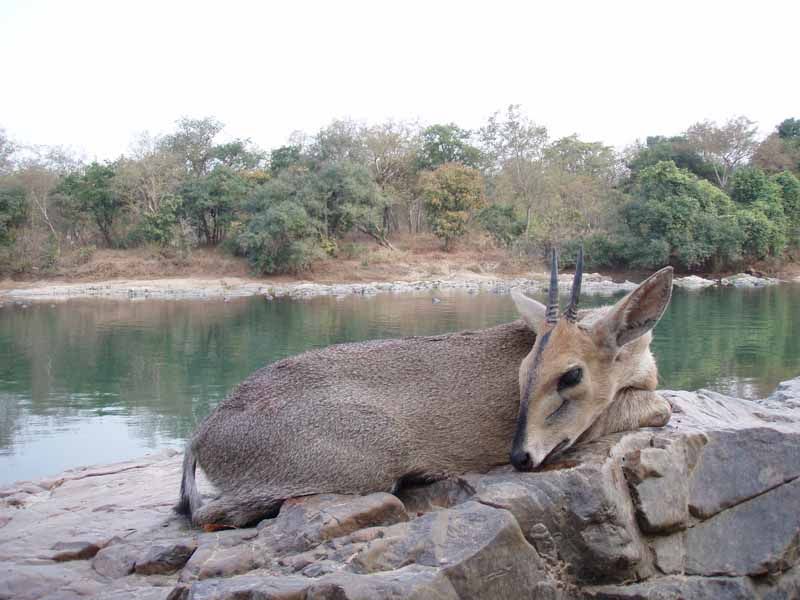 DAY-2 HUNTING On the day of my arrival, Malo had taken time to discuss with me my expectations, background and preferences. He asked me if I wanted him to back me up on any of the game, including the buffalo (I did not, unless it was approaching darkness in which case we would talk about it first, or there was an immediate and real threat to the safety of the group) and tried to ascertain the type of hunt that I envisioned. I told him that as important as the LDE trophy was to me, the experience and the manner in which it was taken was of an even higher priority. I had trained and prepared for many months with the expectation of long and grueling walks, and I did not want to shortchange the experience by shooting one along the road. My "ideal" Lord Derby eland would be old, carry worn and characteristic horns that met the Rowland Ward minimum of 45 inches, have a thick and heavily muscular neck with a long dewlap, and sport a dark black mane and mop. Basically, I wanted the perfect eland...and I wanted to earn him after expending considerable effort over days of arduous and exhausting tracking. This is the problem with hunting your "Dream Animal" - one has too much time to dream. Malo replied with a uniquely French accent, with what would become a reoccurring statement of enthusiasm and potential: "It is possible". I relayed that of course we do not always get what we want, but he asked and I thanked him for that. We also spoke of my expectations regarding the other game, and which animals available on the Big Game license that I did or did not want. It was all very professional and indicates a polished and well-trained PH. Malo was always courteous, respectful, cheerful and friendly. Never once did he get sour, play games or try to deceive me. I liked Malo, and would happily hunt with him again. As with the previous day, the eland spoor we had seen was all 3+ days old, which perplexed and concerned Malo and chief tracker Koulagna a bit. I chalked it up to the full moon, realizing that as the hunt went on it would become better and the new-moon phase is said to be the best. Based of our previous conversation, Malo asked if I cared to take a walk through the heart of the hunting area in an effort to pick up LDE sign, and determine where the herds were (or were not). They had been seeing considerable sign of eland in the areas where we were looking on previous hunts (mine was the 3rd LDE hunt of the season which started the week after Christmas). A walk, absolutely, lets go, bring it on! Not far into the walk Saidou, the eagle-eyed tracker who remains back from the group by about 20 meters, hissed and motioned us to hit the dirt. He had seen two eland and quite possibly there was more hidden in the mopane scrub. Malo, Koulagna and I crawled our way across the broken ground, using what cover was available, to within 200 yards of the eland. They were young males, resting in the shade of a tree. Malo studied the area for a while with his Swarovski's, looking for an older bull as it is odd for young bulls to travel along, and eland do not typically stop moving so early in the morning. After about an hour, they came to the conclusion that there was no big bull amongst them, so we snuck back out. But I'm thinking, "Man, this Lord Derby eland hunting is easy, who said they were going to difficult to get on". Fast forward a few days, and I would no be longer entertaining this particular thought! Stalking what turned out to be two young eland bulls (good practice for the real thing!): 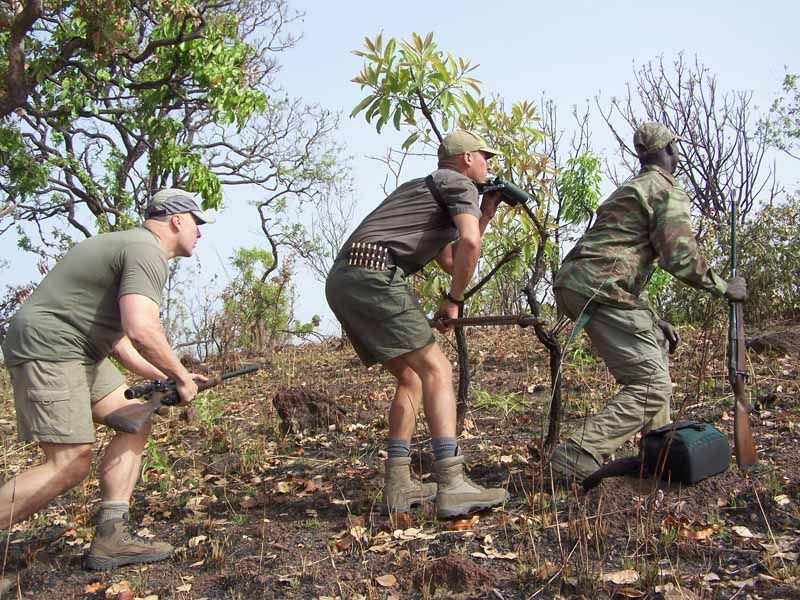  I should mention that while one may walk considerable distances when hunting LDE, the pace is usually reasonable as it requires effort for the trackers to stay on the spoor. It is not like most of the elephant hunting that I have done, where we literally walked the elephant down as they meandered along game trails or down sandy river beds. Nor is the terrain, at least where I hunted, hilly or rocky. What does make it difficult though is the ground itself which is in most places uneven and difficult to walk on. During the rainy season, billions of worms pile mounds of dirt on the surface as they burrow. When the weather heats up, the sun bakes these mounds hard and they become crunchy when stepped on. Without good boots and strong ankles, I would not even consider hunting LDE. I had no problems except in the long grass where one cannot see the mounds and each stride is a step into the unknown. The dreaded "worm mounds" 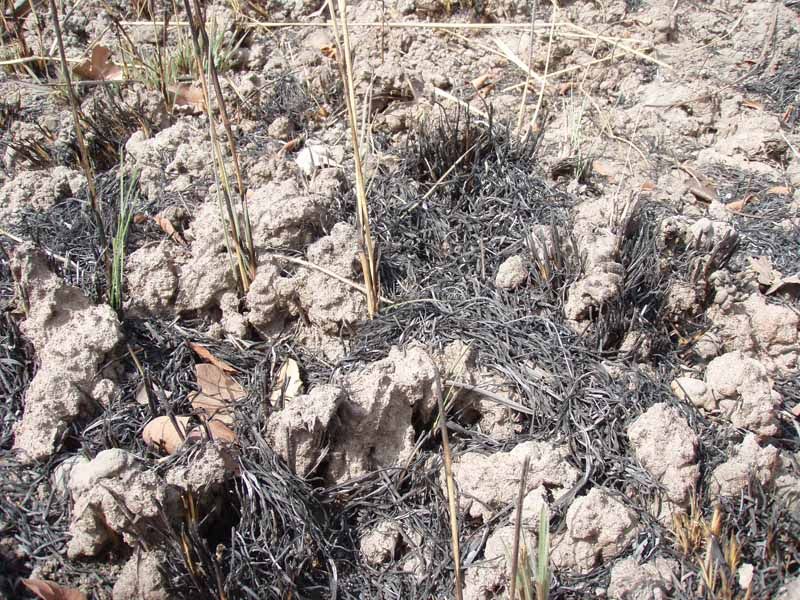 I do not know what makes these mushroom dirt mounds. Note the yellow flower, a favorite of the warthogs, which emerges leafless after the ground is burned. 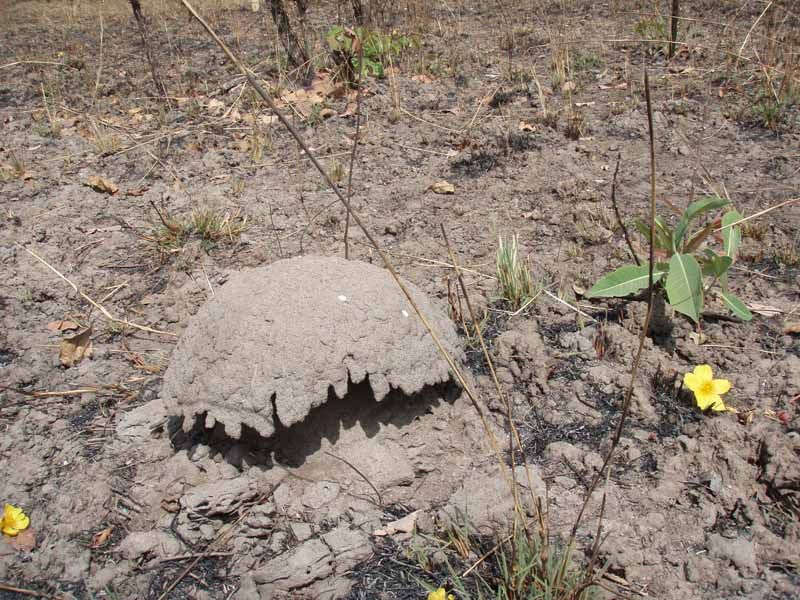 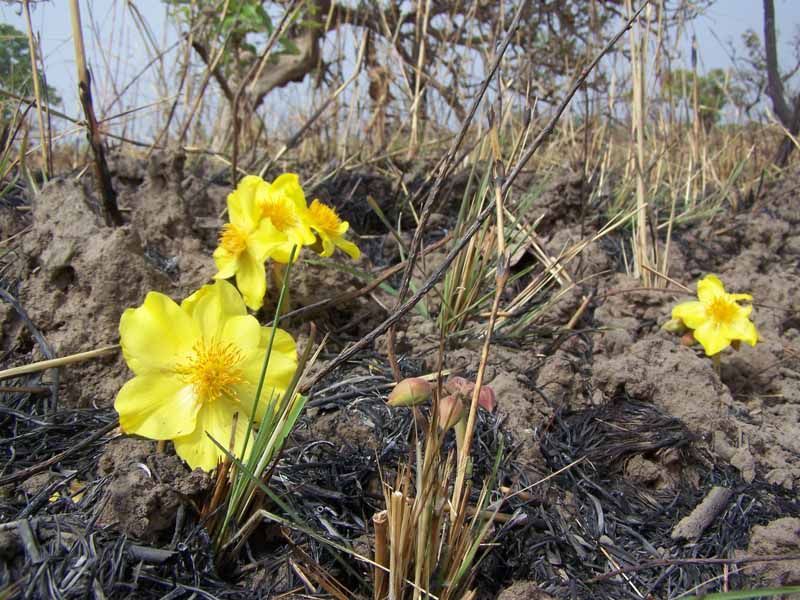 I had every intention of not shooting a kob, as I already have a puku from Zambia (they are similar) and like the puku the kob did not seem to be much of a challenge to hunt. Kob were everywhere, and they were in fact not shy around the vehicle. However, on foot, I found them to be quite switched-on. While walking on other game, we did get into range of a few, but I was surprised at how alert they were. The previous day, I saw a decent looking kob and said to Malo that if we happened to run across a monster kob, a true giant with mass and size that he had never seen before, that he should let me know as I would be a fool to pass it up. I was comfortable with this as in my mind I could forget about kob now, as the chances of finding one like this was slim, or so I thought. That afternoon we were on our way to walk a dry river bed for red duiker and bushbuck, when we saw what was obviously a huge kob tending to his ladies. Malo got quite excited and said that is the kob that I was talking about. We drove beyond and stalked back, following him for a bit as he chased after the females and younger males encroaching on his turf. The shot was about 100 yards. Everyone was very excited as at 57cm's, this was the second largest kob ever shot on the concession, second only to a 59cm ram shot by one of Gee's clients. I normally do not feel as satisfied after this sort of a hunt (drive, spot, bail, stalk, shoot), but it was indeed exciting, I made a good shot, and I was getting plenty of exercise with the other game. Professional Hunter Jean Malo Gueguen (right) & record-book kob: 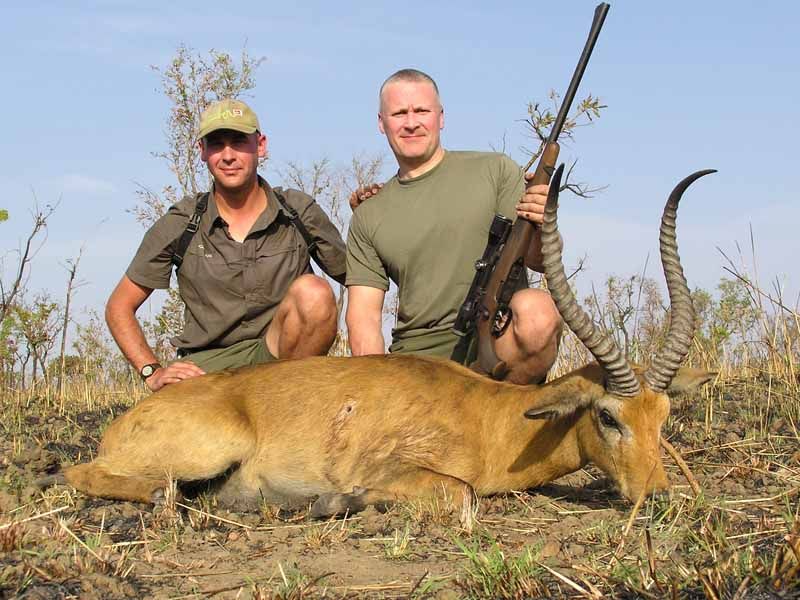 Walking a dry river bed for red flanked duiker & bushbuck: 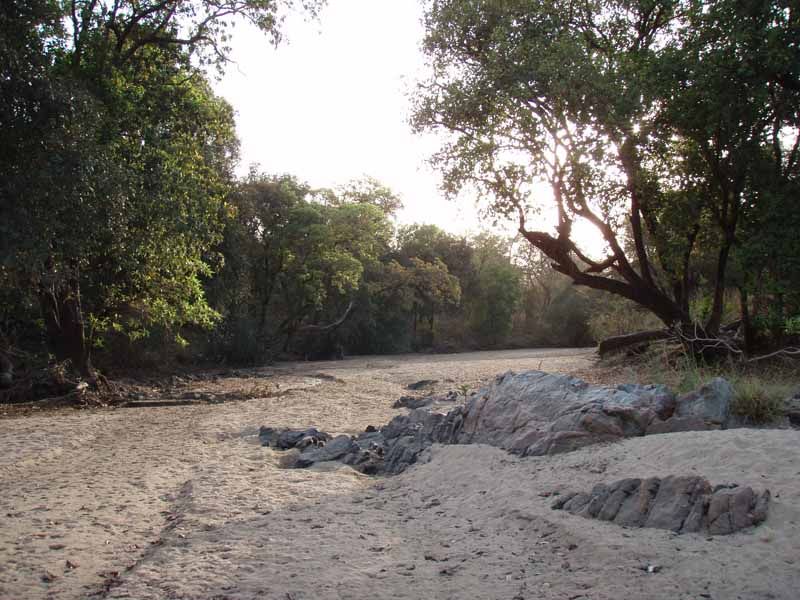 | ||
|
| one of us |
DAY-3 HUNTING We almost had success on the Lord Derby eland today. We followed the same routine as previous days, up, eat, out at 6:30 and locate spoor crossing one of the dirt tracks within two hours. Koulagna diligently tracked the herd for about 1.5hrs, following tracks, broken trees, nibbled leaves and fresh droppings before Saidou again saw them from his position at the rear of the procession. It was a nice sized herd of about 25 animals. We hunched-walked (one needs to train for this!) and crawled into position, and watched them for some time trying to identify if there was a trophy-class male among them. This is the only time that Malo and I had difficulty communicating, and afterwards we began to go over simple English phrases such as "left/right", "in front of", "behind", "by the tree", "head down", "head up", "looking at us". Malo's English was pretty good, and certainly better then my French. When around camp or on the back of the truck, Pierre would help translate, but in the field and in the middle of a stalk, Pierre would stay behind which left Malo and I alone to work things out, which we did. Despite getting some good pictures, I did not get the scope on a big bull. Eventually the eland trotted away. We left them for a bit then followed, but the herd went into the long grass. Once this happens, the hunt is over as there is no following them. I doubted this, thinking that "Of course there had to be a way if one is determined enough!" But I was wrong, after walking through the 5-6 foot high grass, it became obvious that not only was tracking difficult, but the eland would hear and/or smell us long before we would see them. 6am breakfast - Malo (left) & Pierre (right):  Fresh eland tracks! 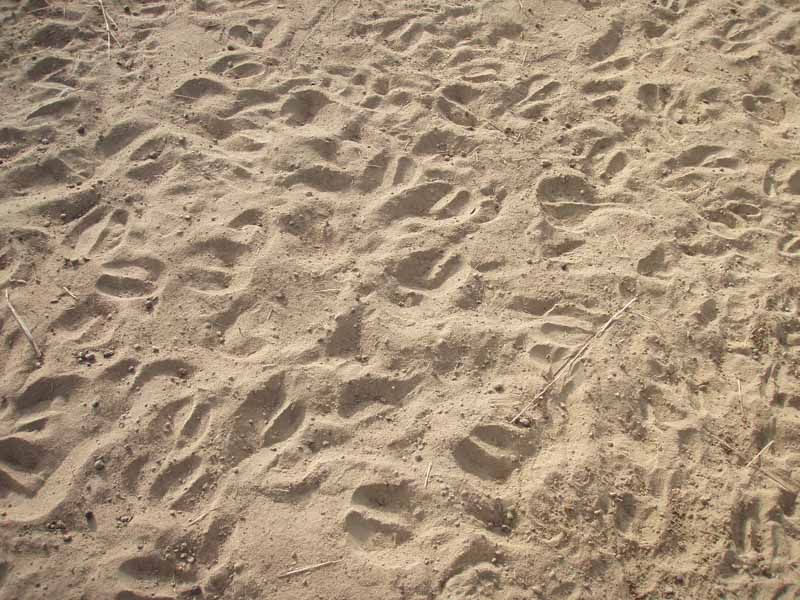 Small trees snapped by the eland bulls who put the tree between their massive horns and twist, so that they can get to the succulent leaves, although they only seem to nibble a little bit before moving on: 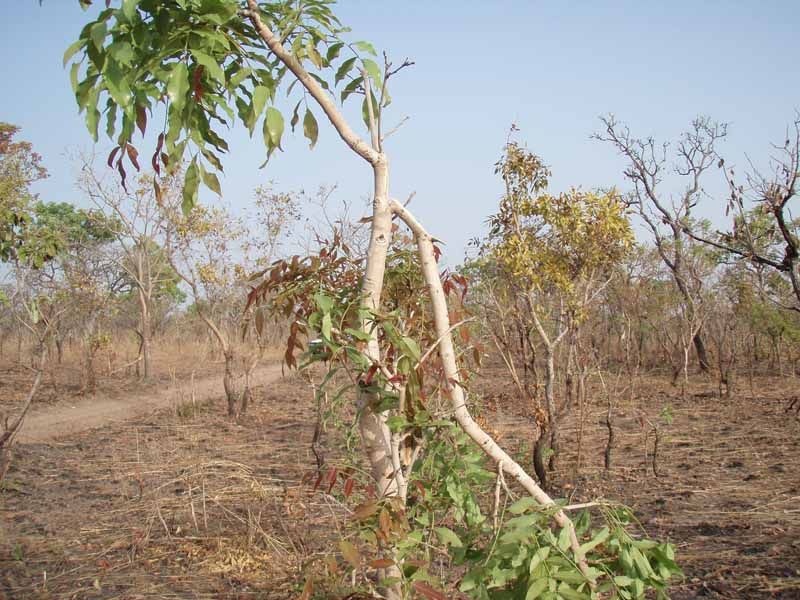 Herd of Lord Derby eland (at ~150 yards, camera 3x zoom); note the difficulty not only seeing the eland, but in trying to get a shot through the brush: 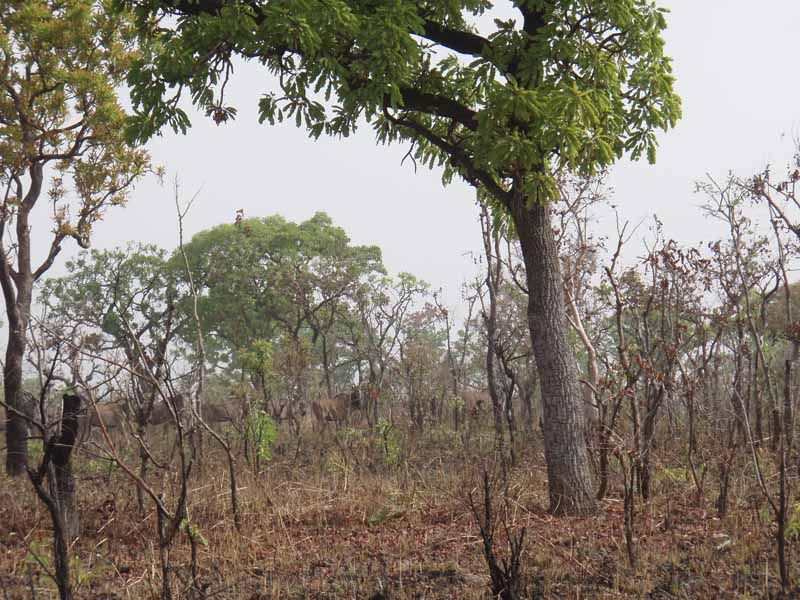 This picture was taken by Pierre. The bull will be a good one, but was not quite old enough.  After a hearty lunch back at camp and a short nap, we were back out at 3:30pm. Up to this point, I had not seen any buffalo, and I was wondering what part of the concession they would be found in as Malo said there are certain areas that they have a definite preference for. A few buffalo and the tell-tale cloud of dust was spotted from the truck, and we geared-up and ran around, along side, and in front of the herd. It worked like a charm, as the buffalo moved by us in single file, not more then 40-50 yards away. Although they all had the neat red color that I was looking for, there were no mature bulls in the group, and certainly no miserable old dagga boys. Koulagna beamed with pride when I shook his hand and told him what a wonderful job he did getting is on them. My respect for him as a hunter as well as a tracker continued to grow. We were to see this herd a few more times during the course of the hunt. 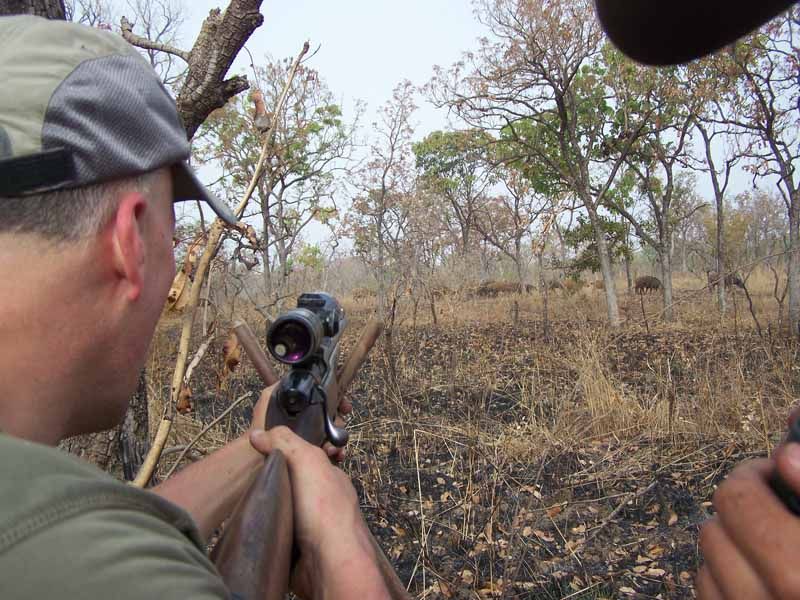  On the way back to camp, we saw two black buffalo, one of which was a nice old bull. We stalked into range, but I declined taking the 100 yard shot as it was last light, and there are far too many lion and hyena in the area for any chance of recovery if we were not able to get him before dark. The bulls were looking in our direction, so there was no way of getting closer. They went their way, and we ours. DAY-4 HUNTING The first few days of the hunt, we experienced the Harmattan to varying levels. Today it was the worst yet which decreased visibility. Of more significance is the impact it seemed to have on the animals, which were just not moving. Areas that were teeming with kob on day-1 now appeared to be devoid of life. The Harmattan is a dry and dusty West African trade wind, which blows south from the Sahara Desert between the end of November and the middle of March (winter). The heavy amount of dust in the air (I was told by the German professor on the plane that it is not really sand, but pieces of shells and other remnants of sea life from millions of years ago when the Sahara was an ocean) can severely limit visibility and block the sun for several days, comparable to a heavy fog. The only possible benefit was that I did not sunburn, and by the time the Harmattan lifted I had enough base tan to protect me. Note that this is one minor downside of going on a safari during the winter months, as unlike June-Oct most people are pretty pale and the African sun, especially close to the equator, can be brutal. The Harmattan - dust blown south from the Sahara: 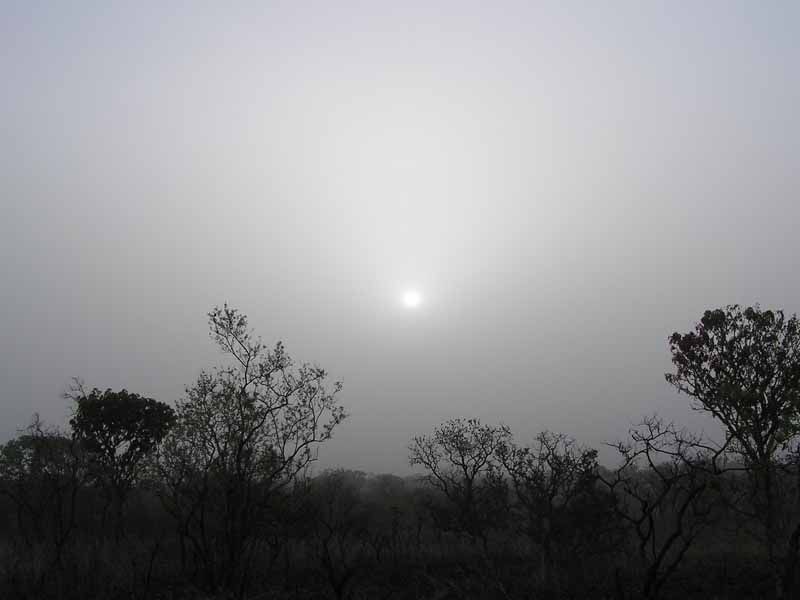 At around 8:30am we found tracks of a lone eland bull at a salt pan. This was encouraging, as all along I wanted to track single bulls under the assumption that they would - like buffalo or elephant - be the older males. This is probably not totally correct though when it comes to eland and Malo patiently explained several times that unlike buffalo the old bulls do not typically go off on their own, and while they switch from one to another frequently, they do prefer to stay with a group most of the time. Malo said the oldest bull he ever shot was from the middle of a large herd. Nevertheless, a single bull was attractive as there are always exceptions, and at the very least it would make tracking and identification easier, if and when we caught him. We followed the spoor for a while, only to find that the bull joined a herd. Very likely he was on the periphery of the group all along, and we had just not seen their tracks until then. Tracking became slow as like elephant herds, the eland stop to browse and mull around. It takes the trackers time to sort everything out, and identify where they left the area. Too, there were maybe four herds in the general vicinity, and old and new tracks intersected often. A few times we followed spoor only to find that another animal had crossed the track (a nocturnal animal such as a porcupine, birds or even insects, which identifies the track as being at least during the night or older), or droppings which were cold and dry to the touch. At this point the trackers need to backtrack and find the more recent spoor from that morning. The longer it takes, the less chance there is of catching the eland before they enter the tall grass. As Malo explained, if they burn all the grass, the LDE will leave the area. Without any burning at all, it would be virtually impossible to hunt them, and the animals are attracted and nourished by the tender young grasses and leaves that grow after an area is burned. As long as the eland have everything they need (food, water and cover), they will remain in an area, usually circling although to me their exact movements tended to be somewhat random. Most times they would walk into the wind, but every now and again, they would move with it at their backs, especially before slowing down to browse or rest a bit. At this point it becomes a matter of timing, or seeing them from far enough away so that you can move with the wind in your favor before they get scent of you. By about 11am, if they are not in the grass the winds begin to get squirrely. All of this conspires to work against the hunter. I was now beginning to fully understand and appreciate what Lord Derby eland hunting was all about. At times it is amazingly frustrating, and one moment you are up and the next down. It was only day 4, way too soon to panic, but I was beginning to become conscious of the finiteness of my hunt. Lunch was around 2pm (quiche), and afterwards I spent some time wondering around camp and taking pictures before the evening walk. Lunchtime scenes from around camp: 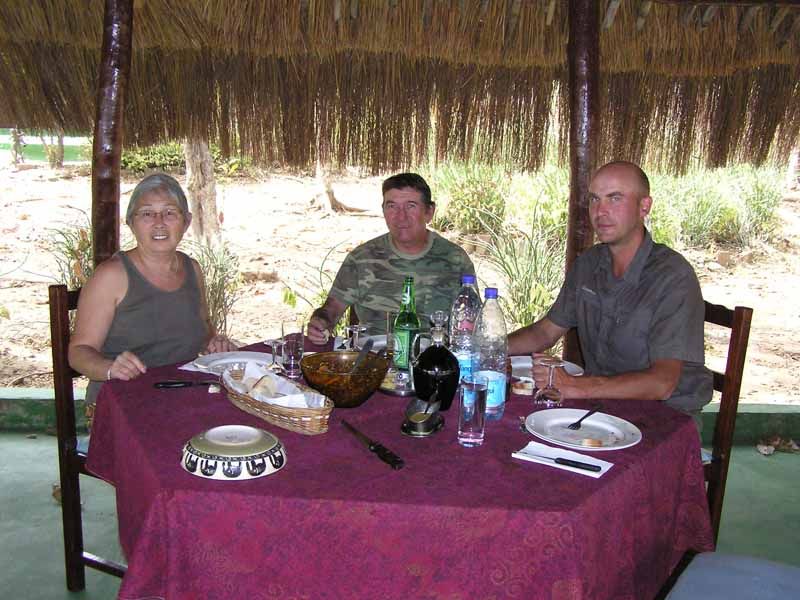 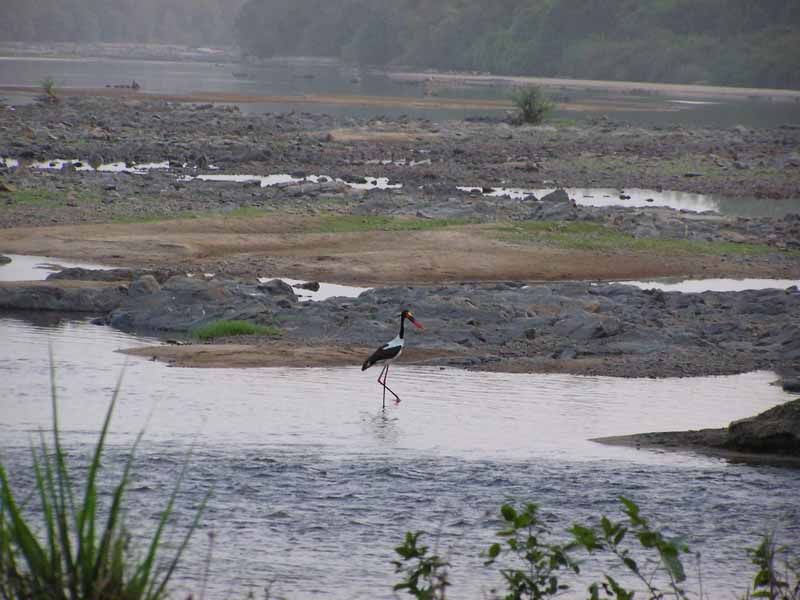    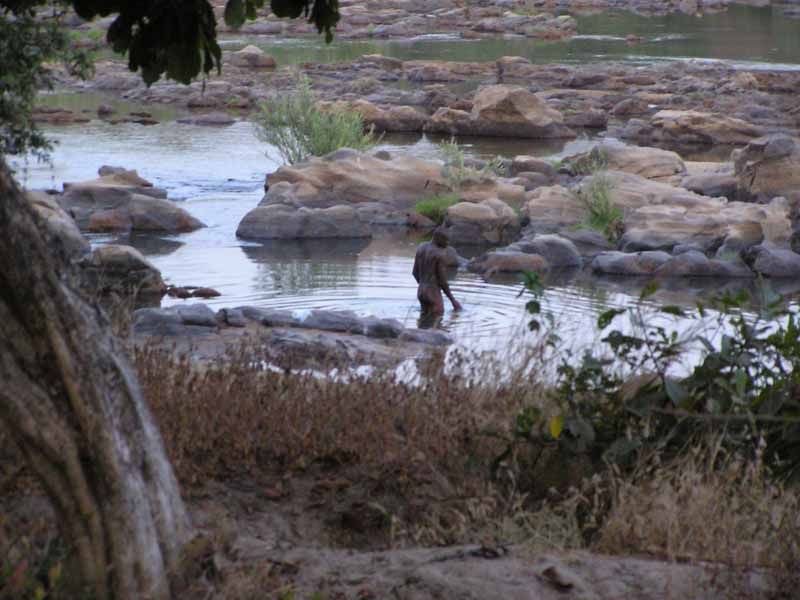 Shortly after reaching the river bed, I missed a shot on a red duiker. You know you are in trouble when your first thought when you see the animal in you scope is "Aw, isn't he cute". I shot low and left, noting that the little duiker is an awfully small target and the .375 felt like overkill for the job at hand (I was using solids at this point for the duiker). BEST MISS of my life, however, as in subsequent days I had the opportunity to really enjoy the duiker hunting. Kob fillets for dinner, bed at 10:30pm as usual. Another enjoyable evening spent walking for duiker & bushbuck: 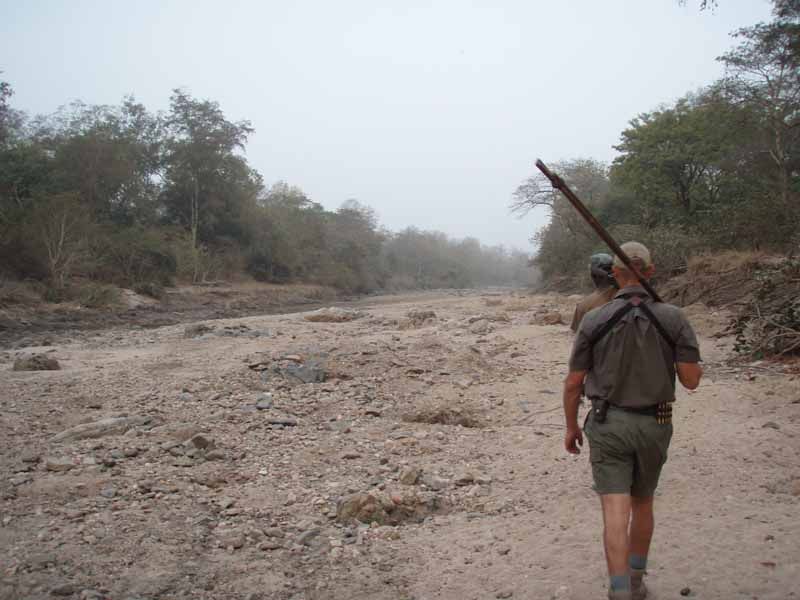 DAY-5 HUNTING During the night I once again herd lion and hyena close to camp, as well as hippo in the Faro below. At this point in a hunt, my systems have become acclimated to the new schedule and eating patterns. One of the challenges with LDE hunting, and all eland I suppose, is that they rarely stop moving – so getting on them can be a hassle. Conversely, one of the niceties is that they rarely stop moving, so finding tracks at least in a good area is pretty easy. As Guy said to me on the satellite phone the night before, "Every day is a new day when hunting Lord Derby eland." Sure enough we were on the trail again by 8:30am. The trackers struggled following the spoor due to hard ground, only to find that they crossed over the road just a few hundred yards ahead. When hunting elephant, especially along a boundary, Buzz Charton has an excellent system where he sends his driver ahead, and if he sees spoor he radios the group. This helps preserve precious time by avoiding hours of tracking, only to find that the elephant has crossed back into the Park, for example. In the case of eland though, it is not quite as simple and generally they will walk with the wind in their faces so if this is the way the tracks are heading, one reasonably assumes that they will continue in this general direction. Buzz also makes clever use of the radios, often directing the driver to relocate so as to shorten the walk back to the truck. This not only conserves energy, but allows for more stalks over the course of a hunt. In Cameroon, however, they are not permitted to use long-distance radio, and the handhelds do not provide the distance required especially in what is mostly flat country. 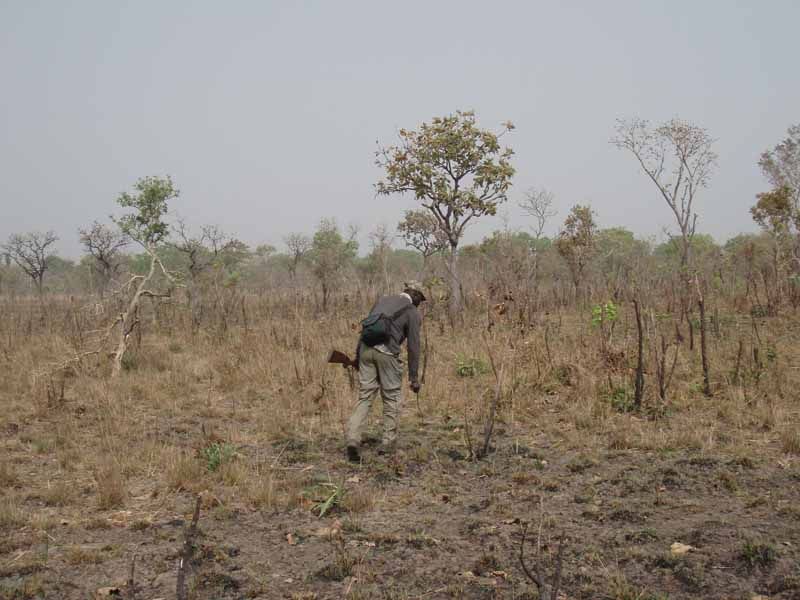 As we tracked this group, it appeared as though they were heading for the tall grass, but luckily they remained in the mopane scrub feeding as they walked. We lost tracks, but Koulagna made an educated guess and picked them up a mile or so ahead. We never saw the bull, but he obviously smelled us as the wind was bad. Deep hoof prints in the dirt identified where a big bull had stood, looking in our direction, before running off. Malo said it is virtually useless trying to catch an eland that gets your full wind. A sighting may be okay, and if not pushed they may settle back down. But if they get your full wind – game over. We continued following the herd, with the wind still bad. Once again, we never saw them, but they smelled us. I have tracked game long enough to be able to spot almost immediately the point at which an animal begins to run. Normally the PH and tracker will exchange glances, but not say anything. I, however, know exactly what is going on. With elephant, you lower your head and push on, knowing that in about an hour with any luck you will be on them/him again unless they are really spooked. The running turns into a trot, and eventually the tracks indicate that the animals are walking again. With eland, however, you lower your head and march back to the truck...and don't even ask how long it will take, just march. The herd had only been some 500 yards ahead of us judging by the freshness of their droppings. A fresh dropping will be moist and somewhat gooey/slimy on the outside, and taste like chicken. Like with other game, the bull droppings will be noticeably larger then a cow or young male. In late afternoon we drove to a marshy area along the Faro where the team had cut a new road a few months ago. The dirt track over the worm mounds was so poor that I abandoned ship and walked for a while. Malo and Pierre expected to see a lot of game, but the mild Harmattan seemed to have everything sticking close to cover. We did see two old buffalo at dusk, and made an attempt to get on them, but they perceived the threat and ran off before we could get into range. Western (Bubale) hartebeest: 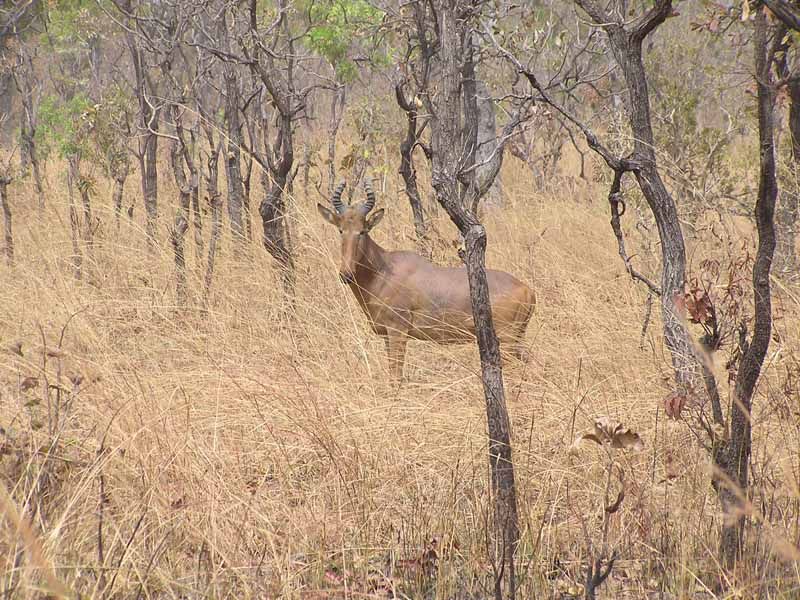 DAY-6 HUNTING Lions were in/around camp last night, calling from a tree not more then 30 yards from the dining area. It was loud, but nothing like in the Caprivi when a big male was 10 yards from our tent flap and my son and I could actually feel each roar. In the morning, as I had my cup of coffee watching the sun rise over the Faro, I saw one male and a female making their way across the river. Sunrise over the Faro River:  In addition to the normal bread, cheese and bananas, I ate a few eggs this morning, which was a good thing as it was going to be a long day. We followed the same routine, out a little early at 6:20, and on spoor by around 8:45. The mornings were crisp (~55 degrees Fahrenheit, ~13 Celsius), and on the back of the truck a hooded sweatshirt with a pocket for my hands was very much appreciated. However, most mornings we took the Toyota dual-cab Hilux, and did not go back to the high seat until the sun had warmed things up a bit, around 8am or so. I do not like riding in the cab, and prefer the back high-seat most of the time. Daytime temperatures in the beginning of the hunt, due in part to the Harmattan, were very comfortable. Towards the end of the trip it was hitting 95-100 degrees Fahrenheit (35-38C) by mid-afternoon. The temperatures and humidity will continue to increase until the first rains sometime the end of April. Again we found ourselves on the trail of a lone bull, having picked up spoor at a salt pan close to where we had seen the two young bulls on the second day. After about three hours, the bull joined a herd. 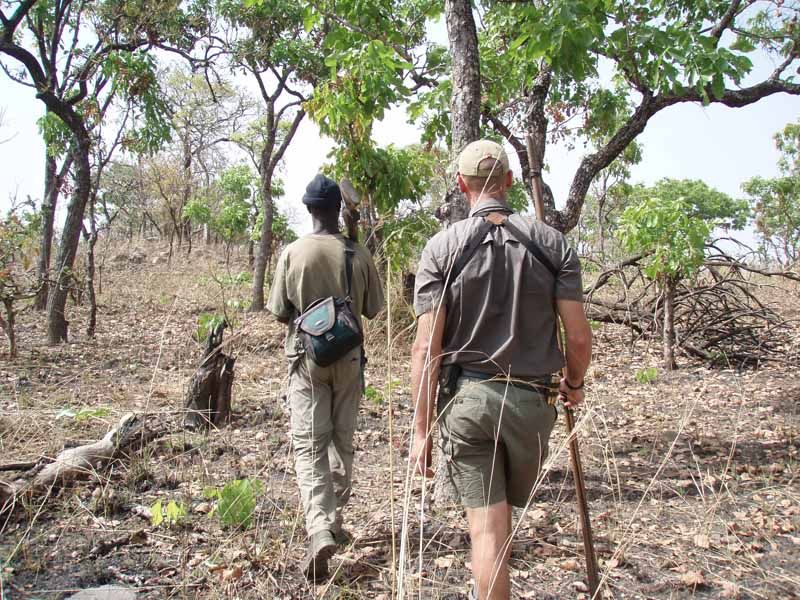 Found while walking, a rock used by ancient villagers to grind grains: 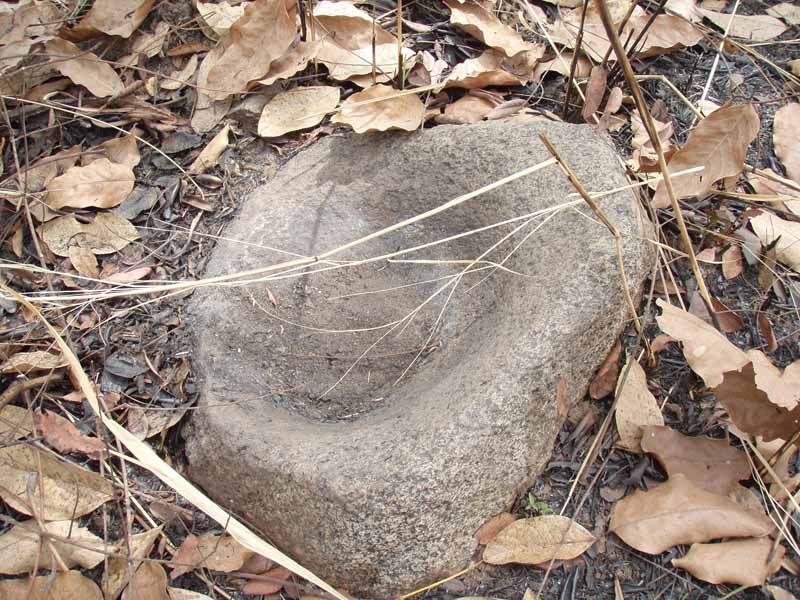 The big .375 H&H was getting heavy, and for the first time I handed it off to Malo to give my lower back a bit of as break. Not more then 10 seconds later, just in front of us, one lion then a second lion exploded from the grass, roaring their displeasure in our direction. Actually the second lion didn't seem to know what was going on, and more or less followed the first larger male. I found this amusing, the fact that instead of the .375 I was carrying the friggin shooting sticks - almost too coincidental. One has a lot of time to think when walking, and often my mind would wonder back to the various discussions that have taken place on AR, in this case the one where MR said he would never walk around the bush without his rifle. A few times thereafter I traded Malo the rifle for the sticks, but not often and not for long. Mostly foolish pride, but I like carrying my rifle, even when not in country thick with elephant. Pierre was actually behind us and up on a rock face taking pictures at the time, but just missed the shot on the lions capturing only a tail. Had one of us gotten eaten though, he would have had enough time to get a great picture I am sure. We continued on in pursuit of the eland, now a herd instead of a lone bull. Sure enough, not long afterwards, we bumped them. The wind was bad, but by the looks of their hoof prints they were not running hard, and perhaps they just got a whiff. We gave them a bit of a break before continuing. 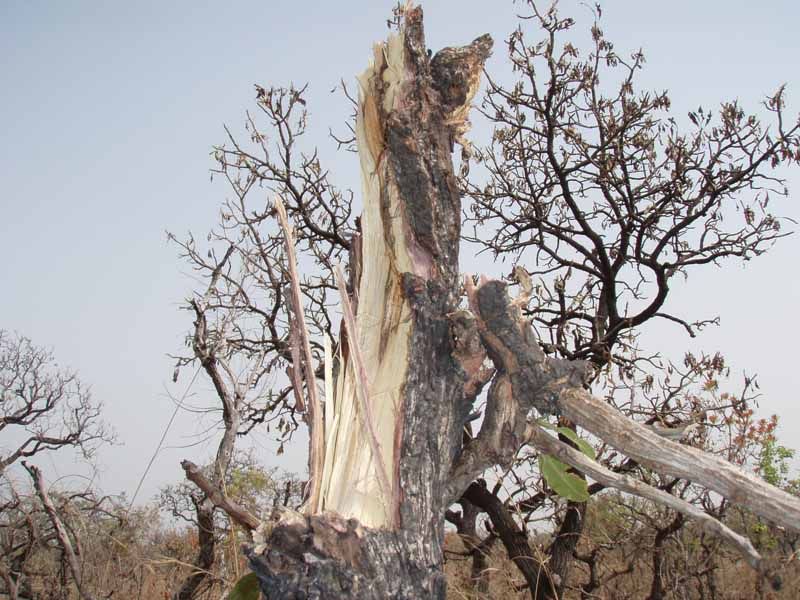 Koulagna & Saidou, taking a break before resuming the chase: 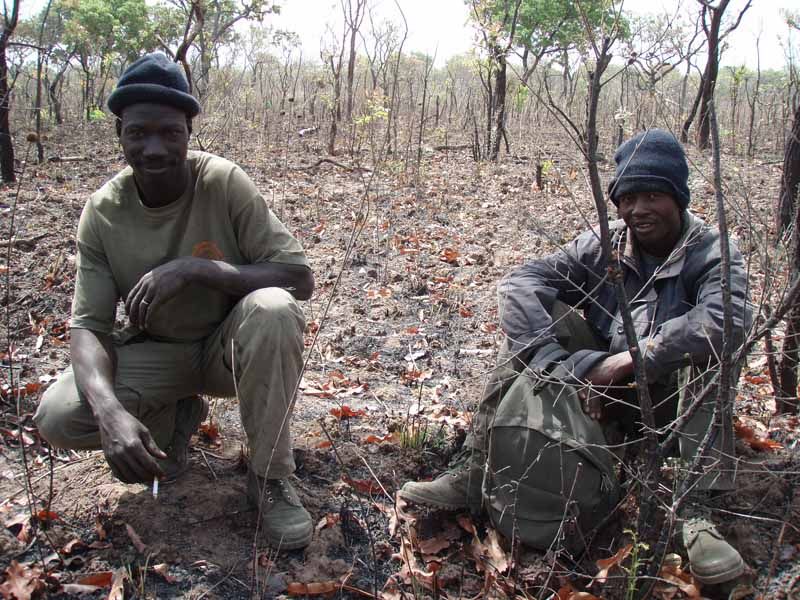 As they eland felt threatened, they instinctively turned to walk into the wind. This was good, however, they were going to be on guard and not easy to approach. We trailed them for a while, and tried several times to jog and cut their path so that we could get ahead of them. Saidou had them spotted, but we believe a young bull saw some movement. He ran, and took the herd with them. Shortly thereafter, they entered the long grass. We followed a little but, more out of frustration then for any good reason, but gave up when we were all convinced that it was pointless. Yaouba getting a drink before heading into the long grass: 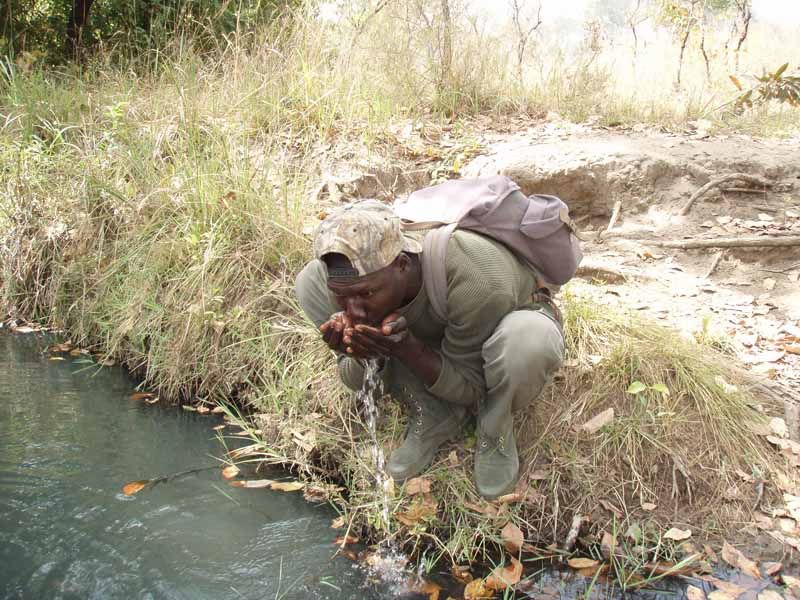 Burn it!!! 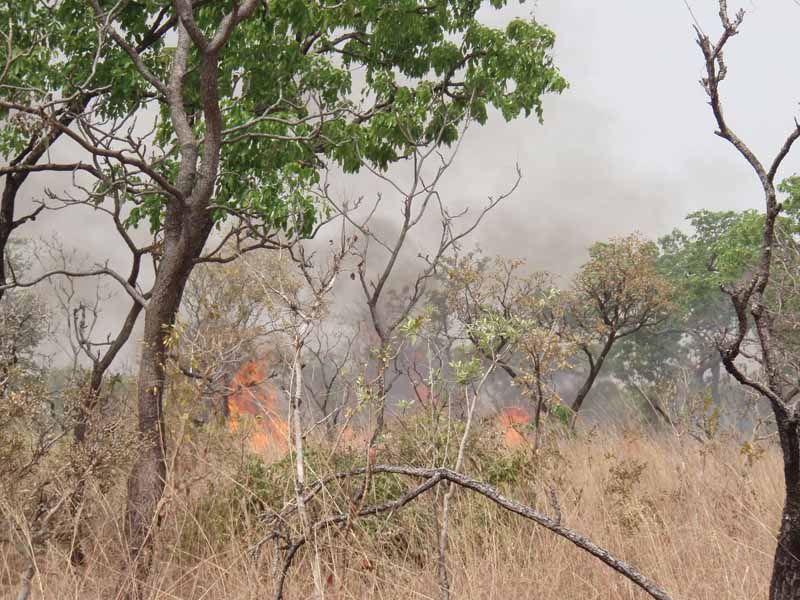 We walked one hour briskly back to the truck, taking a short cut though the long grass instead of taking the long way back which would have required twice as long. Malo and Koulagna are a bit taller and a little less wide then I am, and the extra height helped them sail through the grass. Pierre and I on the other hand took most of the grass to the face, and by the time we reached the truck I was a bit angry at the world. But a nice swig of water, a few pieces of hard candy, the wind in my face on the back of the truck, and all was better. It was a good walk after all, and I reminded myself this is why I came this far. But LDE hunting on day 6 had effectively ended, and the clock was ticking. Instead of taking the truck out in the evening, we simply walked out of camp and up the Faro River. As usual, we saw female bushbuck and red duikers, but they are fast and switched-on, and very hard to hunt. Dinner tonight was roan in a nice gravy over rice, and was excellent, but it was not my roan, which means that we were hitting the deep freeze. It was time to shoot something. DAY-7 HUNTING We picked up fresh spoor again, and I continue to be amazed at how much the eland herds move around. I believe that much of it has to do with the fact that the dirt tracks that we drive are in close proximity to the salt pans, and the eland seem to follow a fairly consistent routine. This was our shortest walk yet, just some 30 minutes. We tried to get in front of the herd, but had to work around a pair of roan bulls, and the eland unexpectedly changed direction and headed directly into the long grass. The thought crossed my mind that after seven days of knocking around the same general area - albeit huge - perhaps the eland were getting a bit jumpy. Nothing like shooting a buffalo to lift ones spirits though! Ideally, we would have shot the eland about this time in the hunt, and I would have had the remaining days to hunt other game and specifically the buffalo properly (via tracking). Sort of like game clock management. However, here it was day-7 and the only animals in the salt was a kob and a western duiker, both were excellent but neither were on my initial trophy list. Until the eland was down, buffalo was secondary, as they too would typically be tracked in the mornings. On the first day of the hunt I had passed a decent bushbuck, as the only shot offered was a frontal, one of which I would normally take. However, this was one of the drive/spot/bail/stalk/shoot situations, and I wanted to shoot my bushbuck after stalking it on foot. Ever since then, I kept hearing Mark Young in the back of my head say "Youuuu shooould haaave shot theee bushhhbuuuck". So, here we are driving along, sucking on Jolly Ranchers, but still feeling a bit dejected. The back of the truck exploded with excitement "BANA BANA". The guys had spotted a lone bull buffalo, in what I would later find to be an area where he had been seen before. We drove on, and stopped the truck. As usual, I cycled a round, providing one in the chamber and three in the stack. The first shot was solid, but hit a bit back, as given the distance of ~125 yards, I would have preferred a bit more magnification with the scope. The initial shot and follow-up on the buffalo: 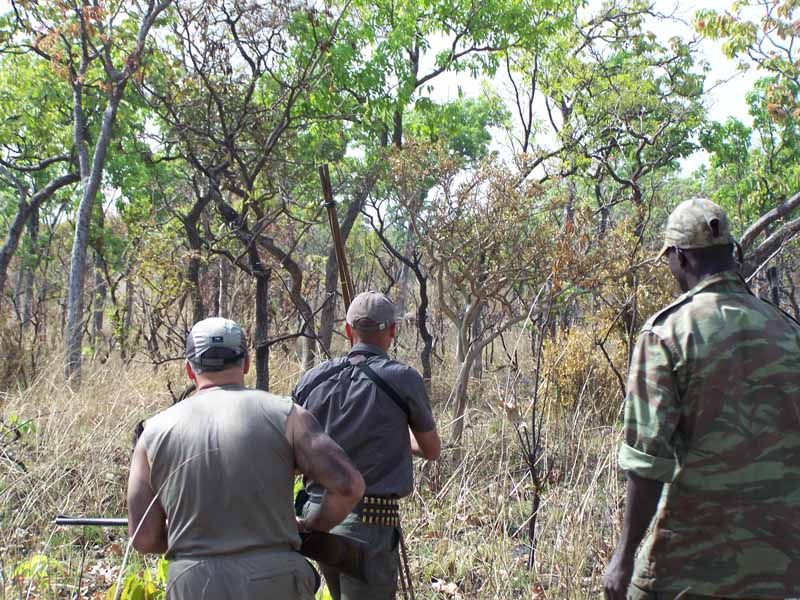  The bull stumbled off, and we quickly closed the distance. After a few more rounds with the .375, including the shot shown in the picture below which actually penetrated a small tree prior to the buffalo, the bull was finally down but he held on for an amazingly long time. This is the third buffalo that I have killed with a .375, the other two were both perfect heart/lung shots thanks in part to the 9x scope I was using, and the buff died quickly. I am sure that had I been using my .416 Rem or .458 Lott on this bull with the same placement, it would have been over quicker. In my opinion the .375 is certainly enough for buffalo, but the margin of error is less and one must make the first shot count. Wounded buffalo unable to stand: 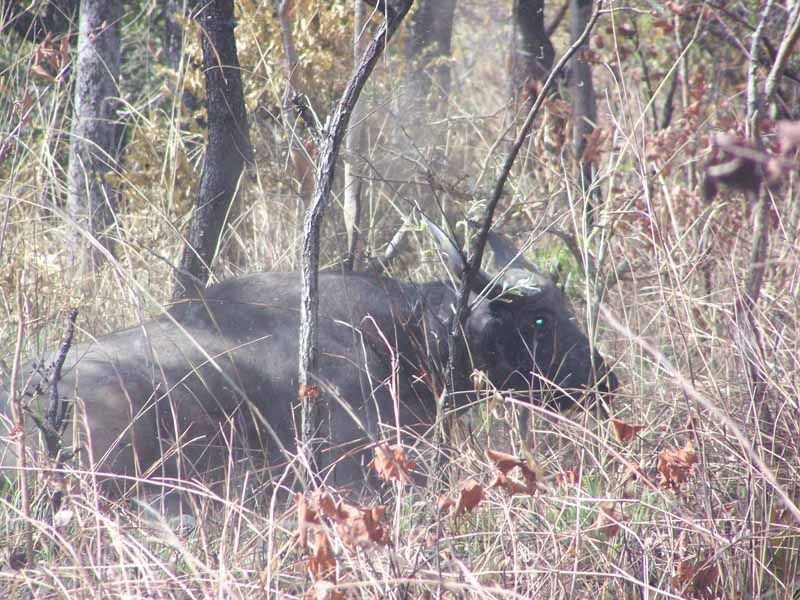 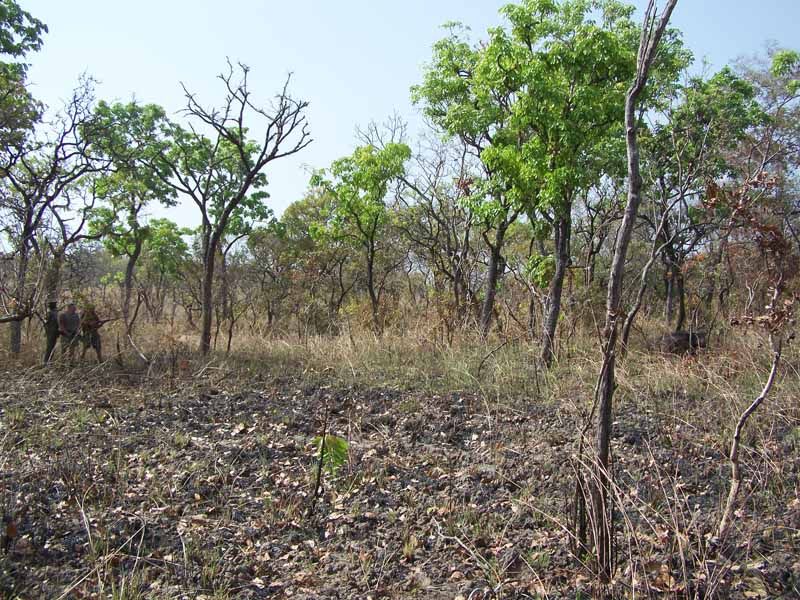 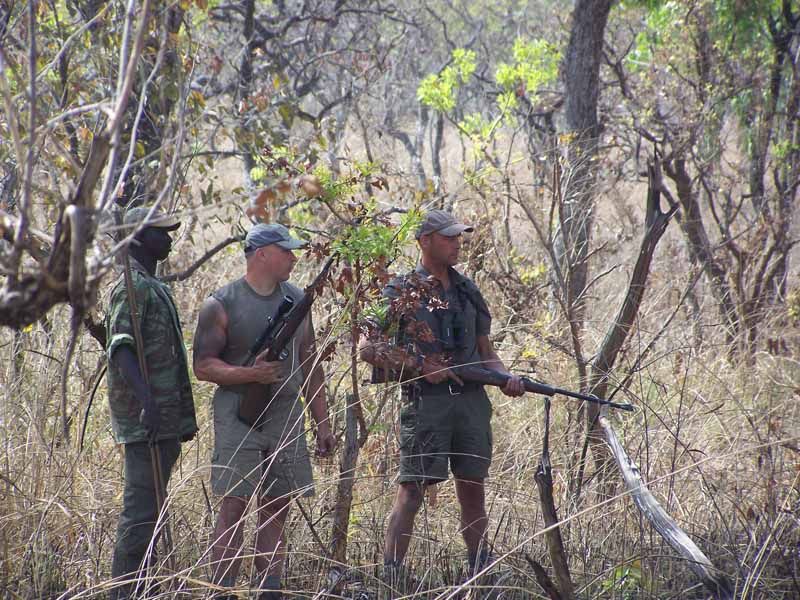  While this was not the tracking hunt that I had hoped for, he was the old, lone bull that I had been looking for. And really, dagga boys are often shot in this manner as they setup shop in an area that gives them all that they need (food, water, cover), and over the course of a few seasons the trackers and PH learn their whereabouts. As a hunter you may not always know this, but I can think of multiple situations where this was the case. I was getting enough tracking and stalking with the eland, duiker and bushbuck, and it felt great to get the buff down and cross him off the list. We had five more mornings to concentrate on the Lord Derby. Dagga boy...and old western buffalo: 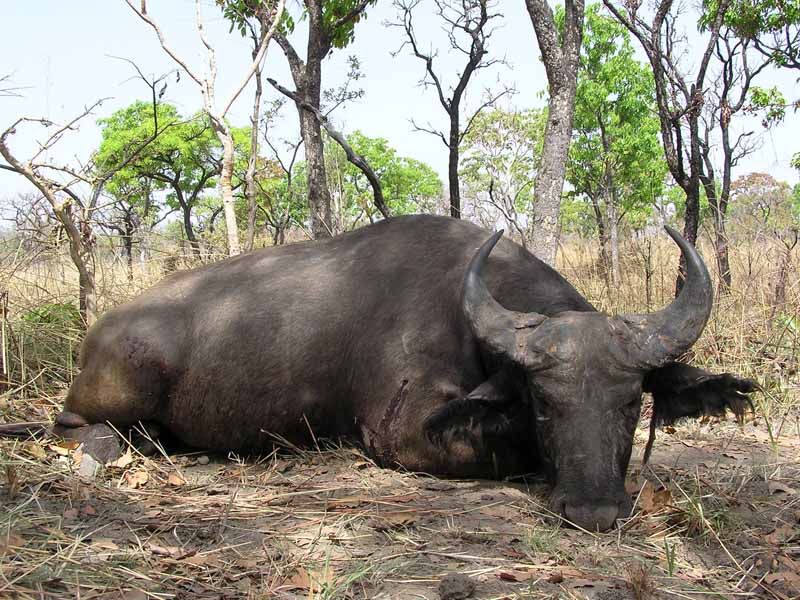 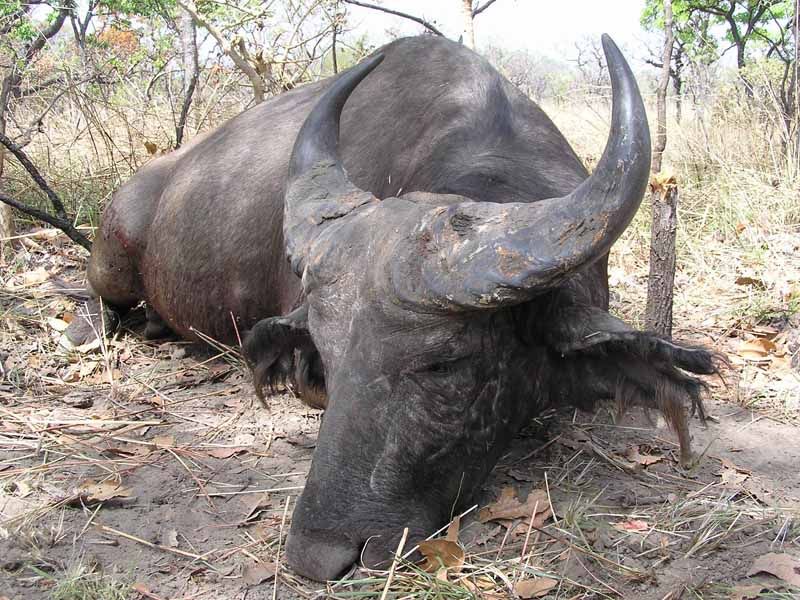 That afternoon, on the way to a fishing hole, we passed a decent bushbuck standing in some bush. It was the same general area where I had not taken the shot previously, and very likely it was the same bushbuck. We drove ahead and down a slight hill, out of site. The wind was good so we crept back. He was just crossing the road when I got setup on the sticks. The shot was perhaps 50 yards and struck him a bit high, hitting his spine. He was not the old broken horn bushbuck that I hoped to stalk along the river - he is still out there waiting for me and I will continue hunting bushbuck every chance I get - but we did not see another shooter the rest of the trip (ol'Mark Young is right when he says shoot when you have the opportunity!). The harnessed bushbuck do not have the long horns like those in the south, and 10 inches is considered good with 11.75 inches a book buck. The harnessed do sport beautiful coats, and this one is prime. Harnessed bushbuck:  Our driver took the bushbuck back to camp for prompt skinning after dropping us off at the fishing hole closest to camp. Our original plan was to go further up the Faro to a better location, but this would allow us to spend some time relaxing on the beach rather then going back to camp. Pierre & wife Claire getting frisky on the beach (an area jokingly referred to as Saint-Tropez): 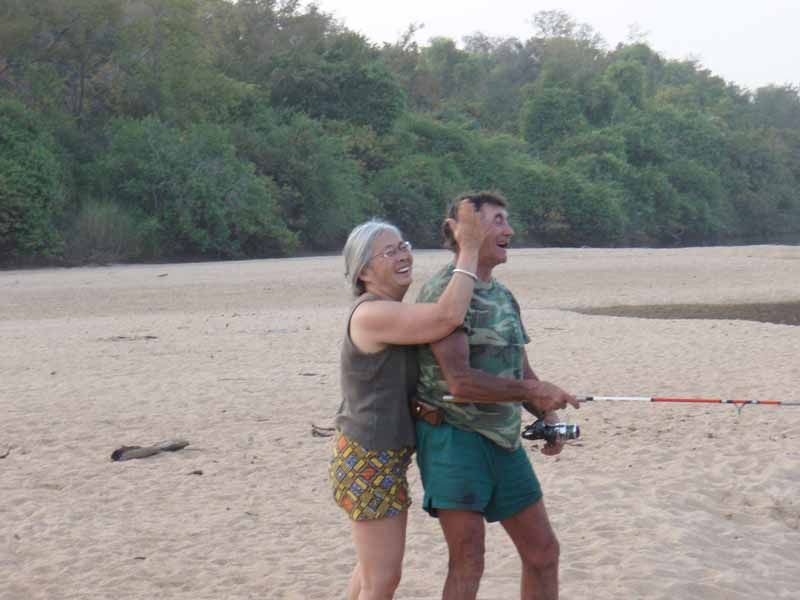 DAY-8 HUNTING I slept well, and woke before either the alarm or the chicken in the small staff village that crows every morning around 5:30am. Once again, there were lion calling off in the distance. I never expected so many lions and it reminds me of the Luangwa Valley although the prides there were much larger, containing many cubs. We had the Land Cruiser for the second day in a row. It is a bumpier ride then the Hilux but there is more room on the back and the seat is setup nicely, where one can either sit or stand in comfort. Some Cruisers that I have been in are poor in this respect, requiring one to sit or stand on crates. The plan was to try where we have been hunting one more time, and if this failed, we were going to head to an area by the mountains. One of the references that I had spoken to at great length said that he hunted this second area later in his hunt, and felt that it was the "honey hole" providing somewhat easier hunting. Malo sort of confirmed this, but was reluctant to give me a definitive confirmation. My impression is that when they get a guy who can walk, and who claims to desire the entire experience, they give him just that. Whereas for somebody who is less fit, or if it is getting late in the hunt, there are areas where the eland tend to travel less and it is possible to find one closer to the road. We inspected a few tracks, none of which were fresh enough to justify spending time on. At around 8:30/9am once again, we crossed good spore, which Koulagna and Malo determined was recent enough for us to follow. Fresh eland tracks: 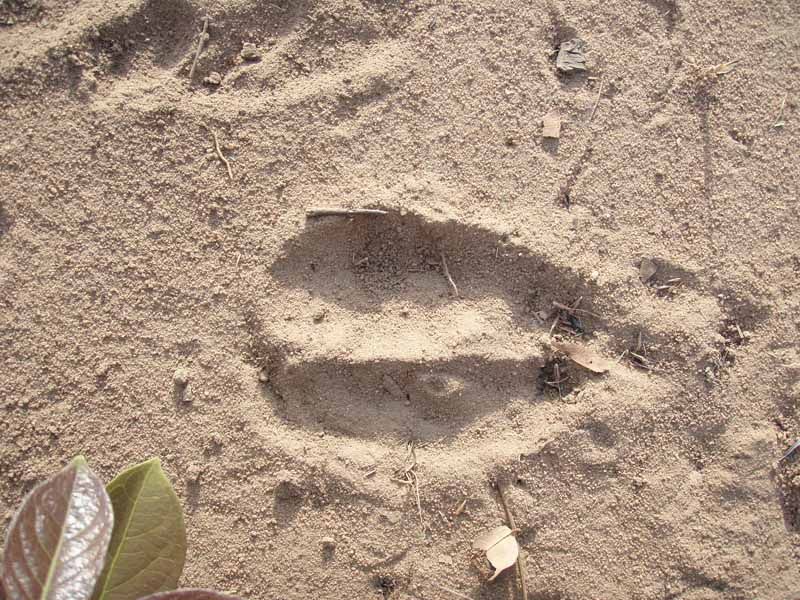 Tracking was difficult as the ground was hard, but we made constant progress with little of the start-stop that can kill the momentum. The droppings were not as fresh as hoped, but somewhat dry and no longer gooey on the surface. Tree uprooted by an eland bull: 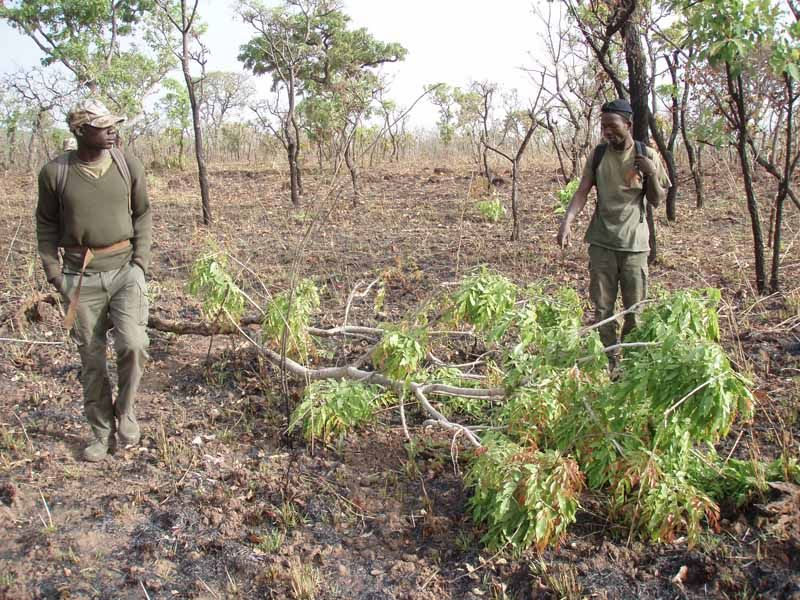 Fresh eland droppings: 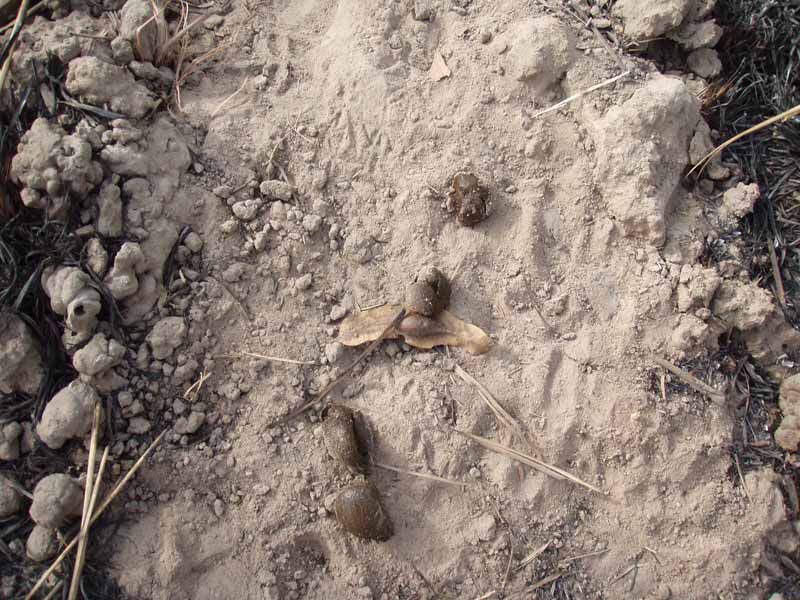 After about an hour, Koulagna made the decision that we were burning too much time, and that we should return to the truck and circle around to see if they had crossed the road by one of the salt pans. Too, the wind was bad, as the eland were walking with it to their backs. If they had visited the pan, and the spoor was not fresh, we would continue on to the mountains. It took about another hour to get to the truck and reach the salt pan, driving considerably faster then normal. Much to Koulagna's surprise, the eland had not crossed the dirt track. The wind was blowing from left to right, towards the pan. Malo and he talked, and after review I agreed that we should try to intercept the herd, walking into the wind. Too, perhaps we could spot them before they saw us, and instead of having to work our way through the herd of females and younger bulls, locate a big male towards the front of the herd. The problem of course was that this would be like looking for a needle in a haystack. And, time was not on our side as the afternoon heat and fickle winds were fast approaching. Koulagna led is to a small pool of water where he thought perhaps they had drank. He obviously knows the area very well, and can think like an eland. I continue to be impressed with Koulagna's abilities, poise and character. Malo and he are as cool-headed as any PH/tracker that I have hunted with. At a spry 66, Pierre is a plugger and has amazing energy and spirit. Combined with Saidou and Yaouba, I recall thinking that there is no way that they [the LDE] are going to continue beating us - our team just seemed to be clicking. It was Saidou that again spotted the herd ahead of us. Initially I was suspicious of this arrangement, one tracker in front and one behind. But it became clear that this works, as most of the time only one set of eyes is needed focused on the ground. With two trackers looking down, it is up to the PH and hunter to be looking ahead, and it is rare that they can match the eyes of the local hunters. By having Saidou behind and slightly off to one side, he is able to scan the horizon from a slightly different angle. After years of doing this, I am sure he can look at an area and think to himself, "If I were an eland, that is where I would be". I personally found that this is somewhat easy to do with elephant bulls. Malo, Koulagna, and I began our arduous and tedious approach. I tried hard to move when they did, stay in line and tight on Malo's heels, keep my arms from swinging, and remain low. The rest of the team stayed behind to watch the action. I found that most times when we had to stop our sneak, I was in an awkward position, and holding it for several minutes was painful. Too, I was carrying the rifle. If at all possible, I tried to get into a sitting position, although it took a second or two longer to get moving again. I remember thinking about a thread on AR where somebody said they use knee pads for crawling, which at the time seemed like a brilliant idea. Using brush in front of us as well as behind for cover, we worked our way to a small patch of bush. We were as close as we were going to get, 175 to perhaps 200 yards away from the herd. A few of the eland mulled around as others lay in the short grass, only the tops of their head and horns visible. To the naked eye they remained difficult to spot until they moved. We knew there were a few bulls in the herd given the spoor that we had seen earlier in the morning, the trick was to find them. I was in the full sun whereas Malo and Koulagna were shaded by the bush. Still, time passed somewhat quickly and I was surprised when Pierre said he was checking his watch and we were there for one full hour waiting on the eland to make a move. We could have been there a lot longer had it not been for some nosey kob. A male off to our left had gotten our wind, and from 150 yards looked right at us. Fortunately he did not spook the eland herd. However, four female kob had been feeding in our direction for some time, moving left right to left. They passed not more then 20 yards in front, but the last one sensed something and began starring intently directly at us. Unsure of what we were, she stamped her foot and barked, alerting the others. This went on for a good 10 minutes, before they finally ran away and straight towards the herd of eland. This excitement was enough to stir the eland, who began to move and rise from their beds. We stood and I set the .375 up on the Long Grass shooting sticks, heart beginning to pound. I began to prepare for the shot that was taking a long time to develop - "breathe, crosshairs on the shoulder, head down, and squeeze..." A big bull appeared, and Malo and I both saw him at the same time. He was raking his massive horns on a small tree, and it was easy to see with the naked eye the green leaves of the tree shaking violently. "Moving the tree, do you see him". "Yes, I got him". During December into early February, the bulls have a dark black neck making them stand out from the females and juveniles. This one made it even easier by telegraphing his position. We did not hear the bullet strike, but Malo said he saw the bull jump and run first back, then in the direction that the herd was moving, off to our left. We discussed the shot, and I said that it indeed felt good. But it was long for me, and even a huge animal like an eland looks pretty small at that distance at 5x. We located the tree, and the deep hoof prints indicating a hit. There was no blood, however. The three trackers spread out in front of us, and followed the herd. They were walking with the wind to their backs, but at this point it mattered little. I was shocked by how slowly they were moving, and within a few minutes we were on them again. Following the eland herd looking for the bull: 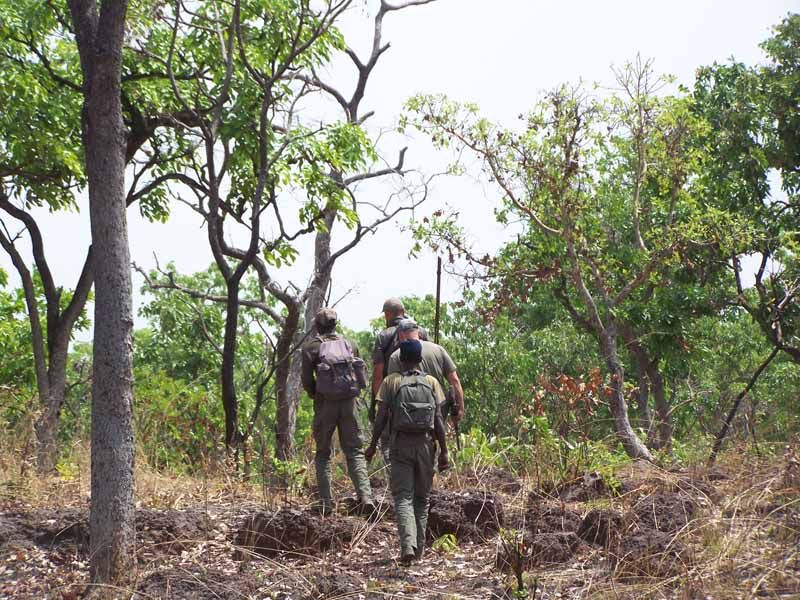 The trackers became excited, and Malo said "There is your bull, shoot him". He was quartering towards us slightly, and somehow in the excitement I missed! I heard a loud wallop, which must have been a tree, possibly behind him. He ran and we sprinted after. He was loosing huge amounts of blood now, and when we came up on him he was standing still, back to us, head dropping. I gave him one in the hindquarters angling towards his chest, breaking his hip. Heavy blood trail leading to the bull & the final shot: 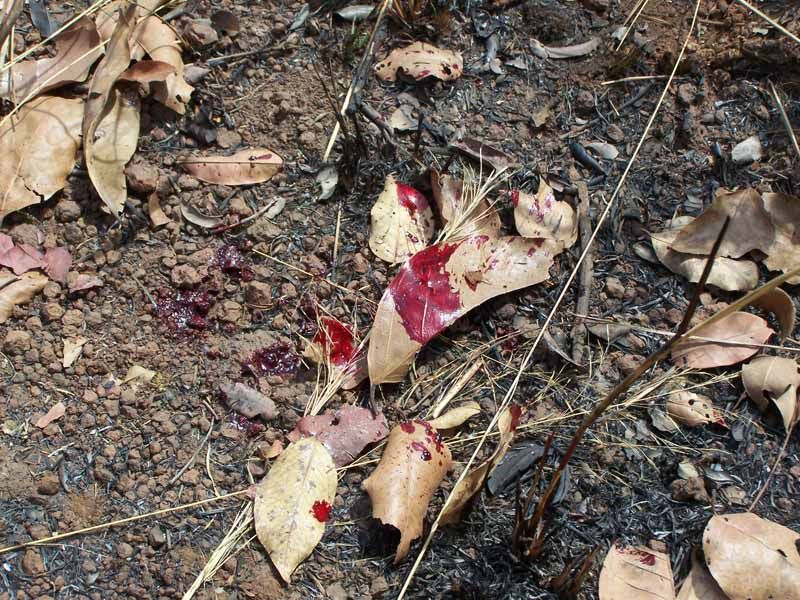 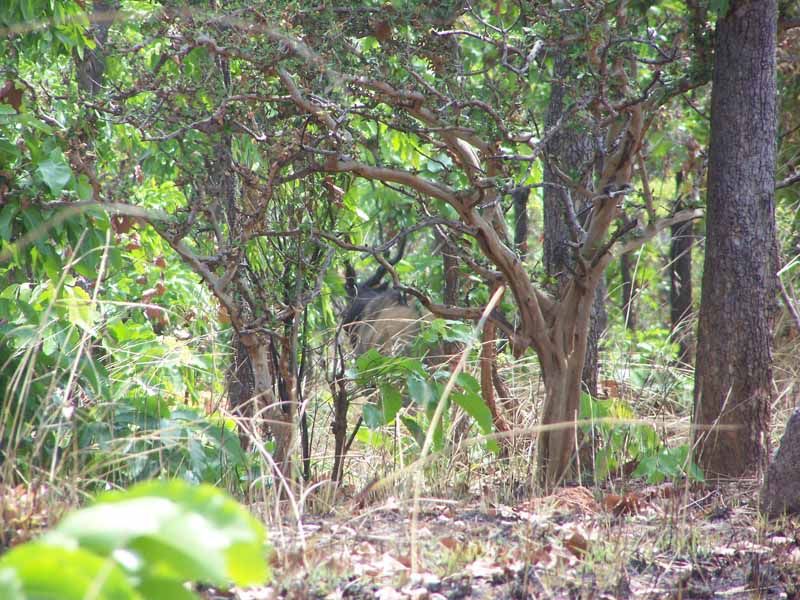 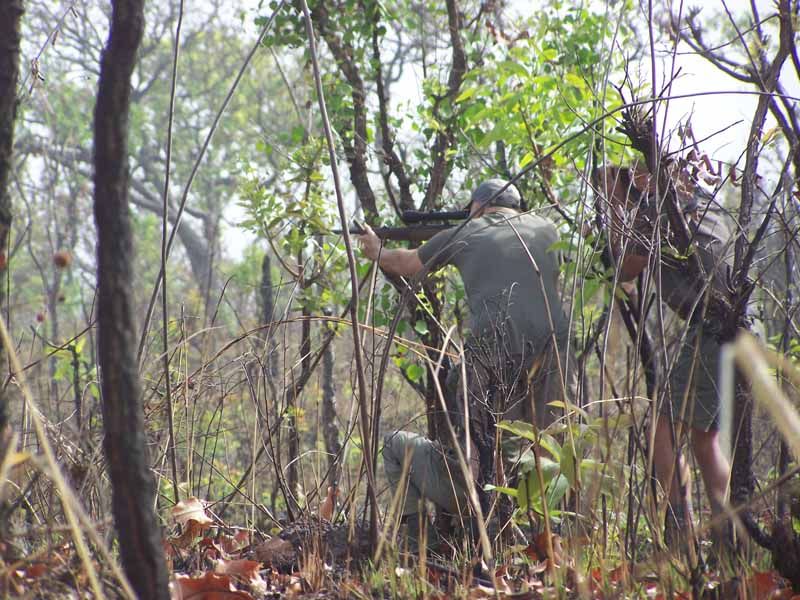 A few yards later he was down - the magnificent Lord Derby Eland was mine! I am a pretty reserved person, but this was too much and I was overcome with emotion, as was the rest of the team. The eland was strong, and by rights that first shot should have anchored him but Koulagna said that like with buffalo, the herd can carry the bull further then he would otherwise go. The reason the herd was moving so slowly was that they were waiting for the wounded bull. The lack of blood confused me as I tried to piece it all together. The trackers said that the wound did not bleed right away, despite it hitting the lungs, and the .300gr soft did not exit. They had been following the herd as this is quickest and easiest, and the bull was actually off to our right where there was indeed a blood trail. My Lord Derby was "ideal" - an old bull of approximately 12-14 years, carrying worn and characteristic horns (one of which was starting to chip) that met the Rowland Ward minimum of 45 inches, with a thick and heavily muscular neck and saggy dewlap, sporting a distinguished dark black mane and shaggy mop. Lord Derby Eland: 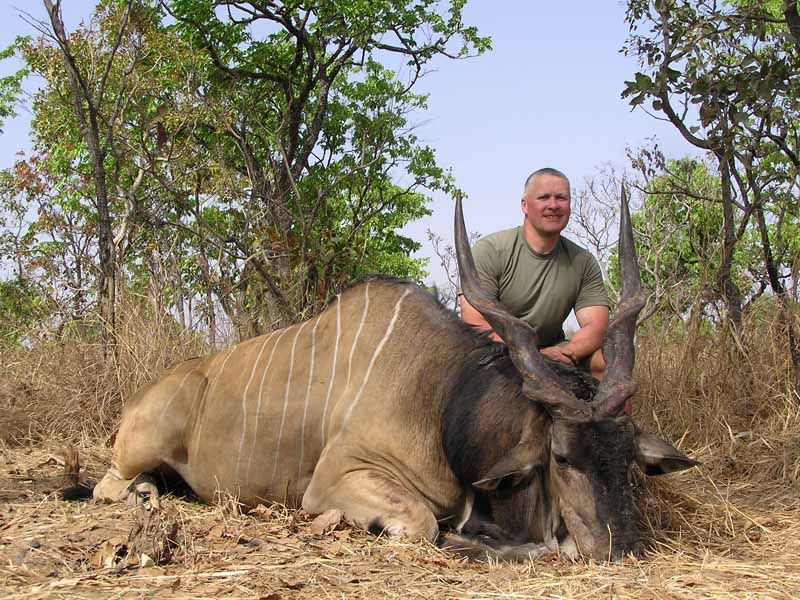 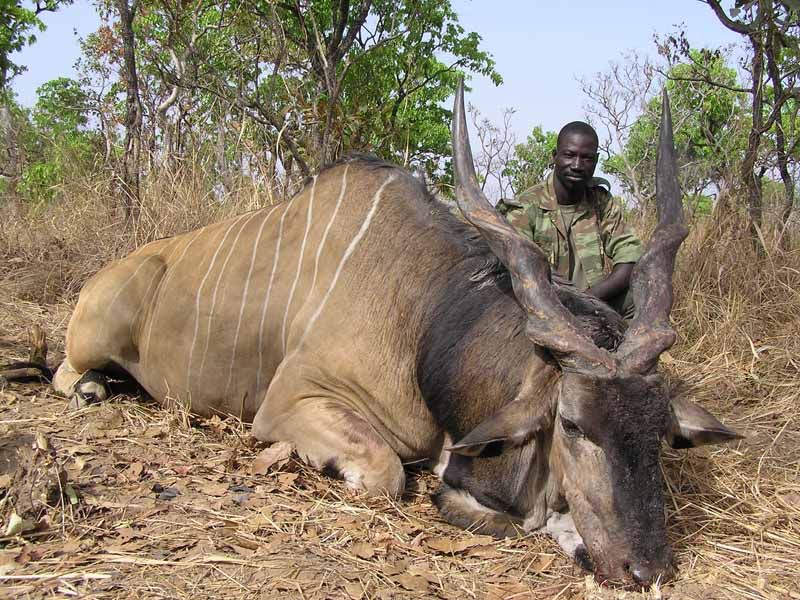  It took about an hour for the truck to reach us, and another to butcher the bull for loading into the Cruiser. I was told by a French hunter that I spoke to that I should bring a head net, as once the eland was down, the mopane flied (bees) would swarm. I had seen only a few the entire trip, and since I of course had no idea when the LDE might be shot, the net was back in camp. They were not too bad, but later in the season (March) when things heat up, I would likely carry the head net with me.  Upon entering camp, the trackers sang "eland est mort, eland est mort" (The eland is dead!). That night we celebrated with a $90 bottle of champagne - Laurent Perrier. 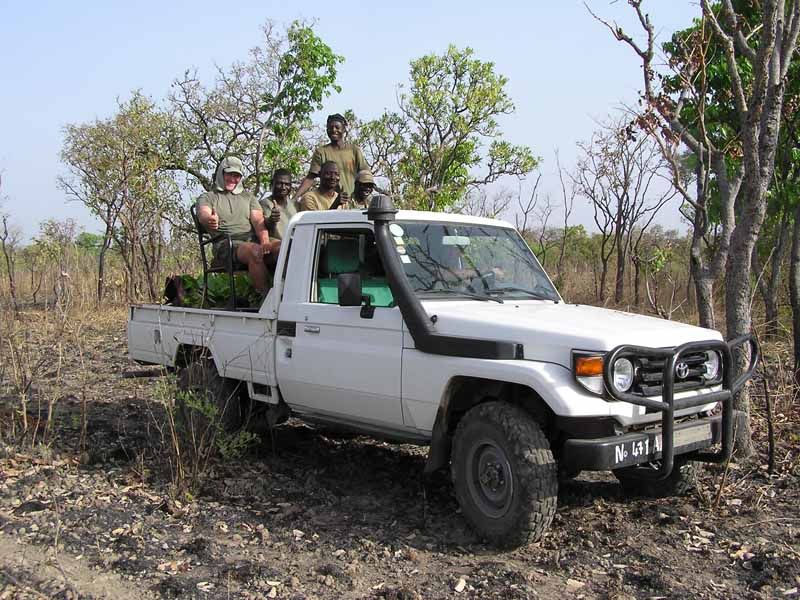 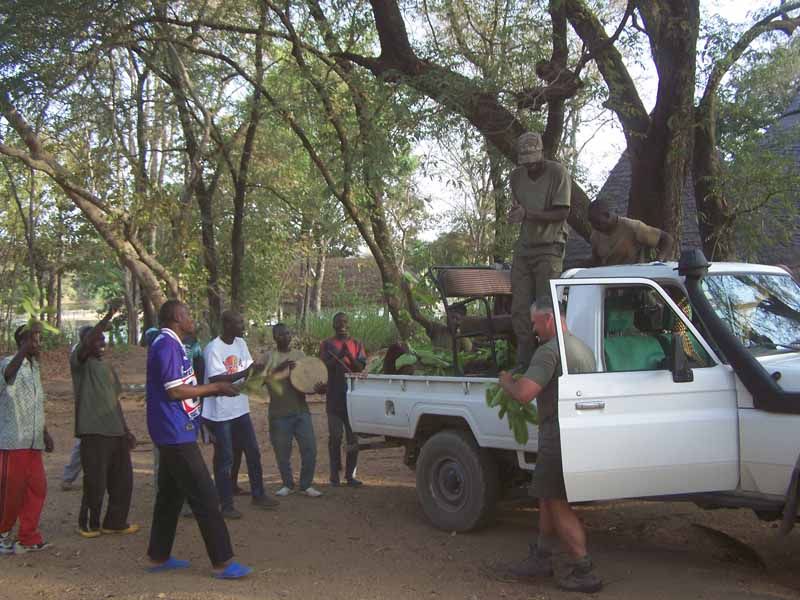 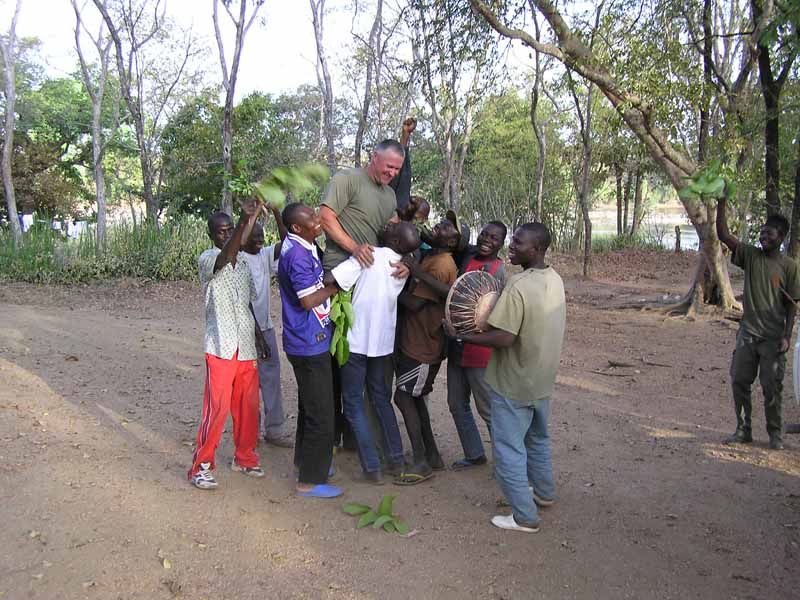 DAY-9 HUNTING It is amazing how one glass of champagne gives me a headache the next morning. We relaxed today, but still stayed quite busy. In the morning we fished Hole #3, which is about an hours drive from camp, heading west. On the way we passed through an area of tall savannah grass and acacia thorn which is left unburned. There was considerable elephant sign here, and we saw one herd with perhaps 25-30 elephant. They were more skittish then I would have expected, as we drove the track the herd split to either side, disappearing into the talk grass and trumpeting wildly. The bulls in the Cameroon do not carry much ivory, and a mature 20/25-pounder is considered a shooter elephant for the area. Malo said that they shoot one or maybe two per year, but that they need to manage the population carefully. We had two bulls feeding close to camp one night, otherwise I did not have any elephant encounters. In the evening we again walked the bako bordering the Faro, and saw quite a bit of game including four bushbuck (young or females), two female red duiker, two male red duiker (sneaking away before we were able to judge and get into position to shoot) and colobus monkey. Dinner was fresh Nile perch courtesy of Yaouba, and we were joined by a hunter from France (Deni) and his travel companion (Monica). Cameroon savannah: 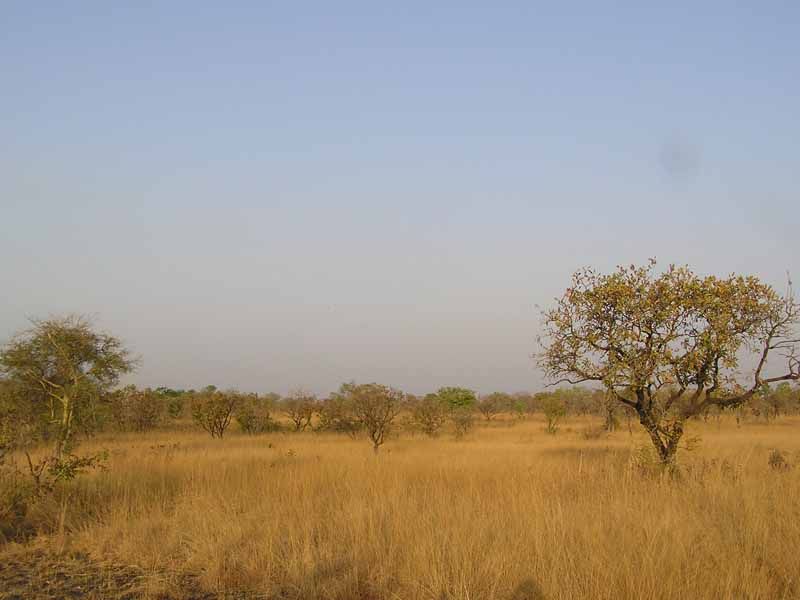 Bushbuck:  Yaouba with his catch of two Nile perch from Hole #3:  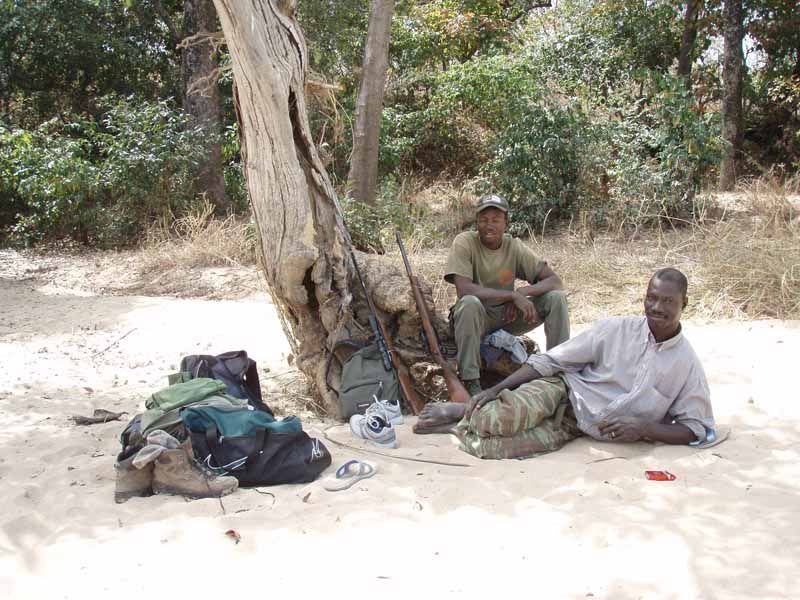 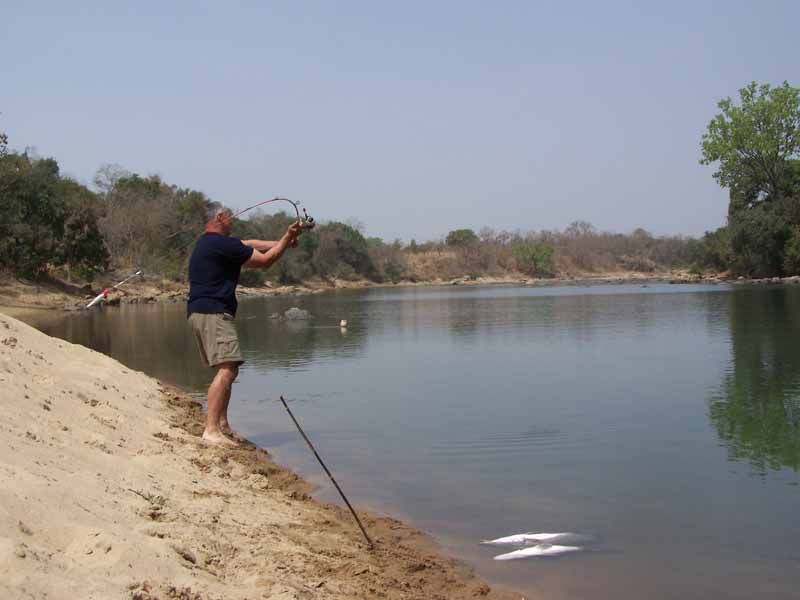 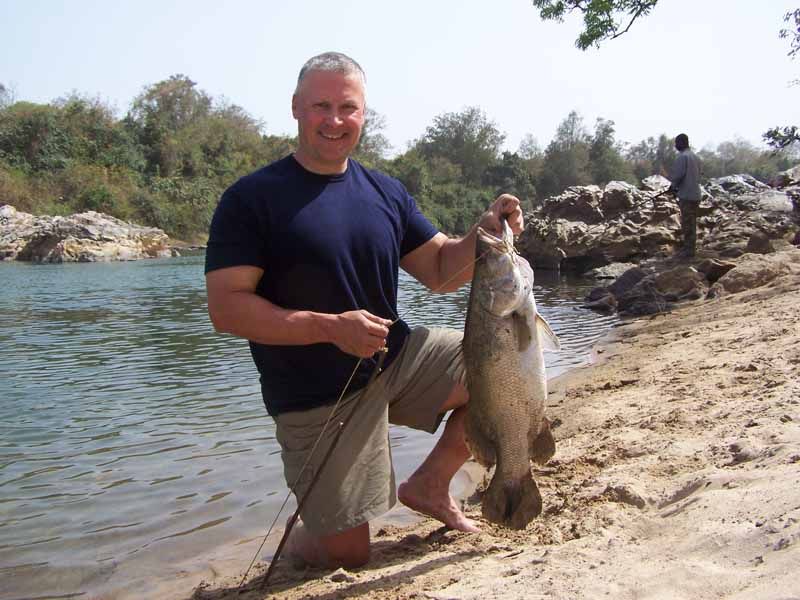 Hippo with crocodile in the Faro River: 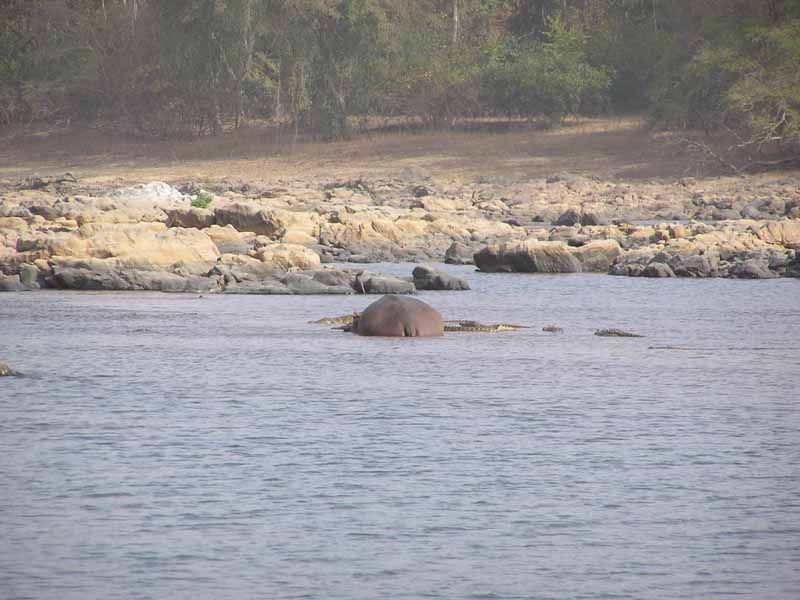 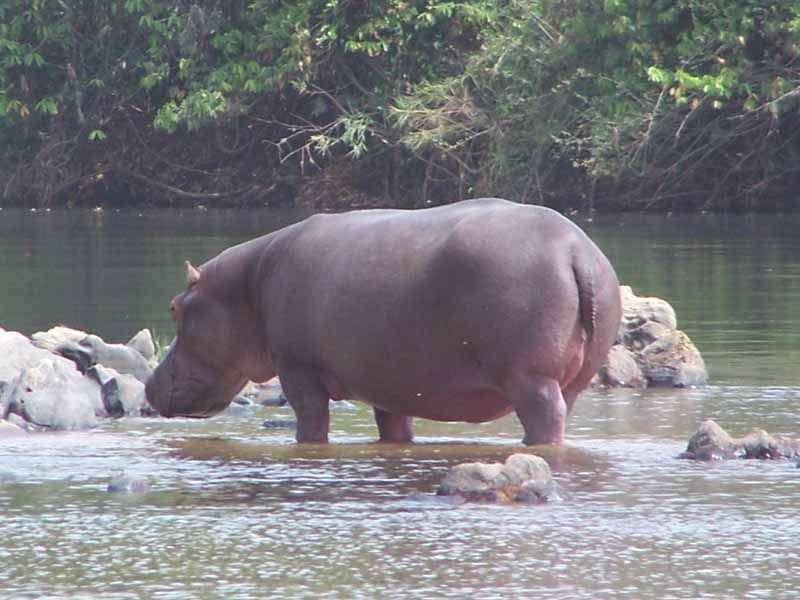 Roan bull: 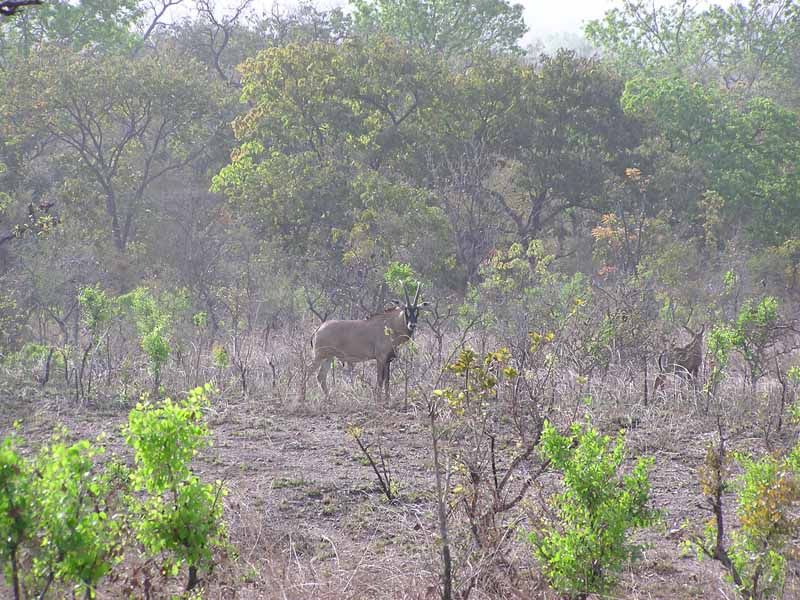 | |||
|
| one of us |
DAY-10 HUNTING The plan this morning was to drive to an area downstream of Fishing Hole #2, sneak in through the bako looking for red duiker, and meet the driver and Claire with the fishing equipment at the fishing hole. I was using the .22Mag, which was far lighter and easier to carry while quietly walking through the crunchy jungle-like canopy of the bako. We saw quite a bit of game, and almost got setup on a nice red duiker, but the female he was traveling with sensed us and they ran off into the grass bordering the forest area. My respect for the red duiker prompted me to note in my journal that evening, noting this is likely applicable to most/all duiker and bushbuck hunting: 9 Reasons Why the Red Flanked Duiker are Worthy Adversaries when Hunted on Foot: 1. During the typical hunting season, the ground is littered with leaves, branches and vines making it difficult, especially for a group consisting of a tracker, hunter, PH and spotter, to remain quiet. 2. The wind is inconsistent in the bakos, and the longer the group lingers in a given area the greater the build up of human scent. 3. Red duiker are very switched on and alert, always looking around for any sign of movement. 4. The other animals in the bako are friends with red - baboon, bushbuck, birds, colobus monkey - all conspire to announce your presence. 5. As soon as the reds sense danger, they dart into the tall grass adjacent to the bako, where they are nearly impossible to see as they sneak undetected through and under the sea of grass and bush (their name comes from the Afrikaans word for "diver" and refers to their practice of diving into bush and grass). 6. Once spotted by the tracker/spotter, it takes a bit of time for the PH and hunter to confirm that it is a male of decent size and age, and for the hunter to get in a shooting position (the sticks or natural vegetation) to take the shot. 7. Reds are random in their movement, so even once on the sticks, they tend to dart this way then that. You anticipate them entering a clearing, but they go the other way, which requires setting up again and more time and movement. 8. Red duiker are small targets, and the bako is thick with tree limbs and vines, making it difficult to make a clean and accurate shot. 9. They are cute. However, after repeating steps 1-8 a dozen or so times, this becomes much easier to deal with. The thick jungle-like vegetation of the bako forest (riverine forest): 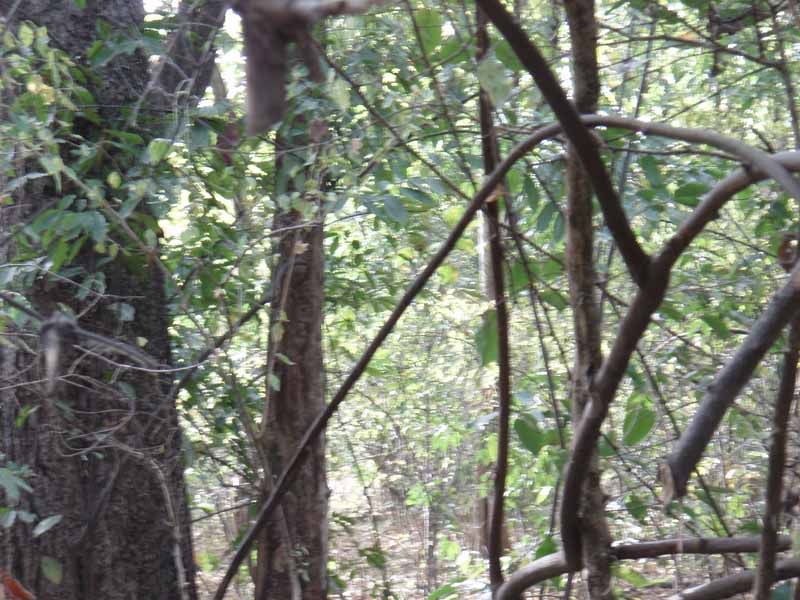 I had excellent day fishing, catching one tiger and three nice Nile perch. Hole #2 was my lucky spot! In the evening we walked the dry river bed and bako closest to camp by the shooting range, and saw quite a bit of game but no shots were fired. At dusk we walked into camp, empty-handed but content. Tiger fish, called binga in French & gnaou in the local Fulfulde language:  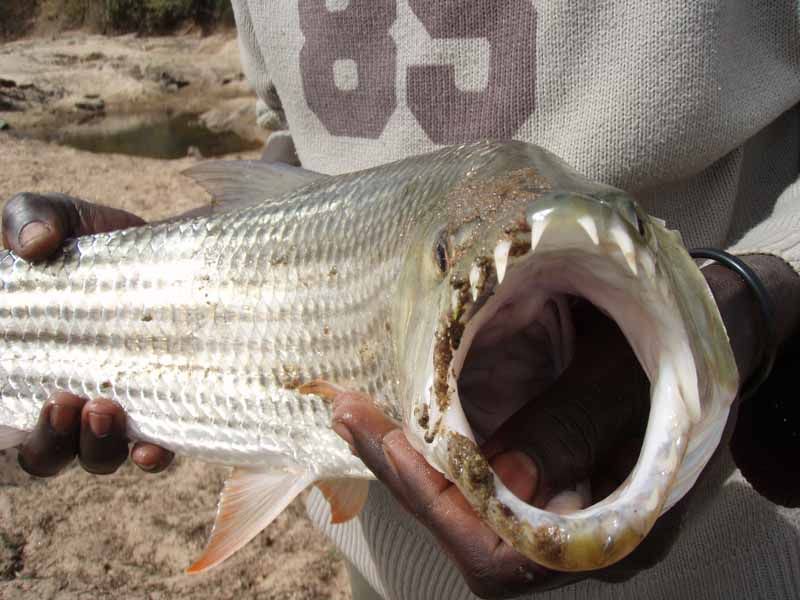 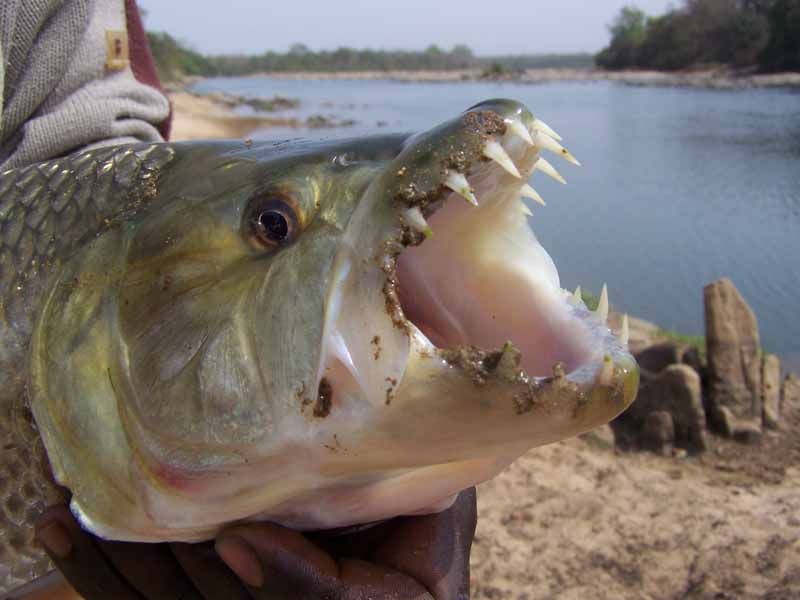 Nile perch, capitaine (pronounced cap-e-tan) in French & pella in Fulfulde: 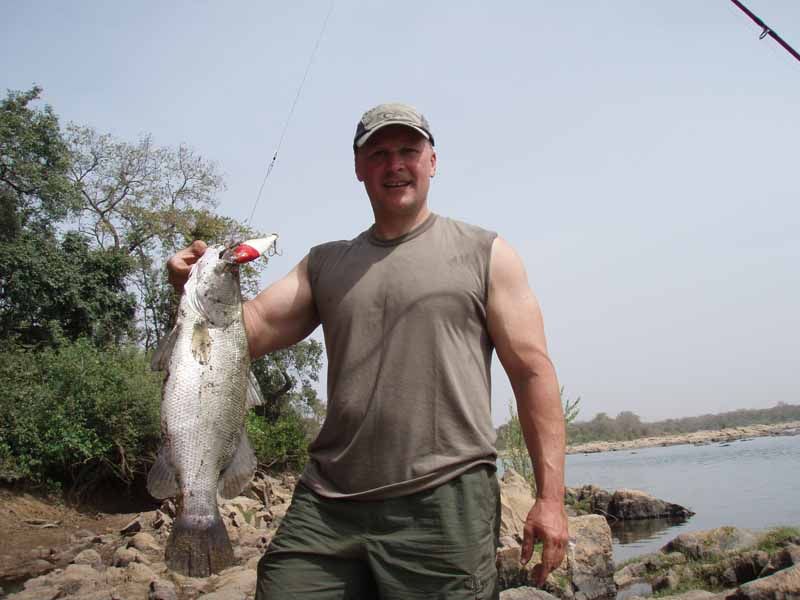 Pierre with his nice capitaine: 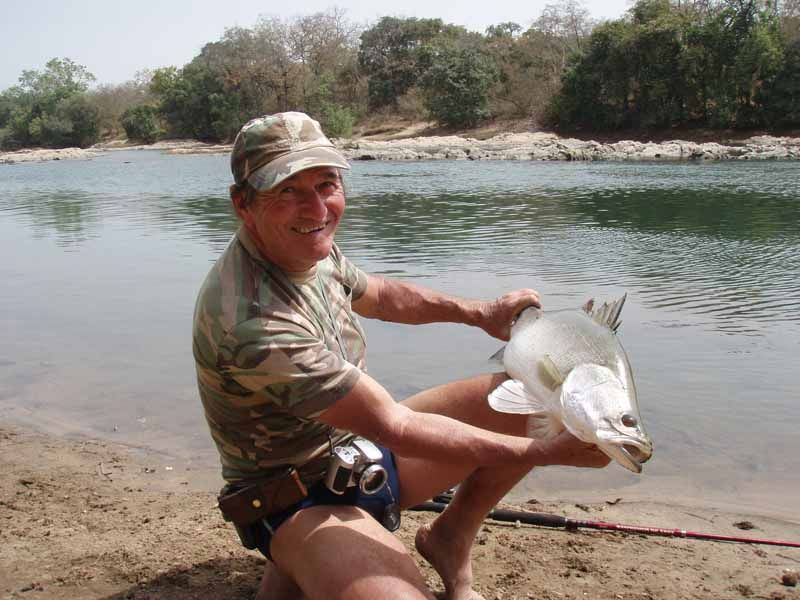 Vervet monkeys around camp:  DAY-11 HUNTING We repeated yesterdays hunt, but today the outcome was slightly better! Shortly after not being able to get a shot on a single red male, the tracker got "birdy" - it was the same pair that had eluded us yesterday. And just like yesterday, the younger female sensed us and ran into the grass, taking the male with her. This time, however, the male had not seen us, but simply lowered his head and ran after his squirrely mate. Souleymane, my new tracker, conferred with Saidou and Yaouba, and we decided to stalk into the grass and see if we could get lucky. As we slowly crested a slight rise, Souleymane saw the male sneaking towards us, probably wondering where the heck the frantic female had ran off to this time. I got on the sticks quickly and made a perfect shot on the point of the shoulder with the .22Mag thanks in part to the excellent 6x Schmidt & Bender scope with German style reticle. The duiker ran back into the bako, where we found him not more then 40 yards away. Finally Big Red was down!!! It may seem silly, but my exuberance rivaled that of the Lord Derby. Pierre & tracker Souleymane "sneaking" thru the crunchy bako:  Fruit being eaten by the duikers: 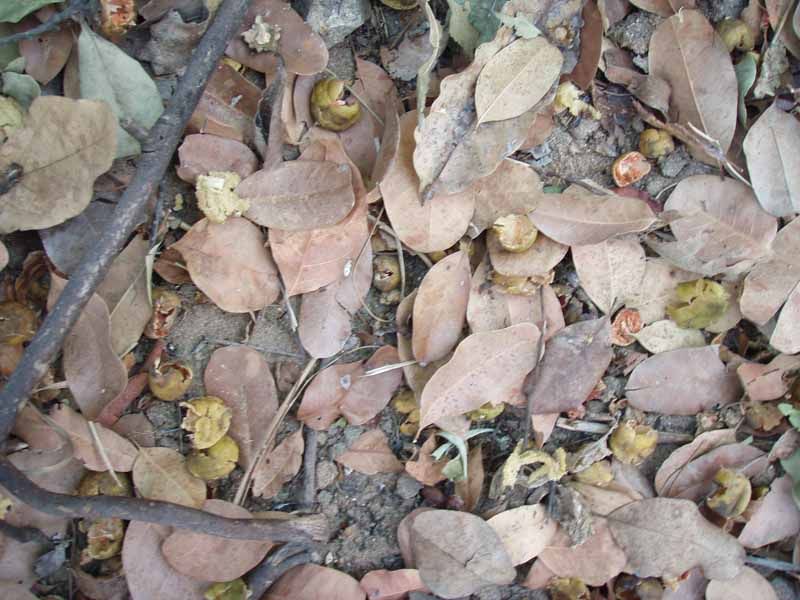 Big Red at the location as recovered: 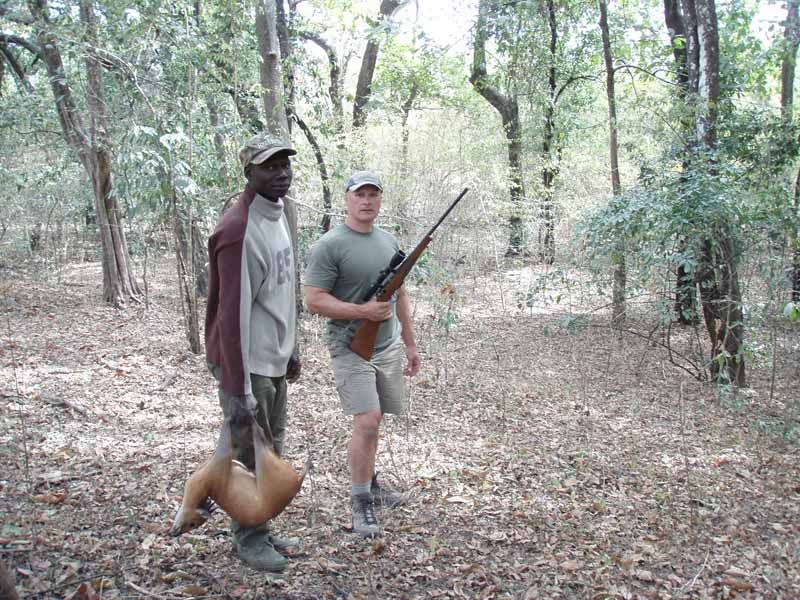 Trophy picture, oddly enough the same exact location as with the Grimms: 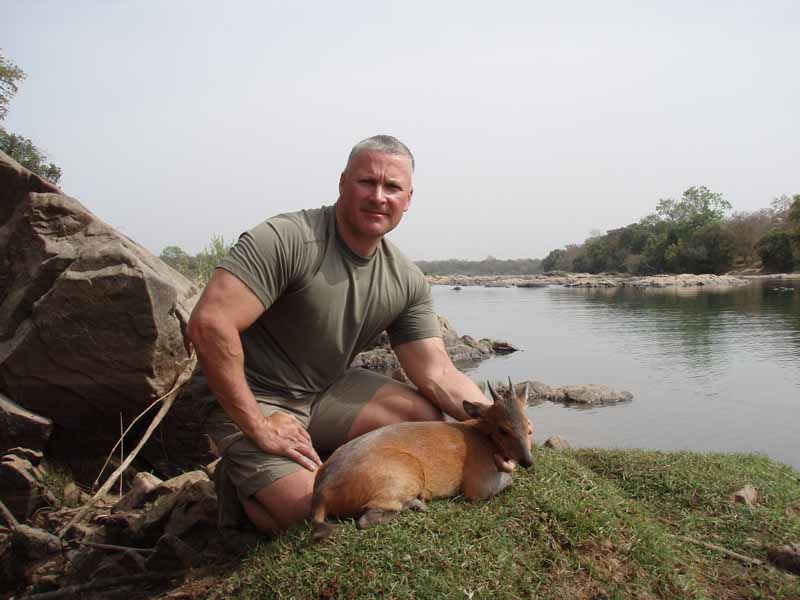 Note the grey hair on the back and legs indicating an older animal: 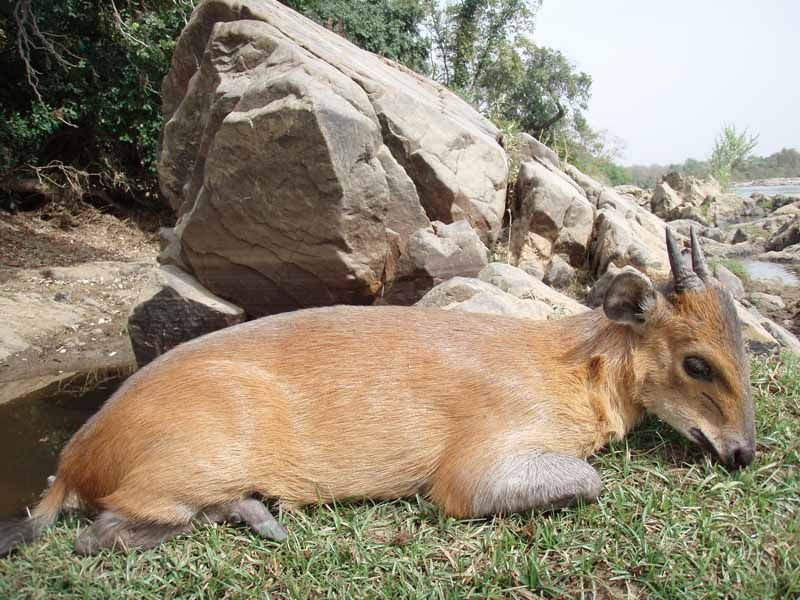 We took the duiker directly back to camp so that he could be quickly caped for a full mount. I hung around camp and enjoyed the scenery, ate a leisurely lunch, and talked with Deni (via Pierre) who was struggling with the heat. We left camp at 4:30 for a location further down the dry river bed where it widens and we had seen a large flock of guinea fowl. It was a short drive past the Gold Diggers village to the river. Souleyman herd the GF almost as soon as we entered to sandy bed. Thinking they might be coming to us, we waited, but after 10 minutes the decision was made to go in after them! The little .22Mag was a joy to shoot, and my first shot was a long 100 yards on a tender hen. It was great fun, especially the two shot out of a tree. Unlike a standard .22 which I used in Zimbabwe, the .22Mag really hit them hard and all were bang-flops. The Winchester Hollow Nose Soft Point ammunition worked well and did not destroy much meat at all. I shot 3 on 3 shots and Pierre was 1 for 1, which was two each and dinner for us and the guys. I called home and spoke to the family on the Thuraya, which provided a crisp and clear connection with virtually no distortion or delay. WHAT, the Giants won the Super Bowl - ARE YOU KIDDING!?!?!? The Gold Diggers village & hole dug by them looking for gold:  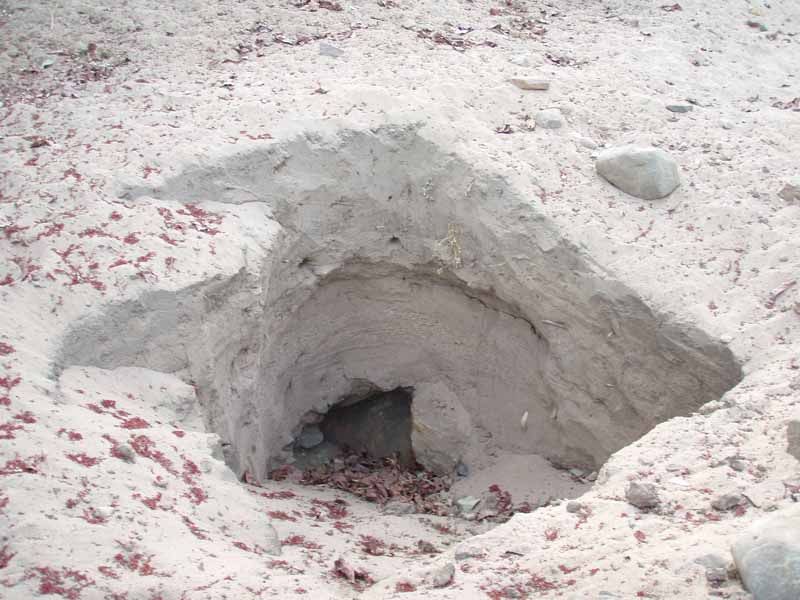 The results of 20 minutes of guinea fowl hunting:  "Yes you keep the males but give Robert the hens for our dinner!" 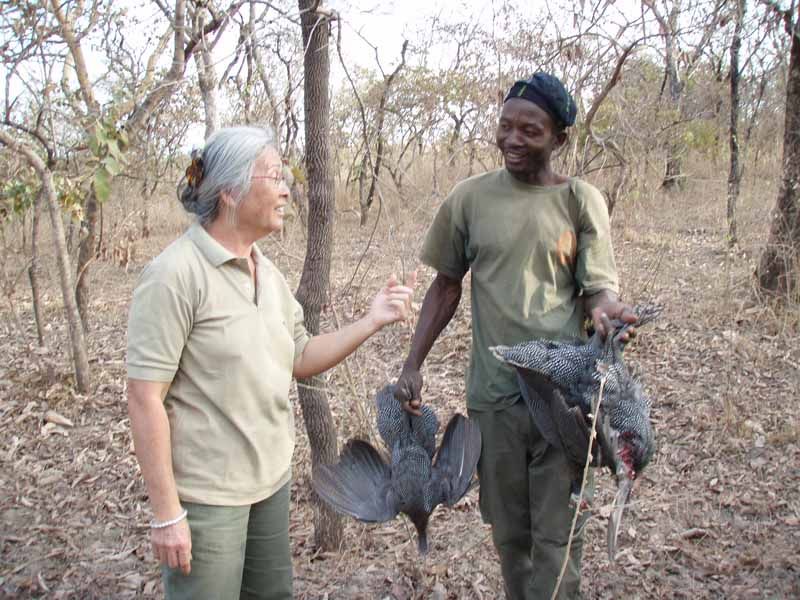 DAY-12 HUNTING With my Big Game License filled, and this being my last day (or so I thought!), we took it easy today. Malo asked us to drive to a distant salt pan to replenish it, clearing the road on the way. We did not see much game other some kob due to the tall grass which had not been burned, but the scenery was beautiful. Although not nearly as pretty, the burned areas hold considerably more game. 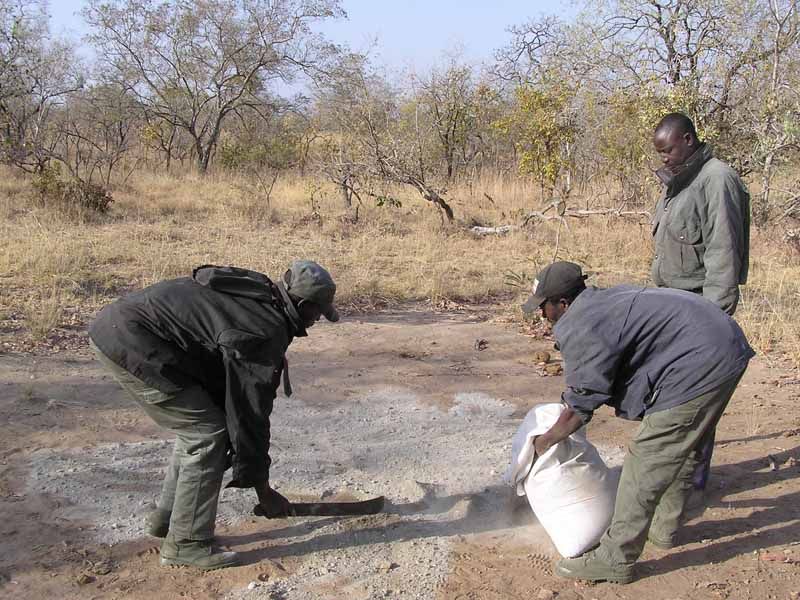 Traveling alone and without a firearm, I was able to bring a second suitcase which I filled with goodies for the children. I confirmed with Guy before leaving that there were villages close to camp which we could visit, however, I did not realize that most of the staff and trackers had their families with them at camp. This is a terrific arrangement for everybody, and gives one an indication of the long-term approach Guy takes to the hunting area and his people. Although I am sure it can create some management headaches, it is best for the family and it helps keep the guys stable and focused. And it makes for a neat environment for the hunter - one can witness the daily and direct benefit of their presence, including the meat provided. The village at camp for the staff & their family: 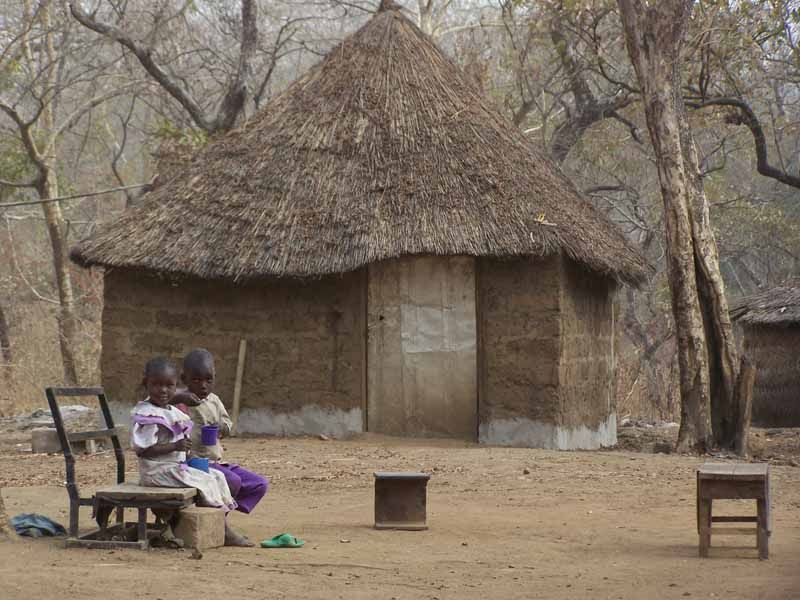 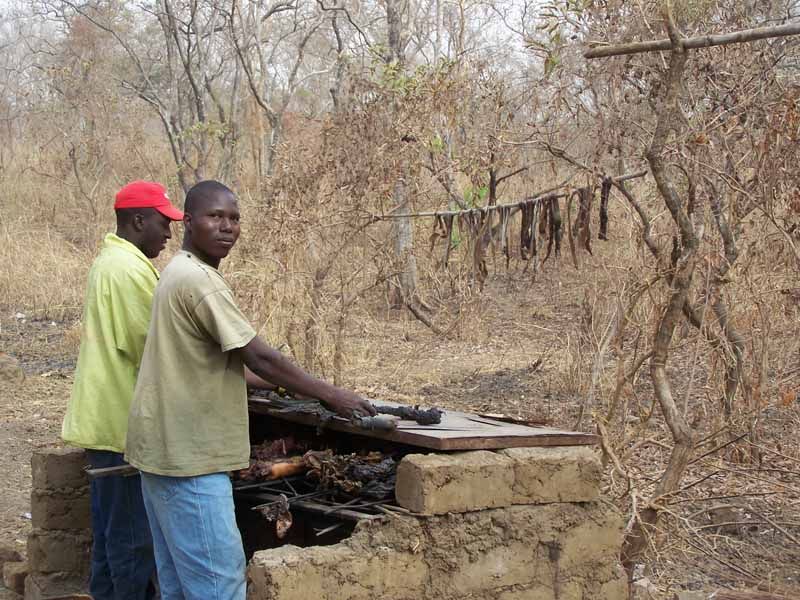   Pierre worked with JB who is sort of in charge of the camp village to obtain a list of the children and their ages. There were 28 children on the list! I spent time the day prior organizing the gifts that my daughter and I had obtained prior to my departure, and fortunately I had enough for each child. It was all very organized, and they came to us with their father to select their present and get a few candies. The children were very polite and quite shy, most of them clinging to their fathers. It was refreshing to see the trackers and staff in this capacity. For me, there is so much more to a safari then just the killing of animals. Distributing gifts to the children in camp (pictured Koulagna, JP, Saidou): 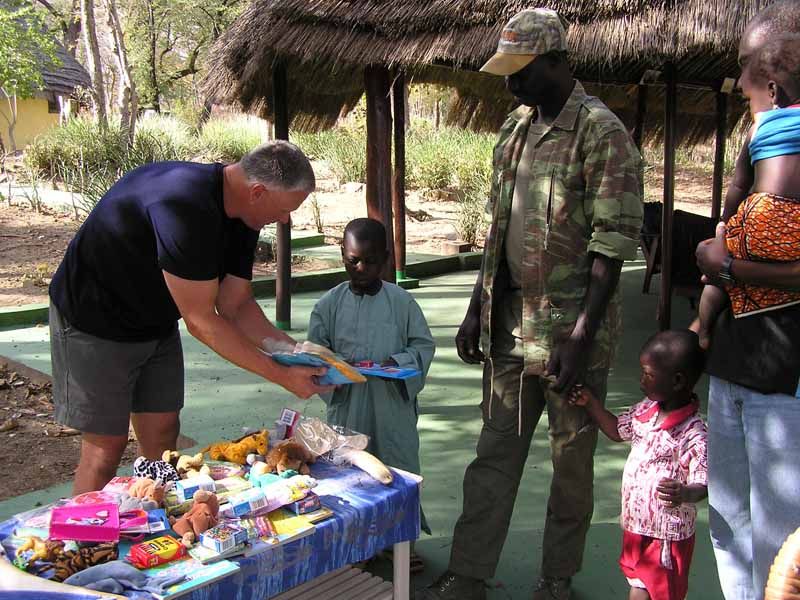  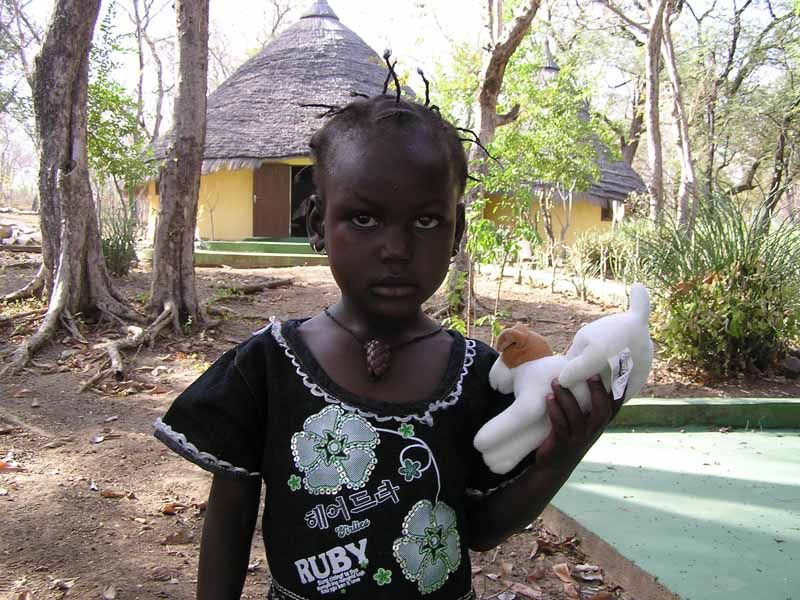 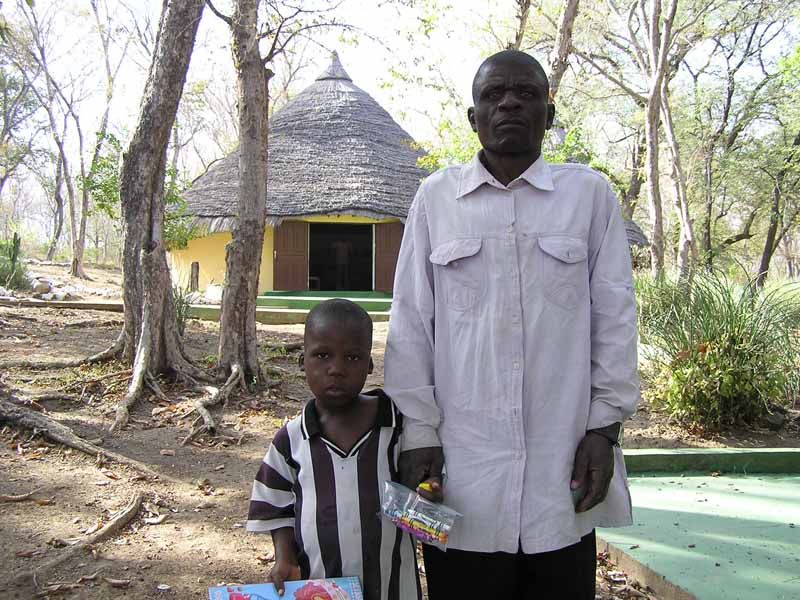  Evening game drive to TRY to take good pictures (kob, western hartebeest, red flanked duiker & western buffalo):  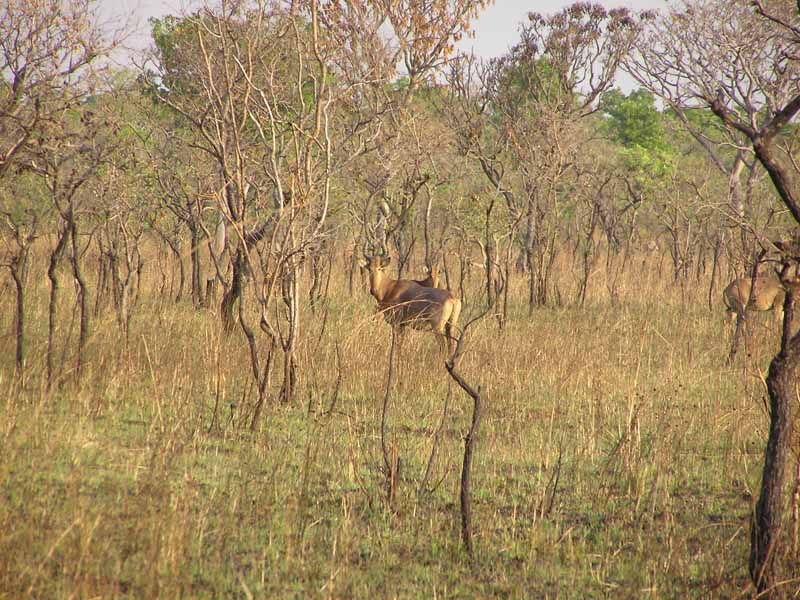 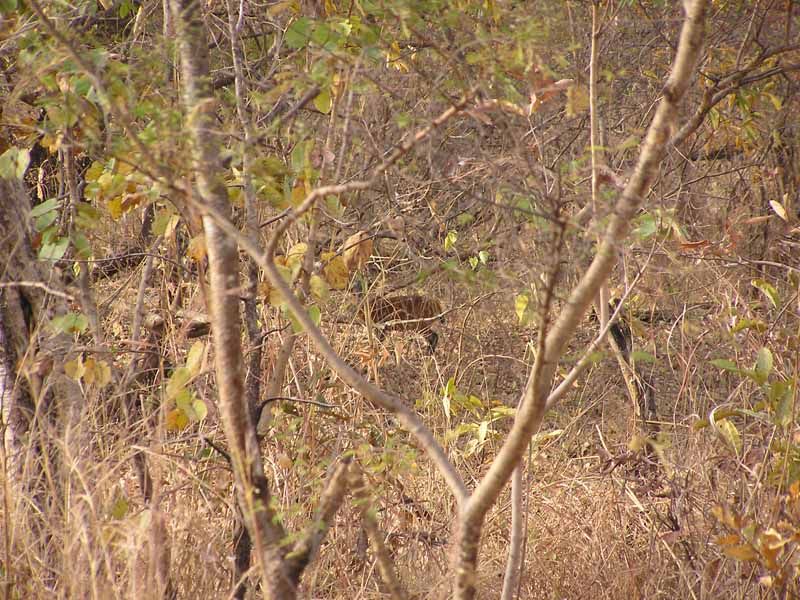 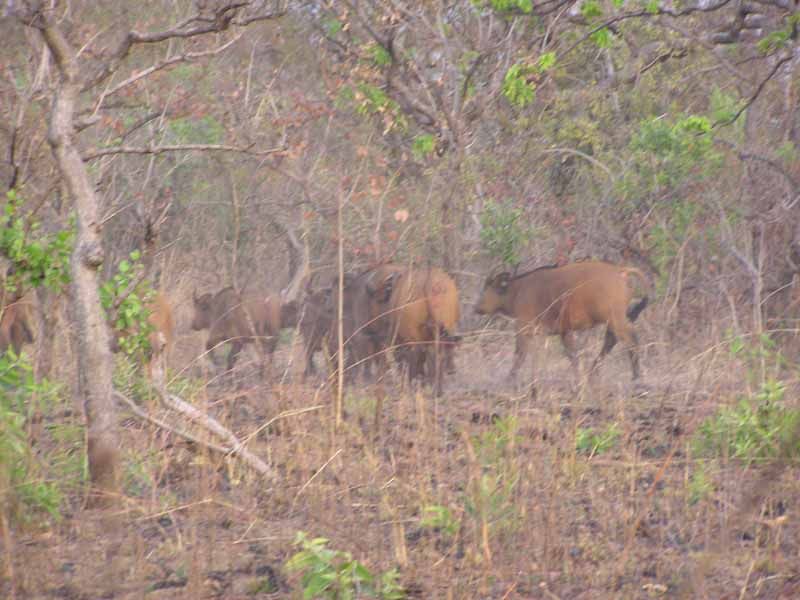 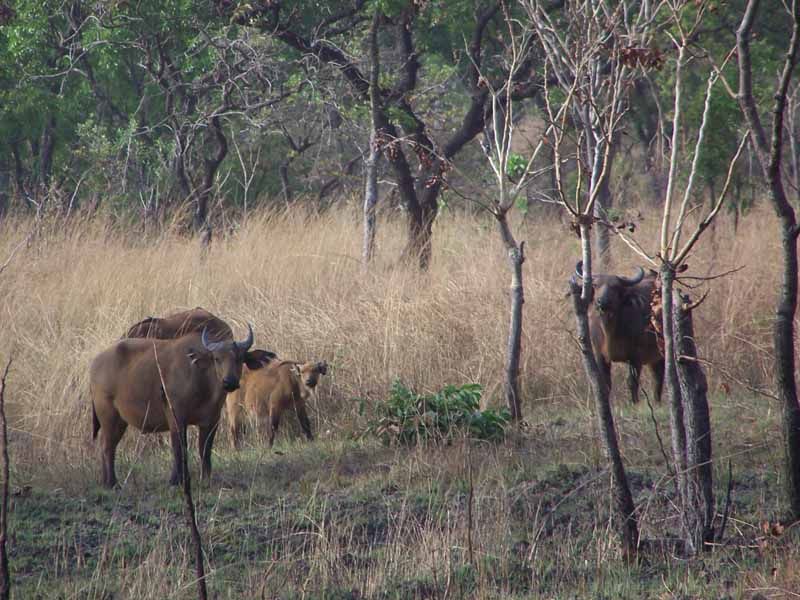 That evening, I got word via Guy that Cameroon Airlines was not flying, and my choices were to stay in camp for a few days as there was indication that they would resume the schedule, or make my way to Douala then Paris by other means. Although Guy and Malo could arrange for English speaking assistance at every step, this was less then appealing AND I would need to re-purchase the two flights. So after settling up the bill, I spoke with Guy via satellite phone, and we agreed that I would stay in camp as a guest until it could be sorted out. DAYS-13 & 14 - BONUS DAYS Pierre, Claire and I spent the days fishing, shooting guinea fowl, walking the savannah and bakos looking for game, taking pictures, swimming in the Faro, enjoying fine meals - including my Nile perch and Guinea fowl - and generally just savoring the simple things that a camp along the river can offer. Pierre joked that I might have to stay another two weeks, as he was enjoying the company and companionship, as I his. Malo even asked point-blank if I wanted to stay and hunt buffalo and roan, tempting of course as I was already there, but neither family nor office was thrilled with my situation, and I felt as though I better not push my luck. At the time I wanted to get home considering that I had no idea when the next CamAir flight might be, but looking back now one week later, I am very glad that it worked out like it did. More fishing along the Faro: 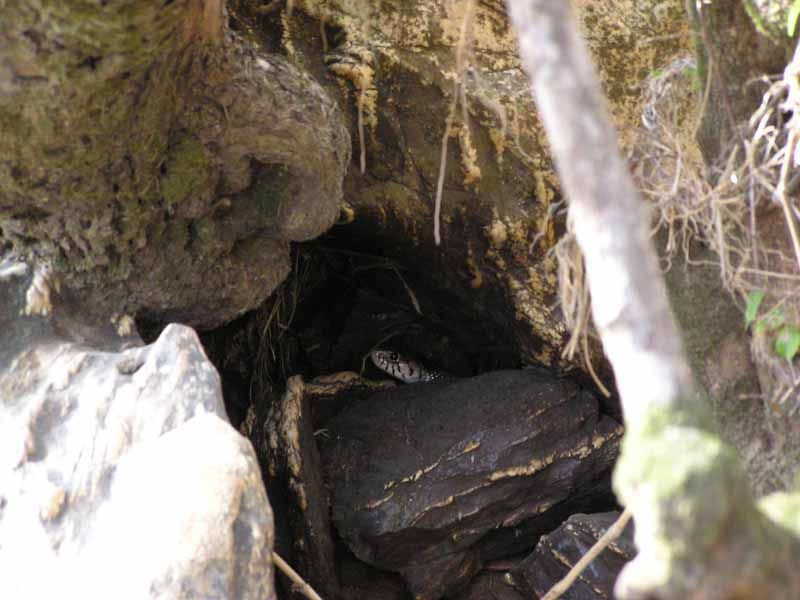 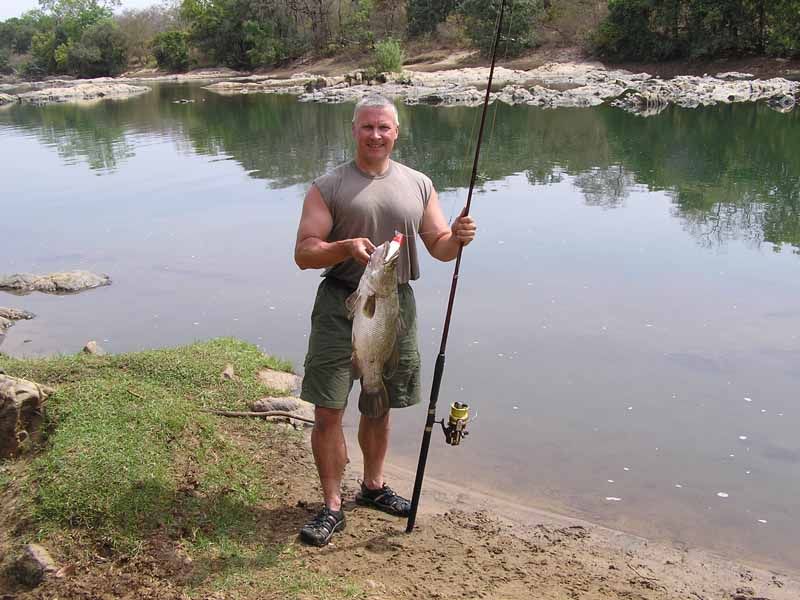 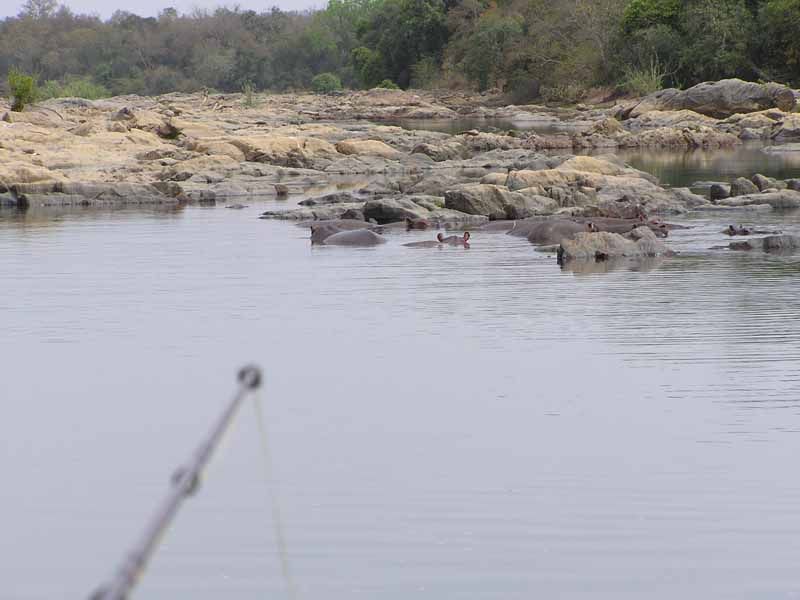 I call this masterpiece Guinea Fowl at Sunset:  Did you ever notice how many African products have smiley faces on the packaging?  Used to call lion in, there is no baiting in Cameroon: 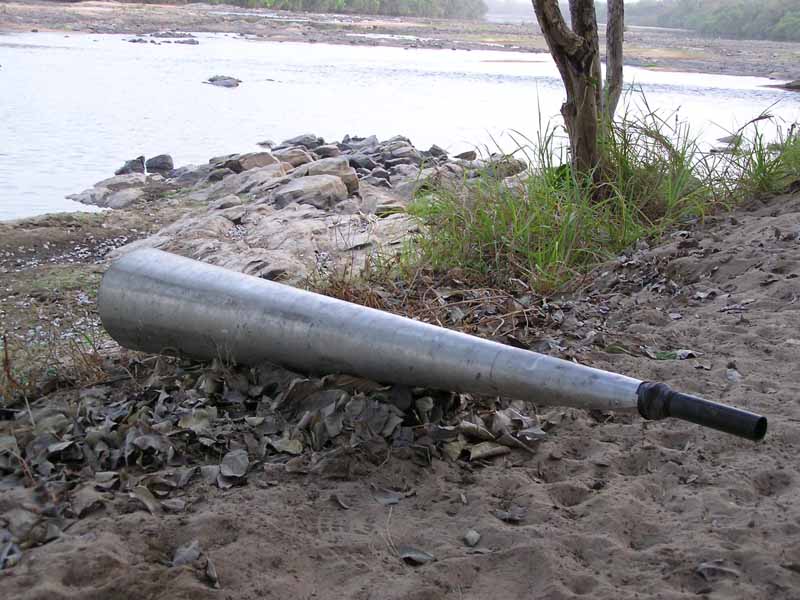 If you are hunting roan - you follow these: 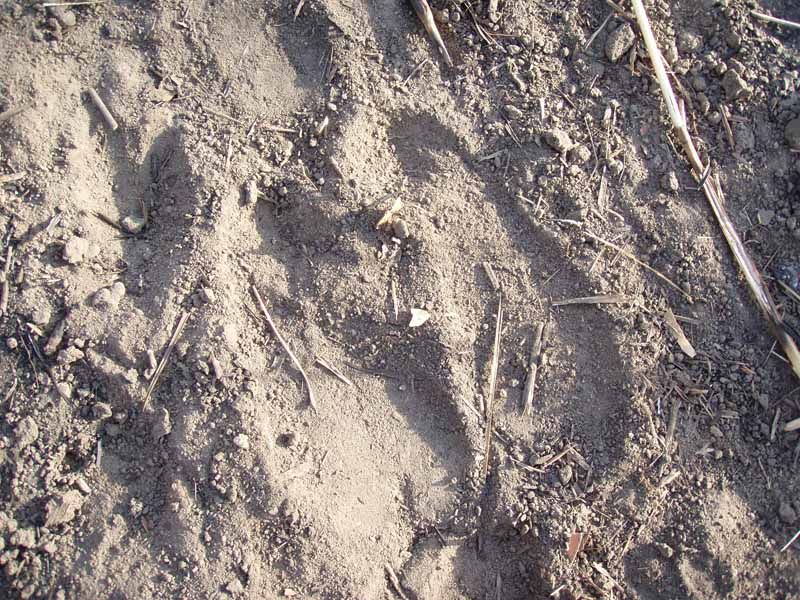 A grand old scrum cap bull shot by Deni:  A dugout canoe: 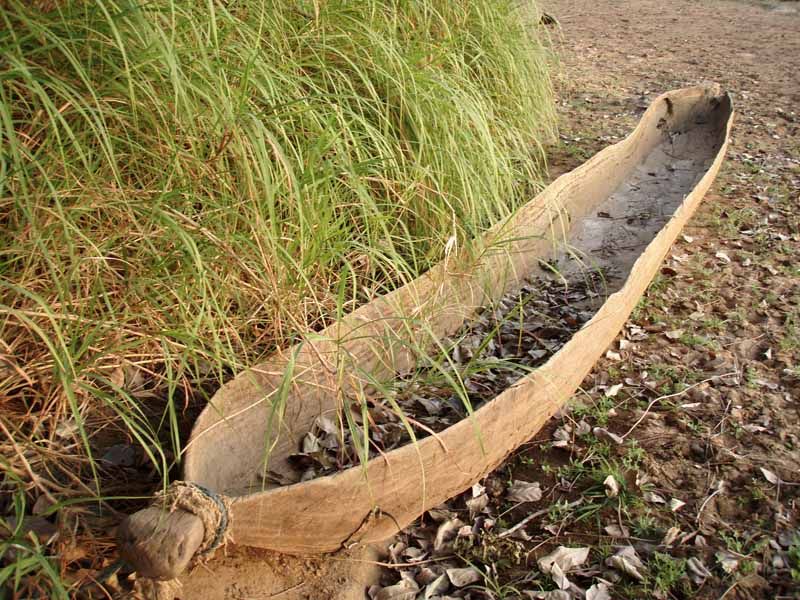 A fishing trap used during the rainy season: 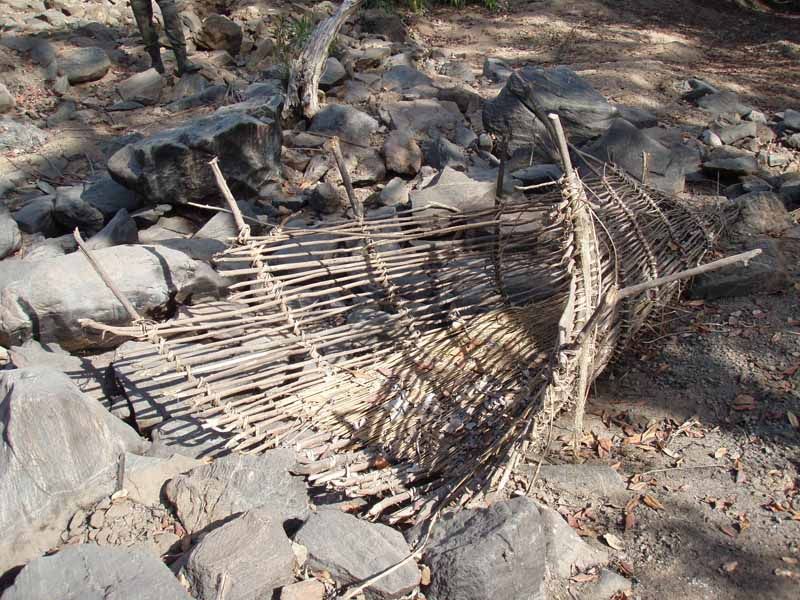 Thousands of kob hoof prints in the sand: 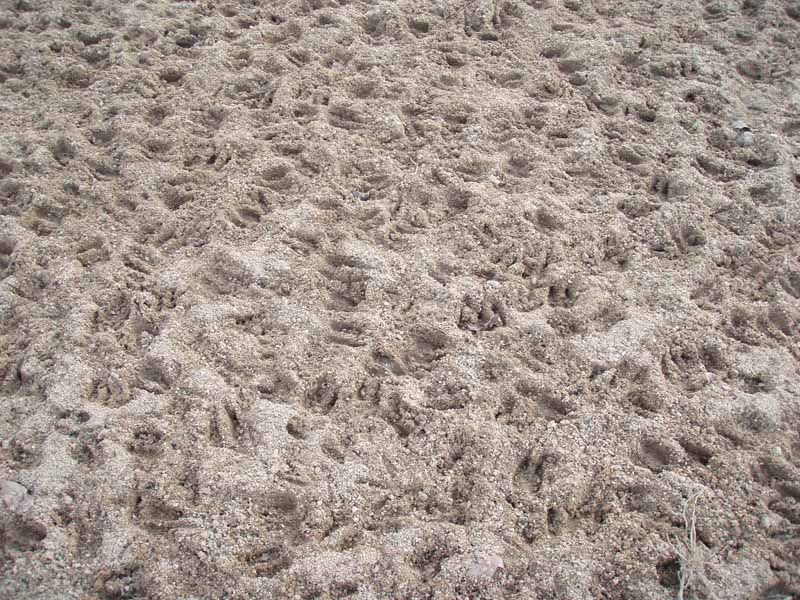 Sausage tree along the Faro: 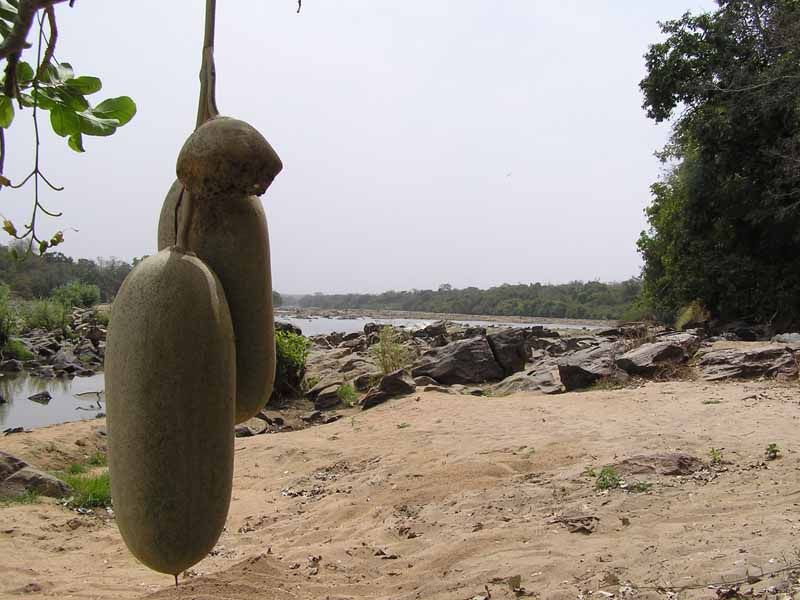 The same Hunting God statue as at the St Hubert Hotel: 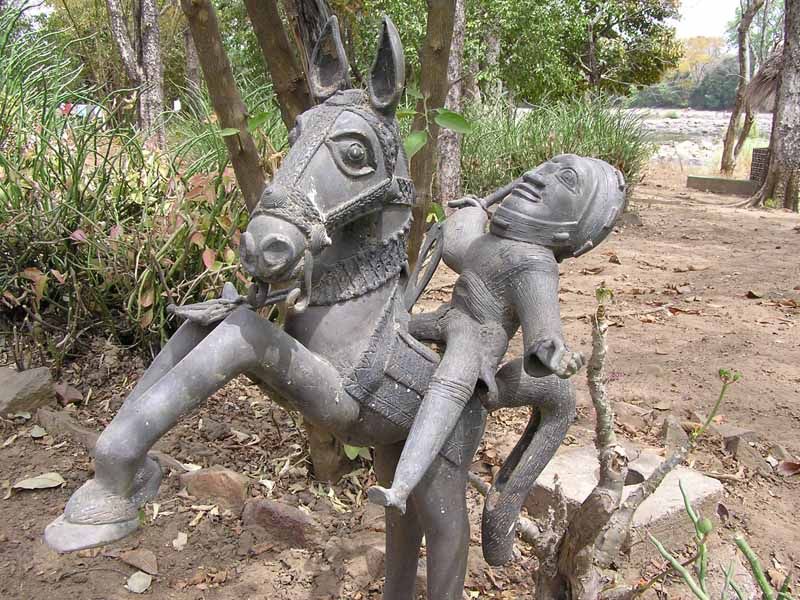 JOURNEY HOME Word came from Gee in Paris Thursday night that CamAir was indeed flying the next day, so on Friday I said my goodbys. Koulagna wanted to hear that I was coming back next year, and said with a smile that they would miss the candy each day. Pierre commented over breakfast "It is not too late to change you mind and stay another week", prompting Claire to yell at him in French, to which he replied "wee wee okay okay". I drove back with Jean, and took quite a few pictures along the way. We again stopped at his home, and I gave the children a small Ziploc of candy which I had set aside, and one of the three soccer balls and pump that I brought along from home. 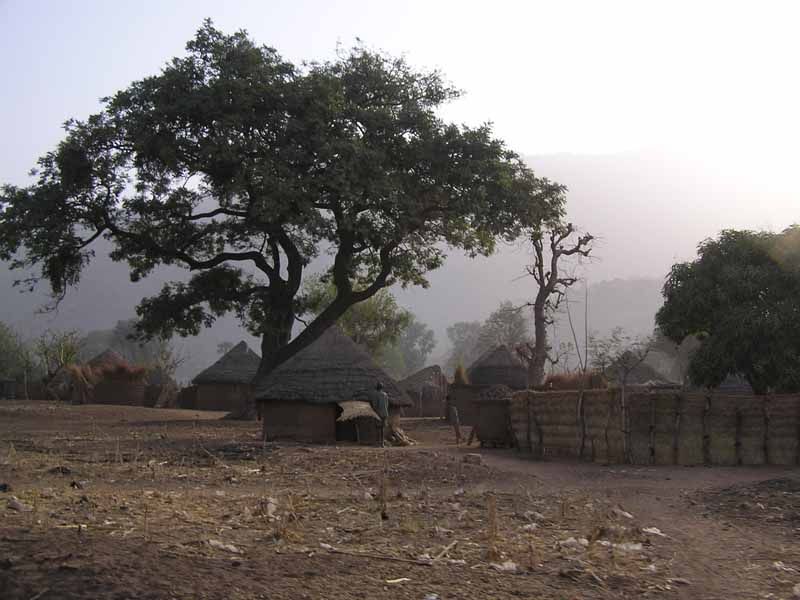 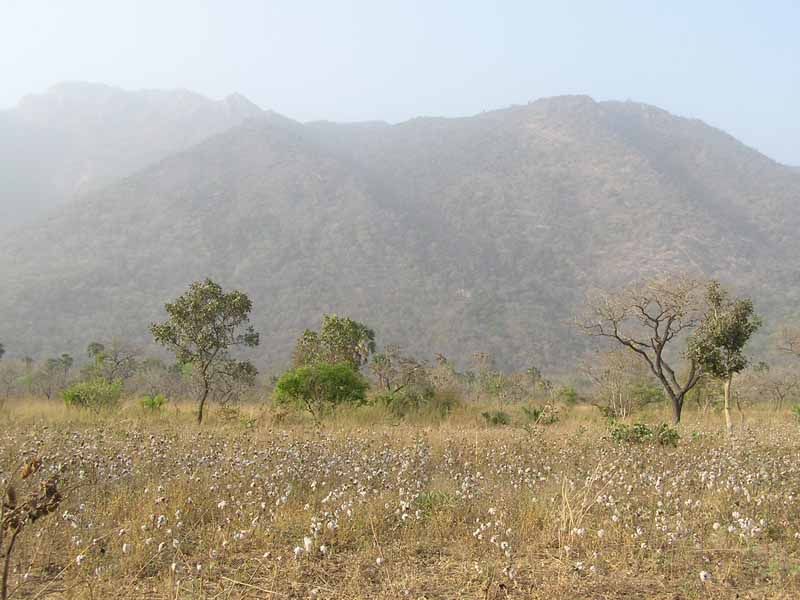 Jean (my driver) extended family outside of Garoua: 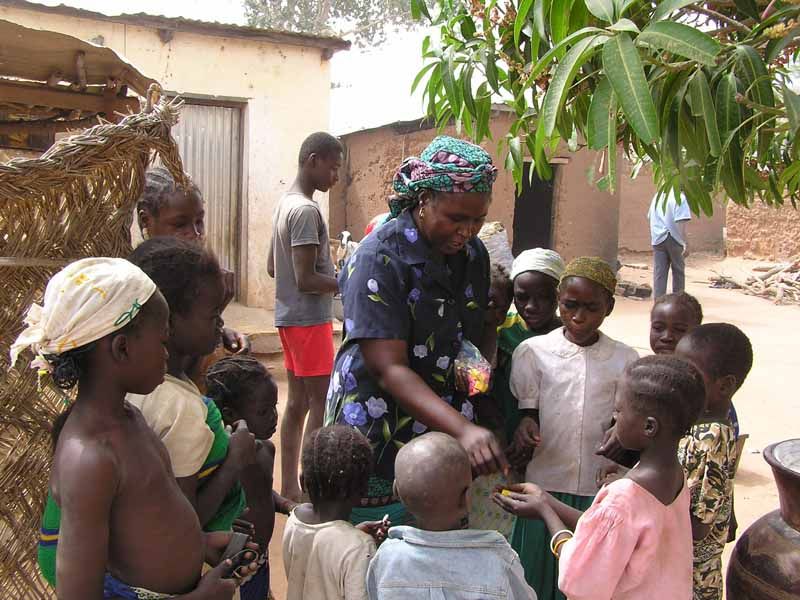 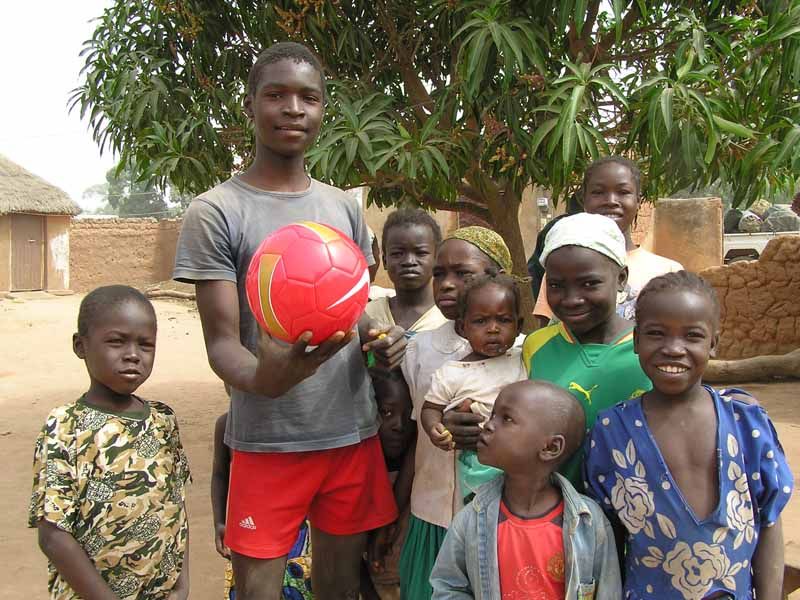 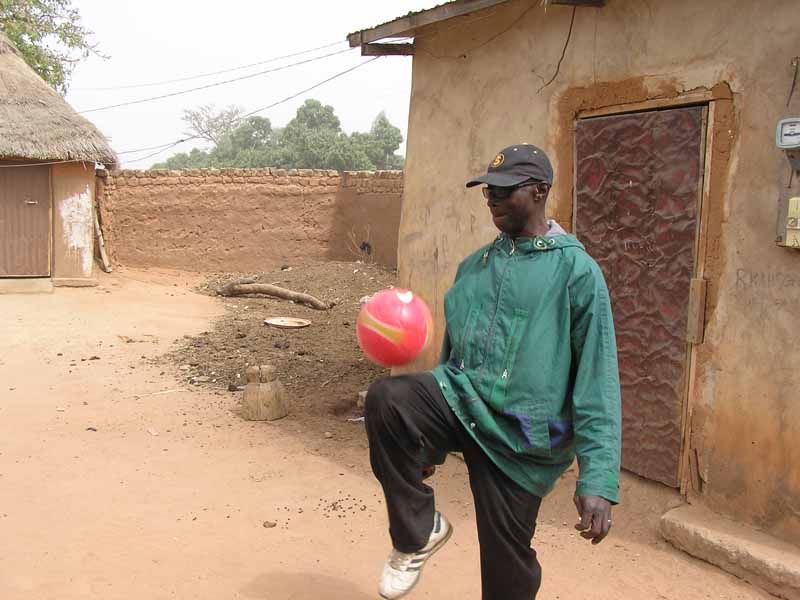 I hung out at the Saint Hubert hotel for a few hours, where I was met by Robert and a translator. The translator was a school teacher who cancelled class today. The CamAir flight was delayed, but took off around 6:30pm. We touched down in Yaounde before landing in Douala for a 3hr layover. The flight left for Paris around midnight, and arrived at Charles de Gaulle airport in time for me to make a 10:15am connecting flight to Dulles. Guy's mover-and-shaker in Garoua, Robert (left) & driver Jean (right) 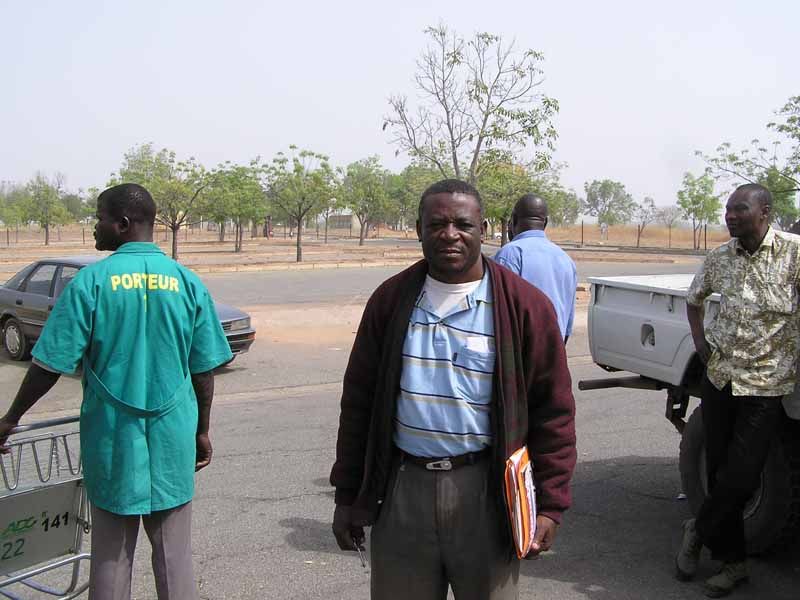 Cameroon school teacher & French-English translator provided by Guy 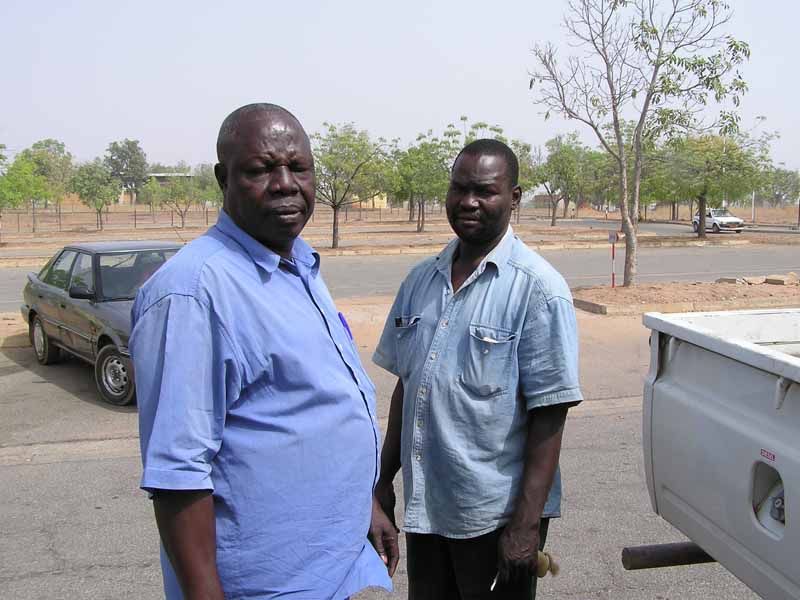 However, the adventure was not yet over as with Gate E in sight, two army personnel touting submachine guns stepped in front of me and motioned to halt. About 50 yards away there was a suspicious suitcase that the bomb squad blew up (turned out to contain clothes as I saw later while walking back past it). I had a 1st row seat, but the 45min waylay caused me to arrive at the Delta counter 10 minutes past last boarding and the gate closed. I paid the $225 change of ticket charge, and spent the next 4hrs in the airport awaiting the 4:30pm flight. It was a long flight back, I was over the wing (as I request as I get queasy in the back) but wedged in a middle seat. To me, it felt no different then the SAA arrangement I was on last March, and one must accept that the plane ride, especially home, is going to be miserable regardless of the airlines or airplane. Thankfully, I had one Ambien left and it took the edge off. I walked in the door at my home some 42 hours after leaving camp. It was a lot of travel, but a week later to the day, it is already a distant blur and I am ready to go again! COMPARING FRENCH AFRICA TO EASTERN & SOUTHERN AFRICA Travel and language aside, there was little difference between this hunt and my prior experiences in Eastern and Southern Africa. As mentioned previously, Cameroon is north of the equator and therefore the night sky is the same as in Europe and the US (the Northern Hemisphere). Our camp did not have a fire pit, and when I asked Pierre he said that in his experience throughout Central and Western Africa, this was common. The structures were permanent rondavels, versus the classic East African tents, but not that different from others that I have seen and stayed in elsewhere. I would imagine the rondavels through Western and Central Africa look much the same. Much of the camp environment (dining, foods, drinks including a fondness for wine) are dictated by typical French customs and expectations (remember that 90%+ of Gee's hunters are French). Every now and then I would verbalize a specific observation to Pierre and compare it to my experience elsewhere, to which he would normally reply that was the "English" and not the French way (Pierre had a farm in Zim for 7 years before losing it in 2001, and has spent most of his interesting life with Claire in various parts of Central and Western Africa). I hunted with a German in Namibia twice, and his camp had a German flair to it. There I shared camp with a German couple who spoke a little English, but most of the conversation around the table was in German. In both experiences, the cultural variations from what I am accustomed to added to the uniqueness and enjoyment of the trip. And I finally learned how to eat using my fork and my knife instead of my fingers! One difference which may or may not be typical for the area, is that we did not pack a cool box for the truck. Typically around 9-10am there is break in the action and the PH breaks out the cooler with light snacks, drinks, etc noting that most prefer to eat light breakfasts. I had brought along Clif and protein bars, and these gave me the mid-morning energy boost that I needed. All over Africa during the hot months, it is common to head back to the camp around 1 to relax and rest until the evening hunt...although most of my days seem to be spent in the field. The PH makes the call based on a number of factors, including location, the urgency based on remaining days, and how the hunter is holding up. On this trip, although I suggested it, we did not remain in the field and came back each day to eat and regroup. I can't help it, I like the "hardcore" hunts most. A few additional observations... There was no Game Scout required, nor did we need to stop in the office before/after the hunt. This was nice as there was no worry if we would get a "good" Scout or not, if he would be of assistance or burden - or if he would accidentally shoot one of us in the back of the head with his AK-47. There are no license fees that need to be purchased ahead of time, just trophy fees for game lost or wounded. However, the Big Game license does have restrictions that limit the number of animals that can be taken. Per the HUNT SUMMARY at the beginning of the report, one can shoot one animal from each Group A and Group B, and four from Group C. It is still up to the operator to determine availability, and they do work off of a quota system assigned to them. One can purchase multiple Big Game licenses, or a Big Game and a Small Game license providing that there is quota available, with any additional hunt costs to be worked out with the operator. Suggested staff tips were less then I expected, $600 Euro (~$900 USD), which is not cheap but this is a high-priced hunt for one of the world's premier trophies, and it was a large camp. I had a driver and 90% of the time three trackers allocated to me, even for the nightly walks in the Bakos. Considering what the staff expected on my hunt in Masailand, this was quite a bargain, and without doubt due to the fact that the "rich Americans" (as most Africans think) have not distorted their expectations. Lastly, the distribution of the tips was simple, it was a line item on the final bill. In the past I enjoyed handing out the tips directly to the guys as done by some operators, but with increasing expectations and mouths to feed in camp - this gets out of hand and is more stress then I want to deal with at the end of the hunt. I want to fondly remember all the good things and get ramped up for my trip home...not worry if I should give the 2nd Assistant to the Chief Water Boiler $20 or $30 dollars so that he does not get sour. In the field, it was nearly identical to my experiences in South/Eastern Africa, and any difference could be traced to the uniqueness of the PH/trackers, and the methods used to hunt LDE in this particular area. The only unique piece of gear required is a pair of shoes/boots with better support then is usually required for fast-paced game trail walking, to deal with the worm-mounds. Other then that, the Cameroon savannah is Real Africa - raw and wild! LOCAL LANGUAGE The dominant language in the northern providence is Fulfulde, pronounced "full-full-day", although all the staff and local people that I encountered spoke fluent French. For French-speaking hunters, this is quite nice as in Eastern or Southern Africa it is often difficult to communicate directly with the trackers. Of course, those of us speaking only English are out of luck, and must rely on non-verbal communications to get our points across. The camp guys all made an effort to learn a few simple English phrases, such as "good morning", and took great pride in using them. I too attempted to learn a few words in Fulfulde, which was well-received. A few common words/phrases that may be useful in camp or when hunting include: thank you => n'soko alright/okay => bodoum good morning => sanou finished => timi it is ok => djamna big => manga male => gorko old => detidjo drink/water => n'diam river => mayo When spotting animals from the truck, the trackers would use the local Fulfulde language to identify the game. While memorizing these is perhaps not necessary, it would be useful to be able to recognize them when spoken. A few of the simpler ones are as follows: eland => yamoussa roan => koba buffalo => bana kob => bada western bush duiker => amafourde red duiker => mbeoualaile hartebeest => kereoua oribi => djabare warthog => gadourou waterbuck => doumsa baboon => badi lion => mbarouga elephant => nyoa hippo => ngafou nile perch => pella tiger fish => gnaou guinea fowl =>djaoule FIREARMS, GEAR, GADGETS & OTHER ESSENTIALS Rifle & Ammunition - I opted to not use one of my rifles for this trip, but instead borrow the camp .375 H&H. One of the references who I had spoken to also did this, and said that it worked well, although next time he would do whatever it takes to bring his own. Despite this, navigating not only through Paris but Cameroon solo with a rifle did not interest me. The paperwork all appears to be pretty straightforward, and one would apply for the necessary permit at the same time as the VISA via the Cameroon Embassy. France should be no problem, and getting into Cameroon appears to be simple enough especially with the help of the people on the ground. The headache would come in if there were any issues with the flights, and/or if one finds themselves alone and unable to speak French. Too, the hassle factor of flying with guns is getting a bit much for me, and I am pretty carefree when traveling with just a carry-on and a piece of luggage or two. I believe we all will be renting/borrowing rifles at some point in the future for at least some of the countries that we hunt, as gun and ammunition restrictions become more restrictive and uncertain. For those interested, the rifle was a Steyr Mannlicher .375 H&H with a set trigger (that I did not use) and a Schmidt & Bender set (taped) at 5x. It was extremely accurate, but I could have used a bit more scope (magnification) on the longer shots. Ammunition was 300 grain factory Norma, and performed very well. The single recovered bullet (their Oryx I believe) looked much like an A-Frame, nice mushroom and a slightly compressed shank. For the Red Flanked Duiker and the Guinea Fowl I used a .22 Mag with an excellent Schmidt & Bender 1.5-6x scope and Winchester Hollow Nose Soft Point ammunition. Lowa Renegade GTX Boot - This is the first time I ever used a leather (abeit very lightweight) boot in Africa, but they suited the requirements remarkably well. I had no problems whatsoever with the "worm mounds", and they worked fine when fast walking game trails, plodding through sandy river beds and beaches, sneaking along crunchy forest trails or jumping river rocks. The Gore-Tex was nice when fishing or crossing murky water holes. Despite the 80-100 degree heat, my feet managed to stay dry, due in part to the Smartwool Light Hiker socks. The leather took a beating, but I will trade this any day for zero blisters and no overturned ankles on the dreaded worm mounds. Keen Newport H2 Sandals - These were great around camp and when fishing. Columbia Sportswear Cascade Creek Water Shorts - These all in one ("commando") shorts were great, durable, light and remained fresh throughout the trip. Forget heavy, restrictive cotton shorts, these are the bomb. Long Grass Outfitter Shirts - Check out the short sleeve Safari Weight shirts in Sage, and throw away all those stiff and uncomfortable Cabelas shirts! Long Grass Outfitter Shooting Sticks - Guy had these in camp, left as a gift by another American hunter who told me beforehand that he had done so. They are solid and easy to get setup on - superior to any of the PH's sticks that I have used in the past. Be prepared for your PH to begin angling for them as a gift after the first use. Petzel Tikka XP Headlamp - Compact, light, bright, 3 intensity levels + a super-bright, and long battery life. Forget the flashlight, go with the headlamp. Outdoor Research Sun Runner Cap in Khaki - I do not like caps, especially the Bubba Shrimp types. But this Runners cap from Outdoor Research worked great. It is light and breathable, form-fitting, adjustable, and provides 30 upf protection. The sun skirt is removable, and I kept this in the truck bag for when on the back seat to guard against midday sunburn. It also keeps the tsetse's off the back of your neck. Olympus Stylus 750 Compact Camera - I have taken this camera to Africa, Alberta, NWT, Hawaii and numerous backpacking and even a white water rafting trip. It takes great pictures, is impervious to water, withstands mild shocks/drops, boots up quickly with no beeps/buzzes, is easy to use, and has excellent battery life. The 3x zoom is not great but adequate. Perhaps most importantly, it is compact which means that I carry it and therefore have it available when a shot opportunity presents itself. It takes seconds and one hand to deploy, and I can take pictures with the camera held in my left hand and supported by my right hand holding my rifle over my shoulder. I also take a second larger (10x zoom) camera (also an Olympus which uses the same memory card, but easy to recharge AA batteries - get a auto charger and two sets of batteries) and use this when I have more time to setup. Get at least one new rechargeable battery [set] for each trip, as they lose their ability to take and hold charges over time. Thermrest Compression Pillow - Offering far more support then the plane pillow that have been who knows where, I used this on the plane rides and slept like a baby especially when in the window seat. Wash and dry in the dryer first for maximum loft. iPod Shuffle - You guys can say what you will, but I love my Shuffle and use it for backpacking and hiking when solo. It was a wonderful distraction when waiting in the airports, or when relaxing around camp and in need of a little bit of "home" to lift my spirits. Get a car charger adapter.  32oz Nalgene Bottle - Each morning and each afternoon I would fill this and keep it in the truck bag. Before any walk, I would drink one half of it as a buffer against dehydration. I found this easier then tracking down a tracker to get a swig, or dig in the cool box when everybody was ready to get moving. On warm weather tracking hunts in particular, it is essential for the trackers (porter) to carry more then enough water. Tell the PH - who if like Malo is a camel and does not need to drink - whatever you need to (such as you have a special medical condition and will go into convulsions without enough water), but make sure they don't leave the truck without plenty of H2O. I have had more then one stalk cancelled because the guys neglected to grab the backpack. Drink plenty of water each night and in the mornings - if nothing else peeing in the bush is fun. For the trip to Africa, fill the Nalgene bottle with hard candies. Also consider a hydration pack for truly hot weather hunts where there will be a lot of walking (like the Caprivi in October, or Hwange in March). Hard Candies - Take plenty, and consider it an investment in team building. I take extra Ziploc bags and each morning put some candy in. When the time is right (blown stalk, long walk, missed shot - or to celebrate a kill), I give the bag to the head tracker who distributes the candies, and returns the Ziploc so that it can be refilled the next day. I tell them that if I find any of the wrappers around camp or on the trail, that's it for the candy! Jolly Ranchers are the best, fireballs are fun, but any candy will do. Just don't forget your PH. Clif Bars - These were essential on this hunt, as the breakfasts at 6am were light and we did not eat again until sometimes 2-3pm. Before each walk, I would put a Cliff (or two) in my pocket and nibble on them as we went along. Anybody who runs or cycles long distance, especially those among us who have "bonked", knows how valuable nutrition is during prolonged exercise. You have dropped weight and trained hard, prepared and practiced, spent lots of money to get to Africa - so do everything in your power to give yourself every possible edge. Not getting hammered the night before is a real good idea too!!! Obviously, I am not talking about truck safaris here. Thuraya Satellite Phone - I rented mine from Outfitter Satellite. Their credit application is a hassle, which even for repeat customers such as myself needs to be completed each and every time, but their prices are good and so far I have not had any problems with the equipment supplied. Compared to the Iridium, the Thuraya sounds like a cell phone with excellent quality and very little delay when speaking which causes both parties to talk over one another until they get in sync. However, the Thuraya does not work in the US (or southern Africa below the Zambezi), and leaving without the opportunity to test and set it up was a little worrisome. I got the new style, which is very small and compact. The battery life was not very impressive (get a car charger and a spare hi-cap battery) and it felt a bit flimsy, but it worked fine. The SMS messaging was a disappointment as compared to the Iridium's, I got one SMS message and that was it, and I could not figure out how to reply to an email address (versus another phone). This being said - for multiple reasons I would absolutely, positively, under no circumstance, travel to REMOTE Africa (or anywhere else remote for that matter) without a satellite phone.  CLOSING I have tried to provide a detailed and accurate account of the trip, from start to finish, without making it sound like an infomercial. But make no mistake, this was an INCREDIBLE hunt and experience. Everything about it was superb - the area, animals, people, food, camp, etc. I would not necessarily suggest Cameroon to a North American hunter with just a few safaris under their belt (I wouldn't talk you out of it either!), but for somebody who has hunted Southern/Eastern Africa, and is looking for a slightly different perspective and type of experience, it is an incredible destination. I do think that one is shortchanging themselves by focusing exclusively on the Lord Derby trophy though - as magnificent as it may be - as there is a lot of adventure and enjoyment to be had during the course of the entire journey. This said, my LDE ranks right up there with my trophy elephant bull. The only difference is that the elephant provides that extra bit of adrenalin rush that makes it addictive. I doubt that I will ever hunt LDE again, but I am certain that I will chase after more bull elephants. Thank you for sharing my adventure with me. If you have any questions that you would prefer to ask offline, or if I can be of any assistance planning your trip, send me a PM or email me using the address in my Profile. Thanks again, and good hunting! Bill | |||
|
| one of us |
+1 !!! Congratulations and very well written! | |||
|
| one of us |
Great report Bill, could you add a little more detail? Thanks, great read. Frank "I don't know what there is about buffalo that frightens me so.....He looks like he hates you personally. He looks like you owe him money." - Robert Ruark, Horn of the Hunter, 1953 NRA Life, SAF Life, CRPA Life, DRSS lite | |||
|
| one of us |
Bill, Heck of a report. Took me straight back to my hunt in Jan '07 on the Faro river with Faro West. A unique experience in a very wild part of Africa. Congrats on a great hunt and trophies hunted properly. Some folks refuse to walk on the worm mounds. I must admit I loved the AC and en suite bath with lots of hot water in our camp. Mark MARK H. YOUNG MARK'S EXCLUSIVE ADVENTURES 7094 Oakleigh Dr. Las Vegas, NV 89110 Office 702-848-1693 Cell, Whats App, Signal 307-250-1156 PREFERRED E-mail markttc@msn.com Website: myexclusiveadventures.com Skype: markhyhunter Check us out on https://www.facebook.com/pages...ures/627027353990716 | |||
|
| One of Us |
Thank you for taking the time to post such a complete report. This is my dream hunt. I really enjoyed reading it and your trophies are great. Congratulations. | |||
|
| one of us |
I've been waiting for this report since before Christmas! I have to say that this is your best report yet Bill and I have read all of them. It probably took 30 minutes to digest it but I'm thinking about printing out a hard copy. It's that good. The French dynamic would be an interesting part of the hunt. I would worry about that initially but it sounds like you made the most of it. Clearly, the PH and staff hit it off well with you. That's one of the most important parts of the hunt to me. I found it interesting to read your comparisons and knowing some of what you speak of Some of the report made me smile..."A fresh dropping will be moist and somewhat gooey/slimy on the outside, and taste like chicken." Also, I really liked the photos of the kids (especially the one with the stuffed lion). I know why many of the camps do NOT have the staffs' families there but I envy your experience. That is something I would like to encounter as well. I'll end my comments by saying there is no need to apologize Bill for your style of hunting, reporting, "fraternizing", etc. Personally, I think your hunt reports are THE best on AR as to scope and depth of the experience and the above mentioned details are what make them so interesting to me and many others. The animals you took were very interesting but the real value is found elsewhere in this report. _______________________________  | |||
|
| one of us |
Very informative and interesting. Thank you. ALLEN W. JOHNSON - DRSS Into my heart on air that kills From yon far country blows: What are those blue remembered hills, What spires, what farms are those? That is the land of lost content, I see it shining plain, The happy highways where I went And cannot come again. A. E. Housman | |||
|
one of us |
Great job Bill, congratulations. Thanks for sharing, Kyler | |||
|
| One of Us |
Bill, Great read. Maybe one day you can put together a book of your exploits. I like how getting in shape for your hunts is important to you. It is for me as well. Seems as though you had some reservations about going to Cameroon to start with. Logistically it seems to be somewhat of a cluster b/c you don't know what the day to day airlines schedule/maintenance capability is going to be. Do you plan to go back for Bongo or do you have no deep desire for one? Congrats on a really successful hunt. | |||
|
one of us |
Another outstanding report from an excellent hunt! ------------------------------- Some Pictures from Namibia Some Pictures from Zimbabwe An Elephant Story | |||
|
| One of Us |
What an adventure, congratulations on your fine trophys! Thanks for the fantasic report. | |||
|
| One of Us |
Great report Bill. Now that you have whetted our appetite with the short story version, I am looking forward to the expanded version. Nicely done, and very interesting. Mike | |||
|
| One of Us |
Bill, Great detailed report as usual!!! Thanks!! Doug | |||
|
| One of Us |
Wow! Outstanding report, beautiful pictures and a wonderful hunt. Reading your report was a treat. Congratulations on your LDE, Buff and huge Kob. Soli Deo Gloria | |||
|
| One of Us |
Great report & an excellent hunt. | |||
|
One of Us |
| |||
|
| One of Us |
Outstanding & enjoyable report. | |||
|
| one of us |
Seems you had a great hunt and you had written in th forum one of the best report ever. mario | |||
|
| one of us |
Wonderful report and a true trophy Derby! Now you just have to do a bongo!!! They are just made to be in the same trophy room together. Mike | |||
|
| One of Us |
Very indepth report. Thanks. | |||
|
| One of Us |
Fantastic! Congratulations on a stellar hunt! | |||
|
| One of Us |
Great reading report Bill, sounds like you had a true adventure, I hope I can report half as much from my up coming Nam/Zim hunt this May/June 2008. | |||
|
| One of Us |
Great report, Bill! Congrats on some excellent trophies. | |||
|
| One of Us |
Excellent report Bill Regards, Chris Troskie Tel. +27 82 859-0771 email. chris@ct-safaris.com Sabrisa Ranch Ellisras RSA www.ct-safaris.com https://youtu.be/4usXceRdkH4 | |||
|
| One of Us |
Now that was an adventure! Great report, I always enjoy reading them especially with all of the attention to detail. Is there a book in your future? ~Ann 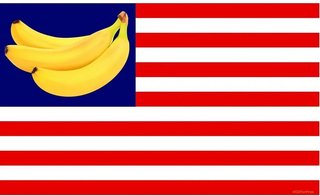 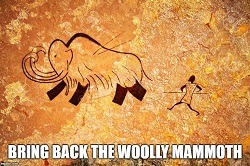 | |||
|
| one of us |
Excellent and thanks so much for sharing your adventures. | |||
|
one of us |
A fantastic report, worth being published. Very lively, one feels just like on your side and all the ambiance is thoroughly depicted. This is what should be a report. Most of the people insist on handloads, on the gun and the range, what is great but mainly linked to what everybody can perform home. The daily ambiance of the hunt and the description of the place, the people, the animals, game or not, the scents and the taste of food is far more informative and sure tremendously please those who haven’t share such adventures. In fact a very altruistic article. My mother will be very cross when seeing, JB, his beloved son, so much sunburnt and not exactly looking like his parents.  I suppose this JB’s name is Jean Ba (for Jean Baptiste). For Your first strike in this country, you cropped only trophies, congratulations. Could be back luck because it’ll refrain You from coming back in Cameroun. Thanks for so vividly sharing. J B de Runz Be careful when blindly following the masses ... generally the "m" is silent | |||
|
| One of Us |
Bill, thank you for a great hunt report. I'm always glad to learn that a hunt met expectations, especially a hunt where the expectations were probably pretty high. By the way, the mushroom mounds are made by termites. I don't know why the mushroom shape but I was once told that the rainy season (and if you've ever been in a rainstorm in Northern Cameroon then you will know what is meant) and the violence of the pounding rains round off the tops of the mounds. _________________________________ AR, where the hopeless, hysterical hypochondriacs of history become the nattering nabobs of negativisim. | |||
|
| One of Us |
Thanks, Bill, for your excellent report. It was an engrossing and enjoyable read on this rainy President's day morning. You are a true ambassador for our sport and set a high standard for us all. Congratulations! Mike Wilderness is my cathedral, and hunting is my prayer. | |||
|
| One of Us |
No Bill, thank you. And also thanks for the advice on the Sun Runner Cap. I'll check it out. "I envy not him that eats better meat than I do; nor him that is richer, or that wears better clothes than I do; I envy him, and him only, that kills bigger deer than I do." Izaak Walton (modified) | |||
|
One of Us |
Great hunt Bill/ Excelent Report!!!! | |||
|
| one of us |
Bill, Spectacular report especially hunting trophies that are so unique and the chance to learn more about another African country. You set another standard, thanks for the great read. Paul "Diligentia - Vis - Celeritas" NRA Benefactor Member Member DRSS | |||
|
| one of us |
Bill, As usual your report was stellar, both in-depth and entertaining. Excellent trophies... both the LDE and the Kob were super and congrats to on the bushbuck and r-f duiker as I know how tough and clever they can be... French Africa is a unique experience and I agree to working very hard to prove the "ugly American" stereotype doesn't apply to the majority of US hunters. In the end it was great to know that all true hunters speak the same language and share the same respect for our sport wherever we call home! On the plains of hesitation lie the bleached bones of ten thousand, who on the dawn of victory lay down their weary heads resting, and there resting, died. If you can talk with crowds and keep your virtue, Or walk with Kings - nor lose the common touch... Yours is the Earth and everything that's in it, And - which is more - you'll be a Man, my son! - Rudyard Kipling Life grows grim without senseless indulgence. | |||
|
| one of us |
You are a good man, Bill. Your appreciation of the kids speaks well for you! You may even have managed to lighten up the US-Franco relationship a bit... Highly enjoyable! - mike ********************* The rifle is a noble weapon... It entices its bearer into primeval forests, into mountains and deserts untenanted by man. - Horace Kephart | |||
|
| One of Us |
This has to be the #1 report of the year! Well done Bill. Congrats on your hunt and trophies. David Gray Ghost Hunting Safaris http://grayghostsafaris.com Phone: 615-860-4333 Email: hunts@grayghostsafaris.com NRA Benefactor DSC Professional Member SCI Member RMEF Life Member NWTF Guardian Life Sponsor NAHC Life Member Rowland Ward - SCI Scorer Took the wife the Eastern Cape for her first hunt: http://forums.accuratereloadin...6321043/m/6881000262 Hunting in the Stormberg, Winterberg and Hankey Mountains of the Eastern Cape 2018 http://forums.accuratereloadin...6321043/m/4801073142 Hunting the Eastern Cape, RSA May 22nd - June 15th 2007 http://forums.accuratereloadin...=810104007#810104007 16 Days in Zimbabwe: Leopard, plains game, fowl and more: http://forums.accuratereloadin...=212108409#212108409 Natal: Rhino, Croc, Nyala, Bushbuck and more http://forums.accuratereloadin...6321043/m/6341092311 Recent hunt in the Eastern Cape, August 2010: Pics added http://forums.accuratereloadin...261039941#9261039941 10 days in the Stormberg Mountains http://forums.accuratereloadin...6321043/m/7781081322 Back in the Stormberg Mountains with friends: May-June 2017 http://forums.accuratereloadin...6321043/m/6001078232 "Peace is that brief glorious moment in history when everybody stands around reloading" - Thomas Jefferson Every morning the Zebra wakes up knowing it must outrun the fastest Lion if it wants to stay alive. Every morning the Lion wakes up knowing it must outrun the slowest Zebra or it will starve. It makes no difference if you are a Zebra or a Lion; when the Sun comes up in Africa, you must wake up running...... "If you're being chased by a Lion, you don't have to be faster than the Lion, you just have to be faster than the person next to you." | |||
|
One of Us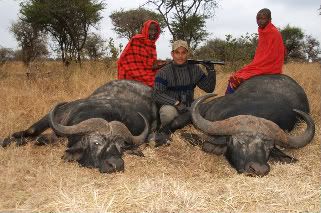 |
Excellent and very informative report, thanks for sharing. Ahmed Sultan | |||
|
| One of Us |
Your love and respect for our sport shows in your report. Outstanding. Perception is reality regardless the truth! Stupid people should not breed DRSS NRA Life Member Owner of USOC Adventure TV | |||
|
| one of us |
What a marvellous report! Thanks for taking time and sharing this with us.. Great pics, story and trophies! Hope I manage to copy this hunt in Cameroon sometime! Anders Hunting and fishing DVDs from Mossing & Stubberud Media: www.jaktogfiskedvd.no ..and my blog at: http://andersmossing.blogspot.com | |||
|
| Powered by Social Strata | Page 1 2 |
| Please Wait. Your request is being processed... |
|
 The Accurate Reloading Forums
The Accurate Reloading Forums  THE ACCURATE RELOADING.COM FORUMS
THE ACCURATE RELOADING.COM FORUMS  Hunting
Hunting  Hunting Reports - Africa
Hunting Reports - Africa  Cameroon Adventure 2008 - Lord Derby Eland & Buffalo
Cameroon Adventure 2008 - Lord Derby Eland & Buffalo

Visit our on-line store for AR Memorabilia

